#octavo x reader
Explore tagged Tumblr posts
Note
This is so embarrassing but can i request a Johan Liebert x Female reader that's stressed out from like their job or college stuff idkidk but take ur time!!
This is in spanish & english cuz yep! 👀
°°°°°°°°°°°°°°°°°°
Tu trabajo como profesora era algo que amabas pero que te estresaba en ocasiones. Los adolescentes de octavo grado eran un combustible de estrés para ti; tan caótico lidiar con un hervidero de chicos rebeldes, irresponsables y desconsiderados contigo y tus colegas.
Tal vez los llevarías de excursión a las calles de Detroit para que contemplen a los drogadictos y vagabundos del lugar. Dirás algo como "si no hacen sus tareas van a terminar peor que estas personas, muchachos".
Sí, eres algo cruel cuando te lo propones.
Al igual que Johan.
Tu novio con gusto escuchó tu letanía acerca de cómo la impresora del colegio se había atrofiado por falta de mantenimiento. Mientras preparaba un té de naranja con hierbabuena para ambos.
Después, le contaste sobre como Earving (marsupial del instituto) se escapó de su jaula y orinó los chícharos de la cafetería. Estás pensando en adoptar a ese travieso animal.
Liebert se rió ante tu anécdota. No es tan fan de los animales, pero no se opuso a la idea.
Trazó un masaje sobre tus hombros con el propósito de que estuvieras relajada. Tu novio siempre daba en el centro de la diana cuando se trataba de hacerte sentir mejor.
Hoy, no fue la excepción a la regla. Mira, incluso fue a comprarte tu pastel favorito.
Tal vez convenga estresarte más seguido. ¿No?
>>>>>>>>>>>>>>>>>>>
English version
Your job as a teacher was something you loved but was stressful at times. Eighth grade teenagers were stress fuel for you; so chaotic dealing with a swarm of unruly, irresponsible and inconsiderate kids with you and your colleagues.
Maybe you'd take them on a hike on the streets of Detroit to see the local drug addicts and homeless people. You'll say something like "if you don't do your homework you're going to end up worse than these people, guys."
Yes, you are somewhat cruel when you put your mind to it.
Like Johan.
Your boyfriend was happy to listen to your complaint about how the school printer had atrophied from lack of maintenance. While preparing an orange tea with mint for you to.
Later, you told him about how Earving (high school marsupial) broke out of his cage and urinated on the peas in the cafeteria. You are thinking of adopting that mischievous animal.
Liebert laughed at your anecdote. He's not that big of an animal fan, but he wasn't opposed to the idea.
He traced a massage on your shoulders with the purpose that you were relaxed. Your boyfriend always hit the bull's-eye when it came to making you feel better.
Today was no exception to the rule. Look, he even went to buy you your favorite cake.
It may be worth stressing out more often. No?
_______________________
I hope you like it!
27 notes
·
View notes
Text
Worth Her While

When the Winchester brothers ask Rowena MacLeod to help them steal an amulet, she agrees -- as long as she can make sure that the case is worth her while.
Sam Winchester x Rowena MacLeod (established relationship), Dean Winchester
5800 words
Written for @spnfanficpond Alpha Reader Program, working with @mrswhozeewhatsis. AN at the end.

Every eye was trained on Rowena as she twirled from one Winchester to another across the dance floor. Dean’s warm palm lingered over her upper back longer than was necessary, fingers tracing the edge of her dress just below her shoulder blades. To everyone else, it would look like he was getting handsy with her. But she knew he was tucking the amulet down inside the top of her black cocktail dress.
Just like they had planned.

"Hello, boys," Rowena cooed when she picked up the phone. Sam's name was on the screen, but she knew Dean would be close by.
"So, get this," Sam said eagerly. "We've wanted to get our hands on the Aerie Amulet since we found mention of it in Black Grimoire we got from the Loughlins, right? It’s rumored to be a powerful tool against the forces of darkness, but no one has seen it in decades. Well, it turns out it’s been tucked securely away in a museum storage vault with the rest of the Carter Collection."
Rowena hummed noncommittally. Sam was always digging into the lore and looking for specific pieces of arcana. The two of them shared a fascination with occult objects but she didn't always keep track of every latest object of his interest.
Sam continued, speaking faster in his excitement. She found his enthusiasm so charming. "This weekend, the Carter Collection is going on display at the Brandt Museum for the 100th anniversary of Carter's death. We have a chance to get our hands on the amulet."
Sam paused, the phone line practically crackling with anticipation. "We were hoping you could help us."
Ahhhh. There it was. "You two are perfectly capable of making fake IDs and getting in anywhere. How am I involved?"
“See, there’s a reception to celebrate the display and we were hoping you could help us provide --”
"Distraction!" Dean cut off his brother. "You get dressed up all pretty, go in on Sammy's arm, everybody's looking at you, and I make off with the amulet!"
"Awww, you think I'm pretty?" She didn’t have to be there to know the way he would be blushing across his freckled cheeks all the way to his ears.
Rowena heard Sam chuckle once before he tried to stifle it. She could picture his face in her mind, and the thought made her smile. She knew the look he must be wearing --adored it, really-- the way he set his jaw, but the pop of his dimples always gave him away.
"Let me see what my calendar looks like," she answered. She was quite intrigued by what they were proposing but didn't want to seem too interested too early. “Of course, I’d come anywhere if it meant getting to see Sammy looking all rich and handsome.” She smirked, knowing both boys would be blushing now, for very different reasons. “I’ll let you know.” She blew a kiss towards the phone receiver and then hung up before she could hear Dean start teasing his younger brother.
Setting her phone down, she opened her laptop. Sam wasn't the only one who could research. Mention of the Carter Collection had sparked something in her memories.
There was an octavo, a set of folded pages, rumored to be from an ancient grimoire. Scholars considered it important from a linguistic perspective, but she was interested in it for her own magic.
It surely would not be that difficult to convince the Winchesters that they needed the pages in order to properly use the amulet. This caper could turn out to benefit her quite nicely.

The reception at the museum was scheduled for a Saturday evening. Rowena thought if she were going to go, she wanted to make the trip well worth her while. Not only with the octavo, but with a little getaway.
She saw no reason to haul her “exquisite ass” -as Dean once so aptly described it- the whole way to the Men of Letters bunker in Kansas, so she insisted the Winchester brothers book a hotel. Not one of their usual roadside dumps, either. Someplace with at least 3 stars and room service.
“I’ve changed my mind. Do we have to bring her?” Dean fussed over the phone.
“We need her help to authenticate the Aerie Amulet!” Sam answered. She knew without seeing him how he would roll his eyes.
“Plus, I specifically recall you needed me to look pretty,” Rowena reminded them with a musical lilt to her tone. It was so much fun to wind them up, both of them. While Dean was the one who had said it, she knew Sam would appreciate it so much more.
Her outfit was distractingly gorgeous, with a surprise just for him. She had picked out a black gown with a structured fitted bodice and sweetheart neckline that would lift her cleavage and frame her slender waist. The soft straps sat wide on her freckled shoulders, framing the angle of her collarbone right where Sam loved to kiss. The skirt fell all the way to her ankles, heavy satin hugging her legs under a layer of soft chiffon. It flared out at the hem and whispered delightfully when she walked.
The dress would draw everyone’s eye, and she loved it. Too long had passed since her last chance to get so dressed up and glamorous. But the best part was hidden, for only Sam to see - silky lace panties with ribbons laced over the cleft of her ass. Just thinking about his reaction had her pressing her thighs together.

Rowena checked into the hotel before they did. She wanted to take her time on her hair and makeup. That way, when the boys got there, she was strategically half-dressed. She greeted them at the door, the wide straps of her little black dress falling off her creamy shoulders. She smirked as Dean fled into the next room over.
“Oh, Samuel, can you help me fasten up the back of my dress? I can’t reach the end of the zipper.” She batted her eyelashes and widened her green cat eyes in her best imitation of innocence.
He pursed his lips. He knew better than to ever believe she was without motive but followed her into her room.
She turned to face the mirror, leaning forward to adjust the rise of her breasts in the closely fitted top. As she bent over, the zipper fell open well below the waist of her dress, giving Sam a good look at her panties - the criss-cross ribbon, the dimples at the small of her back. She watched in the mirror as his eyes widened and he fumbled for the zipper of her dress. She smirked. Her plans were coming together nicely.

Just before sunset, as the day began to cool, Dean pulled the Impala around to the front door of the hotel. Sam opened the back for her before slipping into the front seat. Both of the brothers were dressed in perfectly fitted suits, white dress shirts immaculate. They could definitely pass for rich museum patrons.
Dean caught her gaze in the mirror and gave a teasing wolf-whistle. “Mighty fine-looking lady you got there, Sammy.”
Rowena scoffed, tossed her hair back off her throat, and opened her mouth for a sharp retort. But Sam spoke first.
“I don’t think I’ve ‘got’ Rowena,” he answered dryly. “She’s made it quite clear she’s a woman all her own. But she does look nice.” He turned to smile at her over his shoulder. She smirked and settled back against the seat.
“Will we get dinner first? I’m hungry.” Rowena changed the subject. She wasn’t usually one to care much about meals, but she did have a reputation of being high maintenance.
“There’s food at the reception, lots of it,” Dean said as he caught her gaze in the rear view mirror. “I’m sure there will be time for us to eat before the heist.”
“You would know.” Sam turned to his brother, his tone light and teasing. “I’ll bet you googled the caterer.”
“Look, there’s nothing wrong with knowing what I can expect to eat!” Dean’s retort was quick, but his tone was playful.
Rowena grinned. It was so rare that they got to have fun on a case, and she found it strangely gratifying to see them prepare for a mission that wouldn’t involve killing. So often everything they did was so serious and weighted, life or death situations.
She couldn’t remember ever working a case with them where they all got to dress up and enjoy a glamorous evening out. She was seeing a new side of the Winchesters, and she didn’t mind it one bit.

Dean pulled up at the entrance to the museum, dropping off Rowena and Sam before parking the Impala a few blocks away. She entered the reception on his arm as he handed their invitation to the security guards. They didn’t blink -- Sam had done a good job with the forgery.
Once inside she took a deep breath and looked around. A string quartet played softly in the far corner. Everyone was dressed up, the men in suits and the women in beautiful cocktail dresses and glamorous gowns. Tuxedoed waiters circulated with trays of canapes, delicious-looking little bites of food.
One entire wall was a tasting station for several types of tequila, featuring the premium brand, Number Juan. She preferred champagne to tequila but smiled in spite of herself.
That should make Dean happy.
People were chatting, mingling, and a few were even dancing. It seemed that few people were venturing away from the reception to view the exhibits. That would make her mission easier.
Someone approached with a tray of champagne flutes. Sam took two and handed one to her before raising his in a toast.
“To success!” he said softly.
“And to celebrating afterward,” she purred, enjoying the flush that spread over his cheeks.
His gaze was drawn away when Dean entered the room. His invitation was just as flawless as Sam’s, but something made security give him a once over. Probably his cocky attitude, Rowena thought, although she knew well that he had charmed himself out of worse situations. When he was at last admitted, she breathed a sigh of relief.
Sam greeted his brother with a barely perceptible nod. Dean tossed a wink in Rowena’s direction and headed straight for the raw bar: a long table of seafood arranged on ice. It looked expensive and delicious.
The noise of the party ebbed and swelled as more patrons entered. Everyone looked rich, and most seemed more interested in mingling than in the museum itself. Rowena and Sam took advantage of the crowd to sneak off and search for the objects of her desire. Luck was on their side.
The Aerie Amulet hung on display, lit by a single spotlight. The octavo was in the same room, on the wall, under a thick layer of plexiglass. It was even tinier than she expected, each page smaller than a playing card. A counterweight would take care of the amulet while the octavo could be easily accessed with a screwdriver. Between the two brothers, they carried enough tools to handle this easily. .
Sam moved carefully around the stand that held the amulet, inspecting it from all angles. In the dim room, the spotlight of the display caught on the angles of his face, highlighting him to an almost otherworldly beauty.
There were many things that drew her to Sam. His thirst for knowledge, as well as his attention to and care for ancient mysteries, was deeply attractive. But he was also one of the most beautiful people she had ever met. In this moment, she was deeply reminded of all the things that she loved about him. Desire surged up through her veins.
She sucked in a deep breath, turning away from him to the octavo. As she inspected the ancient grimoire pages from every angle, she felt a pair of strong hands circle her waist.
“You know, we’re all alone in here.” Sam’s chestnut curls brushed her cheek as he bent over to whisper in her ear. She leaned back into his arms, savoring the warmth of his body against hers.
This close, she inhaled the scent of his cologne, starch on his shirt and, underneath it, his clean sweat.
Finally, she spun in his grasp to face him. Even in heels, she had to tilt her face to look at him.
Sam’s hazel eyes sparkled with desire. “You look amazing tonight,” he murmured, his voice husky and almost hesitant. “This dress….” He traced her neckline from one shoulder to the other, over the swell of her breasts, his calloused fingers rough against her soft skin.
“You look quite dashing yourself,” she answered, winding the silk of his necktie around her fingers to tug him closer. Their lips met in a kiss that was soft at first, then grew more heated with pent-up longing. Sam’s hand slid over the satiny fabric of her dress, spanning the length of her back to hold her against him.
She let her hands slip up into his hair as she kissed him, painted nails grazing his scalp. He hummed in a way that she felt all the way to her core. Without thinking, she shimmied her body against his, trying to get closer, pressing in where he was already hard.
When her gaze met his again, she saw fire in his eyes, thin rings of green and gold around lust-blown pupils. His hands sank to her hips, tugging her up to grind against him.
She pulled back reluctantly. “We can’t,” she said with a meaningful glance towards the doorway. “Someone else could walk anytime. If we get caught, we lose any shot at what we came for.”
Sam nodded, his lips falling open, although no words came out. He seemed focused on trying to pull himself together. His shoulders rose and fell as his chest heaved with each deep breath.
Rowena smirked to herself. Not that she would ever admit it, but she loved him like this. There were few powers on earth she enjoyed as much as bringing the man she loved to his knees.
“Please --” The word was ragged.
Yes, she had him begging.
“Soon.” She reached up and caressed his cheek gently before pouting her lips and moving away slowly. She spun on her heel, taking a few steps with a deliberate sashay of her hips.
Sam caught up with her in two long strides. He took her hand and led her back in the direction of the light and noise spilling from the reception. On the way back, she passed a ladies’ room and ducked inside to touch up her lipstick.
He followed her, giving the room a sweeping glance before locking the door behind the two of them.
As she bent over to check her makeup in the mirror, he closed in, all but pinning her to the counter.
“What?” She gasped in delighted surprise. “What do you think you’re doing?”
“Just getting a little taste of what’s waiting for me later,” he answered, his lips soft against her ear. “If you’re going to tease me all night, you must expect that I’ll want to return the favor.”
Rowena hummed and pressed back against him. All her careful seduction was getting her exactly what she wanted. She took great delight in drawing out this domineering side of Sam, getting him all wound up and bossy like this. WIth her, he could be a whole different man than the nerdy younger brother most people saw.
While he spoke, he rucked up her skirt, long fingers gathering the dark fabric around her waist. One hand caressed the soft skin of her stomach and then lower, his touch like fire on her skin. His lips pressed a searing trail of kisses down the line of her neck.
When he passed the waistband of her panties, she gasped, arched her back, and widened her stance. He slid a foot between her heels to hold her open, and when his fingers found her slit, she whispered his name.
“Soaking wet for me, Ro, aren’t you?”
She nodded, breathless, as he began to touch her in the way she knew so well. She rocked her ass against him and his grip around her waist tightened, holding her close. She loved the way he made her feel, exposed and sheltered in his arms at the same time. When she was with him, she didn’t care about anything but him and all the things they could do together.
“Shhh,” he commanded her, low and firm. “What did you say about getting caught?”
She bit her lip to stifle the soft moans that she hadn’t known she was making and curled her fingers into his suited arm to hold on as an orgasm rippled through her.
Sam pulled his hands away slowly, making sure she could stand on her strappy heeled sandals. When she looked up at him in the mirror, he licked the taste of her slowly off his fingers. The sight of his hand and his mouth sent a shivery aftershock through her. He grinned, eyes glittering and dark.
Rowena’s painted lips curled up in a smug smile.
“You little witch!” he said, affection softening the words. Sam shook his head admiringly. “You always get exactly what you want.”
“Oh, yes,” she purred. “As will you, soon enough.”
She smoothed her dress down and took his offered arm as the two of them left the room.
“Hell,” a familiar voice said sharply. Dean was waiting for the two of them in the hall just outside the door. His eyes raked her over from head to toe. “You two are supposed to be providing a distraction. Not ducking into bathrooms doing, well, doing,” he sputtered, “whatever you were just doing in there.”
Before Sam could answer, Rowena spoke up. “If it’s a distraction you want, I’ve got this.” She lifted the fabric of her gown, breaking the flawless line of her skirt, leaving it just the tiniest bit disarrayed. She carefully tugged one strap of her dress down, so it fell just off the curve of her shoulder.
She turned to Sam and unknotted his tie with swift fingers, pulling it off and tucking it in the breast pocket of his jacket. Finally, she ran one hand through her hair. Her red curls fell in disordered glory around her face.
“Now, Dean,” her tone was clipped, “go. Get what we came for.”
When she stepped back into the room on Sam’s arm, heads turned. She heard the whispers of shame, not that she paid them any mind. Let them talk and be judgmental and jealous. No one else would have him in their bed tonight.
Sam led her to the area cleared for a dance floor. The string quartet was playing a soft, indistinguishable waltz and she swayed easily in his arms in time to the music. When she looked up at him, he smiled at her so gently that she felt warm all over.
He was so tall, so strong, and a skilled hunter. But when he was with her, he showed both a tenderness and an appetite for pleasure that she had never expected. He lavished attention on her and reveled in not only her physical beauty but also her mind and her own power.
In all her three hundred years, Rowena had never met a man who loved her like Sam. And, if she was honest, there probably was never anyone she had loved as much. She pressed closer and he tightened his embrace. For a long moment, her world shrank to just the two of them. Sadly, as much as she might like to pretend, this was a case.
He bent to brush his lips to hers and murmured so low only she could hear it, “Dean is back.”
She couldn’t hold back the triumphant smirk that crossed her face. Everything was going perfectly to plan. She would be leaving with exactly what she wanted -- an amulet for the Winchesters, grimoire pages for her, and Sam Winchester, once again, all hers.
She nodded as he lifted his arm and she twirled out, out to his fingertips - and straight into Dean’s waiting arms.
Rowena took his hand and felt a tiny packet in his palm. The octavo. She tucked it into her pocket next to her lipstick with a glancing motion. It took just a moment to fall into step together and then he was twirling her across the dance floor.
The music picked up tempo. To her surprise, Dean kept time with her every step.
“You know how to dance!” she exclaimed.
Dean gave her a half-quirked smile. “Let’s just say you’re not the first woman I’ve tangoed with.”
It was such a Dean answer, self-deprecation mixed with a little bit of mystery. Dancing with Sam had been intimate, but this was exciting. For just a moment, she forgot the plan, forgot everything except the enjoyment of dancing with a handsome man who knew how to move his body.
She felt his warm palm linger over her upper back longer than was necessary. To everyone else, it would look like he was getting handsy with her. But she knew, he was tucking the tiny silk pouch she had given him to hold the amulet down inside her snuggly fitted top.
Her eyes caught Sam’s and she nodded almost imperceptibly. In a few long strides, he was back on the dance floor, pulling Dean away from her.
“What do you think you’re doing, man?” Sam’s tone was frightening.
“Just having a good time, dancing with the lady!” Dean protested.
They shoved back and forth. Rowena stepped away, out of range. There was no question of distraction, now. The whole room was watching, waiters with their trays of hors d'oeuvres frozen in the air and musicians with their bows held silent over their strings.
Sam wound up and threw a calculated punch at Dean, who went sprawling backward, crashing into -- oh, shit. The raw bar. The table shuddered and tipped, and Dean fell to the floor in an avalanche of ice and seafood.
Sam stepped over to her, curled his arm around her waist in a possessive gesture, and led her towards the door. She glanced back at Dean and caught his wink.
As she watched, he picked up an oyster and slurped down the salty contents. He felt around for another and a lemon. There was a woman striding towards him, petite, with a black dress that hugged every curve.
“How dare you!” Her face was flushed beneath her freckles and her voice carried through the entire hall. “Do you know how much this cost me? I’ll sue you! I’ll end you.”
Security was right behind the catering manager, closing in on Dean. No one was watching the door, or Sam and Rowena, as the two of them made their escape. Outside, she hurried to keep up, taking two steps in her heels for every one of his long strides. They didn’t slow down until they had put a couple of blocks between them and the museum, turning the corner to where Baby was parked.
Sam opened her door before circling around the car and sliding behind the wheel. She collapsed on the leather bench seat, shaking with laughter. Sam looked at her, concern on his face, but her glee was contagious.
“Oh, my goddess,” Rowena finally managed. “That went far better than we could’ve even planned. Knocking over the table was --”
Just then, Dean flung open the door and slid in next to her, pressing her up against Sam. “Drive!” he said urgently, tossing a glance over his shoulder.
“Is the catering manager still chasing you?” Sam’s tone was even but she could see him biting back a grin.
“She’s just jealous that Dean didn’t eat her oyster,” she cracked, before dissolving into giggles again.
Dean looked at her for a long moment like she had lost her mind, before throwing back his head and joining in. She looked between the Winchesters. It was so rare to see them like this, teasing one another, flush with success, actually happy.

Back at the hotel, Sam tossed aside his jacket and undid the first few buttons of his shirt. Rowena was pleased that he left it on. That would figure nicely into her plans for the rest of the night. She stayed in her dress and heels, perfectly comfortable with being glamorous.
Dean popped into his room and returned in jeans and a t-shirt. He was still rubbing his damp, spiky hair with a towel when a knock sounded on the door.
“That’ll be room service!” He jumped to answer.
“Oh, no, did you not get enough to eat when you pulled an entire raw bar down around your head?” Sam scoffed, but a smile played around his lips.
The three of them gathered around the tiny hotel table, talking easily as they ate. When most of the food was done and cleared away (except for a pizza that Dean was saving for a midnight snack), Rowena cleared her throat.
“Now, for the purpose of our trip.” She turned to Sam, sweeping her hair up off her shoulders. “Can you get it?” His fingers slipped into the back of her dress and easily pulled out the bit of silk tucked there. He opened the pouch and shook the amulet into his hand.
“And the octavo pages from the grimoire?” he asked when she turned to face him.
“Oh, that.” She batted her lashes in the way she knew he found irresistible. “See, we didn’t need that as a companion to the amulet so much as I needed it.”
“You damn tricky witch!” Dean exclaimed. He leaned towards her, brows heavy. Then he sighed and shook his head. “Of course, there was something in it for you.”
“You got what you wanted, I got what I wanted.” She shrugged. “I don’t do these things merely for the pleasure of your company.”
Sam tipped his head. “She has a point.”
“Although speaking of getting what I want...” She turned back and laid one hand on the base of his neck, letting her fingers trail down into the open placket of his shirt. There was no mistaking her meaning, or the look on her face.
Sam blinked, color rising over his high cheekbones. His hand closed over hers, fingers dwarfing hers.
“Speaking of the pleasure of her company,” Dean snarked as he pushed back his chair and stood up. He grabbed the pizza and headed to the door. As he left, he called back over his shoulder, “Please remember that I’m right next door.”
When she and Sam were alone at last, he lifted her easily onto his lap. She felt his hands warm and solid on her back, her waist, her thighs, pulling her in and holding her close. She slipped her arms around his shoulders and twisted her fingers in the curls at the back of his neck.
She ghosted her lips over his jawline, down his neck, and lapped at the slightly salty taste in the hollow of his throat. “It’s not often I get to spend the night with such a handsome man,” she whispered, feeling his pulse under her kisses.
“And you...” He slid a hand under her chin, tilting her gaze up to meet his. “You’re always beautiful, but tonight, you’re on another level. This dress --”
“Would you like to take it off me?”
“Oh no, my gorgeous little witch,” he answered, an edge of command in his voice. His eyes were wide, and she could see his pulse beating fast in his throat. “I think I’ll have you just like this, at least the first time or two.”
He stood up, lifting her with him, and set her down in front of the desk in the room. When her heels touched the floor, he spun her around so they were both facing the mirror, and their glances met in their reflections.
“I’m ready to finish what we started earlier. Let me get a good look at those lacy little things you’ve got on underneath.” His lips brushed the shell of her ear, his voice low and urgent.
Rowena eagerly obeyed, and he carefully ran his fingers over the lace and ribbon, caressing her hips and ass through the soft fabric. She bucked back, shimmying against him where he was hard in his dress slacks. Finally, he undid his zipper and reached between her legs. Tugging her panties aside, he notched his cock up against her.
“Please,” she murmured.
“Now who’s begging?”
She didn’t answer, just arched her spine and braced her hands on the desk, letting her skirt fall down around them both. She whimpered, low and open, as he rocked into her. His hands slid up over her waist to cup her breasts through her bodice. He worked her nipples, dragging satin between his calloused fingers. She threw an arm back around his neck to hold him close and keep herself steady.
She craned her face towards his and he kissed her without ever slowing his thrusts. She moaned his name as her knees began to shake. He held her up with strong arms, whispered encouragement and praise as she came, clamping down around him.
He spun, and laid her softly back against the bed, kneeling between her legs. He unbuckled her delicate heels, one at a time, and then began to kiss his way up from her knees. She loved that and he knew it, the delightful shivers of anticipation and the brush of his lips on sensitive skin. He pushed her skirt higher and higher until he buried his face between her thighs.
Rowenae was still wearing those laced-up panties, soaking wet and completely ruined, when he lowered his mouth to her. At first, he teased her, licking at her through the lace, but she was quickly growing impatient. Finally, he pulled them off and tossed them aside.
The first touch of his lips sent a wave of sensation through her body, already keenly sensitive from arousal. She moaned, and rolled her hips up towards him, begging for more. He raised his head and smirked, disheveled and sweaty in his wrinkled white dress shirt, before he pressed back in. She reached for him, lacing her fingers in his hair, holding him close as she bucked and gasped under his attention.
“There,” she panted, “More.” As he increased the pressure with his mouth and his hand, her words unraveled into obscene pleas and curses. One hand yanked his dark soft hair while the other twisted in the sheets. He knew exactly what he was doing, exactly where and how to worship her until she closed her eyes and gave in to the wave of an overwhelming orgasm.
Sam stretched out next to her while she tried to catch her breath. After a long moment, she turned to face him as her eyes slowly fluttered open. He cupped her chin in his hand, running his thumb over her mouth. The first thing she said as she looked up at him was, “You’ve completely wrecked this dress.” He smiled down at her, lips wet, and helped her sit up.
“In that case,” he answered, “I guess we’d better take it off.”
They undressed one another slowly, touches lingering over one another's bodies. She pulled off his shirt and slacks, then he carefully undid her dress and helped her out of it. When they were both stripped bare, they lay back on the bed in one another’s arms. He trailed his hands over her porcelain skin, tracing her freckles where they stood out against her flushed chest, then down lower to her belly and thighs.
“I’ve been thinking about you like this all day,” he admitted.
“Are you sure it's been all day?” she teased, enjoying the attention and the power she had over him. “Are you sure you weren’t thinking of this when you asked for my help with this case?”
“Maybe I was,” he answered as he rolled over her, caging her in with his long, muscular arms. “A little bit of me is always thinking of this. Can you blame me?”
She shook her head and opened her mouth to answer, but the only thing that came out was, “Oh, Sam!” as he slid back into her in one strong motion. He fit her, filled her so perfectly, and then he started to move.
The two of them found a rhythm, sweat-slick bodies finally pressed against one another with nothing in between. He filled her, pushed her, so perfectly, and she took every inch of him over and over. She could feel another orgasm building slowly, and she was breathing hard, relishing every spark of sensation.
“Ro,” he bit off the words, his tone demanding. “Don’t tease. Come for me.”
She lifted her feet up, locking her ankles over his ass, so he could go in even deeper, and hit that perfect spot. She whined and swore as her back bowed, grinding up against him, fingers digging into his back as he carried her higher and higher.
He dropped his head, damp silky strands brushing her face, as he sucked bruising kisses over her neck and shoulders, teeth just grazing her collarbone. That little edge was all it took, and she obeyed his command, letting go under him, crying out, falling away except for his strong arms around her.
Sam groaned and gave in to his own orgasm at last. When they both stilled, breathing hard, Sam rolled to his side, tugging her with him. He pulled back just far enough to look at her, to cup her cheek in his hand. She let her eyes flutter closed for just a moment, heavy lashes brushing his fingertips.
“I’m sorry about your pretty dress, my love,” he said softly.
She laughed at that and looked back up at him, a teasing glint in her eyes. “I’m not. It served its purpose.”
“Was the purpose to acquire the amulet or to seduce me?” Sam grinned, easy and relaxed, his dimples deep.
“Mmm, maybe both. Besides, you paid for it with one of your stolen credit cards.”
Sam’s brows rose as his grin widened. “Well, I guess we can call it a necessary expense for the case, then. Something pretty to make this all worth your while, right?”
His mouth closed over hers again and there were no more words necessary. Very worth her while, indeed.

SPN First Last and Always: @austin-winchester67 @boondoctorwho @dawnie1988 @deanwanddamons @defenderrosetyler @divadinag @emoryhemsworth @fookinghelljensensthighs @gh0stgurl @idreamofplaid @kalesrebellion @kickingitwithkirk @maddiepants @magssteenkamp @onethirstyunicorn @there-must-be-a-lock @thinkinghardhardlythinking @tloveswriting
Author’s Note
First of all, every thanks to @mrswhozeewhatsis. The minute I saw you were the Alpha Reader for July, I knew I wanted to try. Working with you has been even better than I’d hoped - you’ve pushed and prodded, commented and suggested, read and reread and reread. Along the way I’ve laughed a lot, learned a lot, and I feel I’ve gained a friend!
Second, thanks to @mskathywriteswords who gave it a good read and pointed out a couple of things I missed. Thanks for knowing my writing and me so well!
Finally, thanks to my Squad who discussed the reception in great detail, especially the food and drink and one certain catering manager: @thoughtslikeaminefield, @there-must-be-a-lock, @mskathywriteswords, @cracksinthewalls, @itmighthavebeenintentional, @fookinghelljensensthighs, @icemankazansky, @littlegreenplasticsoldier, @dawnie1988, @stusbunker, @lastactiontricia
I love you all and can’t imagine my life without you.
Sam Girl For Life: @awesomesusiebstuff @hot-mess-magee @lilsylvia @lilsylvia @lovealways-j @sammysnaughtygirl
Rowena My Queen: @delightfullykrispypeach @lilsylvia @pansexualdarling @songofthecagedmoose @spn-rosam
Dean Curious: @adoptdontshoppets @awesomesusiebstuff @deangirl7695 @deans-baby-momma @lovealways-j @mrsjenniferwinchester @stoneyggirl @wayward-gypsy
#worth her while#dean winchester fanfic#sam winchester fanfic#rowena#samwena#sam x rowena#winchester brothers fanfic#witch!sam#samwitch#spn fanfic pond#supernatural fanfiction#supernatural casefic
78 notes
·
View notes
Text
Only a day or two ago I was notified that I was in contact with some people tested for and found positive for Covid-19, this came as nothing un expected, I was in contact with hundreds of people many from Europe recently. Then, as you know we are experiencing, most Universities, Libraries and Book Shows have been indefinitely closed, and because of this; many of us find or try lively-hood’s challenged. In a situation where it seems that there is little to do that will improve the current situation any faster than time will take its course, I have turned to reading and writing. I have been researching, as best as I can from home, fifteen books which are new to my stock. There are many more stuck in Europe and this gives me hope. It is the first day of spring and I awoke to a beautiful snow squall… In like a Lion..
And here are the fruits…
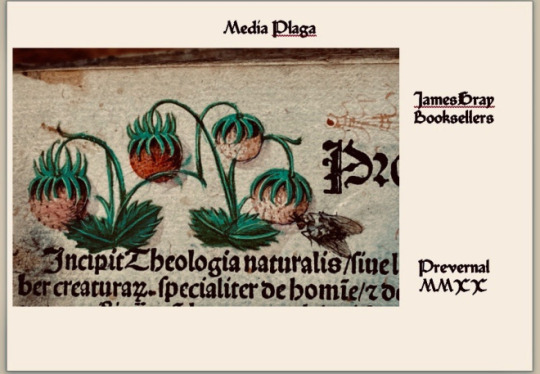
1). 355J Bible Saint Jerome, Gabriello Bruno (active 1480-1514.)
Biblia cum summariis concordantiis : diuisionibus: quattuor repertoriis p[ro]positis: numeriq[ue] foliorum distinctione: terse et fidelit[er] imp[re]ssa. { With table of Gabriel Brunus }
[Lyons]: Jean Pivard, 29 Jan. 1500 & 1. $ 15,000.
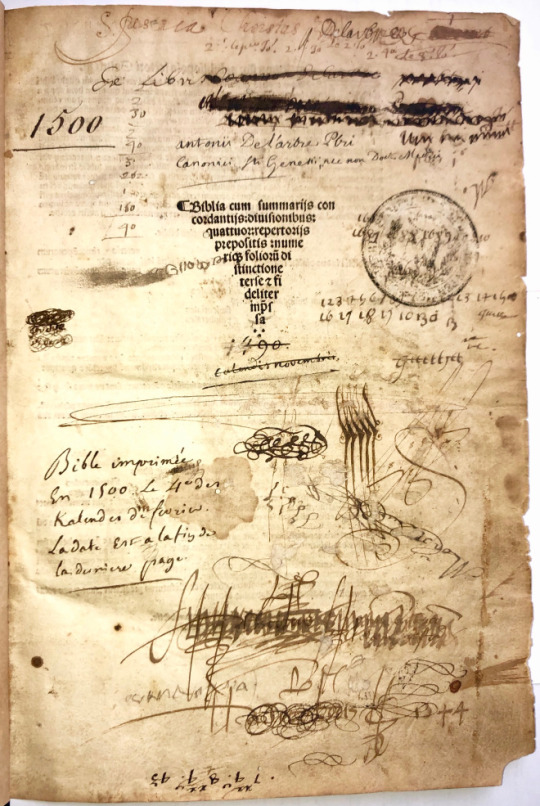
Impresserunt aute[m] solertes viri Franciscus Fradin et Ioha[n]nes Piuard socij impressores. …,]
Folio inches, &8 ç8 , a8 b6, c-z8 A-Z8 Aa8 Bb8; aa-cc8 dd10. Bound in original full calf over wooden boards with 10 brass bosses.
This edition corresponds with the edition printed by Fradin and Pivard in 1497. There are the same tables, summaries, &c.; and the arrangement of the books and the readings are alike. At the end of the subscription we read: “Impressit autem solers ori Johänes Pivard impressor. Deo sint sempiterne gratie.”
Pivard,who was working alone from 7 March 1498 to 1501, Started printing with François Fradin in 1497 (Goff B602) ISTC lists15 titles solely printed by Privard.
Goff B604; HC 3128; GfT 1883, 1884; Pell 2341; CIBN B-426; Arnoult 288; Girard 108; Parguez 213; Polain(B) 4210; IBE 1040; SI 764; Martín Abad B-134; Sallander 2098; Bod-inc B-312; Sheppard 6736; Pr 8670; GW 4281. (Gutenberg-Jahrbuch 1965 p140-3)
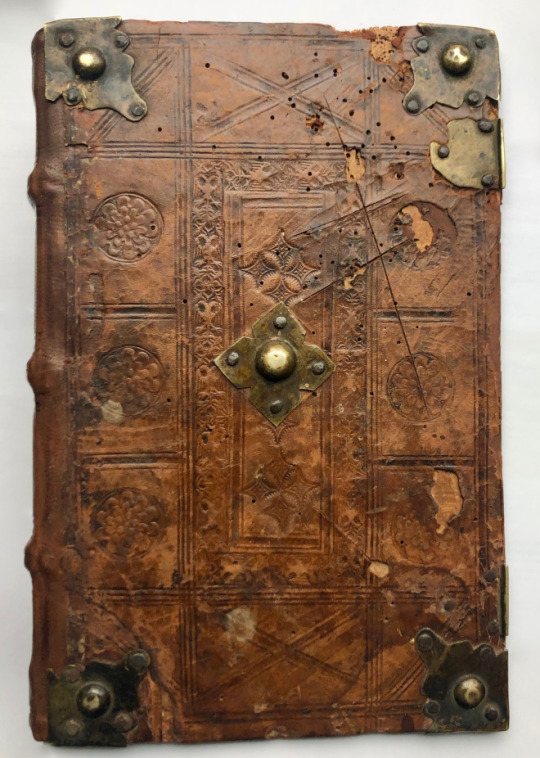
Copinger, Incunabula Biblica, 120; Darlow–Moule 6090; Sheppard 6736.
U.S. copies: Boston Public Library, General Theological Seminary, Jewish Theological Seminary of America, Library of Congress, Rare Book Division, Southern Methodist Univ., Bridwell Library (418 ff)
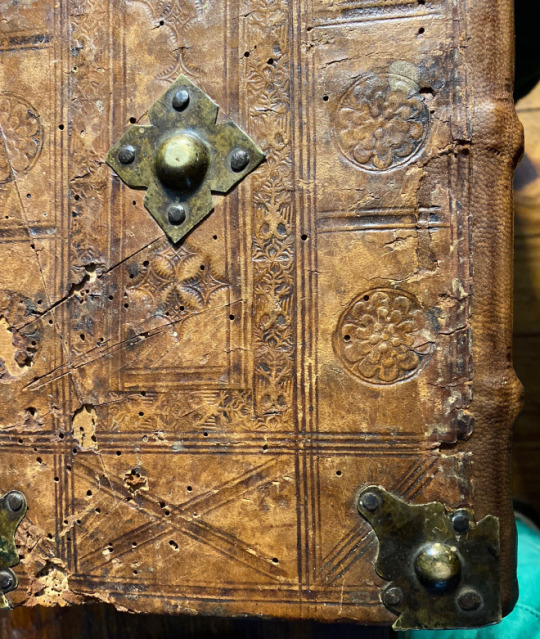
https://data.cerl.org/istc/ib00604000
◊
◊ ◊
◊
2) 353J Alberto da Castello (ca. 1460-1522)
Rosario della gloriosa Vergine Maria : con lle sttattiionii & iindullgenttiie delllle chiiese di Roma perr tutto L’’anno.
In Venetia : Presso la compagnia de gli Vniti,1585. $7,800

Octavo. 6 x 3 3/4. A-Z, Aa-Ii8. A later edition of the first ‘Rosary Book” in Italian.
This book has a wonderful contemporary binding, recently expertly rebacked. It is of red Morocco with gilt center images and borders gilt, with angels. Certainly these books were
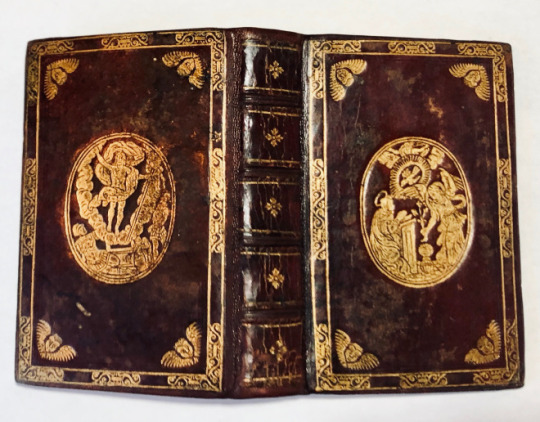
very popular, that said, very few copies have survived. This edition is represented on OCLC by only two copies worldwide. 1 US copy Saint Benedict/Saint John’s University. (SJU Alcuin Arca Artium Rare BookBX2163 .C37 1585). [The authorship of the work and the woodcuts are attributable to the Dominican Friar Alberto da Castello, identified as author or editor at the authorizations of the Venecian Inquisition, given 5 April 1521. (Francesco Pisano)]
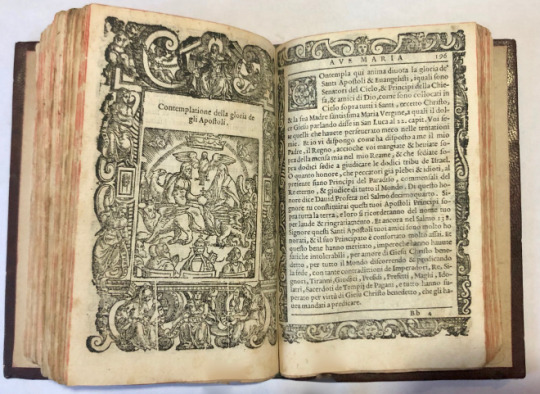
Over 150 woodcuts (including repeats) comprising almost full-page cuts (1 on t.p.) within borders. All had previously appeared in earlier editions. Ornamental and pictorial border pieces on almost every leaf. ( The wood cut on leaf 173v is upside down in the border!) Each wood cuts represent the “Mysteries of the Rosary”
“From the beginning, publications on the Rosary came accompanied by lavish xilographic illustrations. The most striking of these can be found in the edition of the Rosario della gloriosa Vergine Maria by Alberto da Castello from 1521 [Fig. 14.1], which contains a wealth of illustrations. This clearly shows that the Rosary was not just an oral recitation, but was also a contemplative prayer engaging the imagination, a combination later mirrored by the exercises of Ignatius of Loyola.
Alberto da Castello, born in the middle of the fifteenth century in Venice, joined the Dominican order around 1470 and wrote several devotional, liturgical, historical and canonical texts. In the Epistola prohemiale of his Rosario della gloriosa Vergine Maria he says that he wrote the meditations and organised the images ‘acciò che gli idioti che non sanno legere habbino el modo de contemplare gli divini beneficii et de questa contemplatione ne habbino qualche frutto spirituale’.( fol. 6r. ‘So that even the illiterate have a means to contemplate gifts of the divine and to receive spiritual fruits from such contemplation’ (translations are mine).He states that he writes especially for the ‘ignoranti, illetterati, idioti’, and that a good Christian must hold the mysteries of the Rosary deep in his heart. (Literary and Visual Forms of a Domestic Devotion: The Rosary in Renaissance Italy. Erminia Ardissino)

The mysteries of the rosary were introduced by Dominic of Prussia sometime between 1410 and 1439. This gave each decade of the rosary a unique quality. Each mystery leads us to ponder very specific events in the lives of Jesus and Mary and the lessons they hold for our own lives today.
The Rosary has a ritual aspect that individual prayers lack, and it is highly structured. It entails the recitation of 150 Ave Marias, clustered in groups of ten, preceded by a Pater noster and the proposition of a ‘mystery’ upon which to meditate. This number of 150
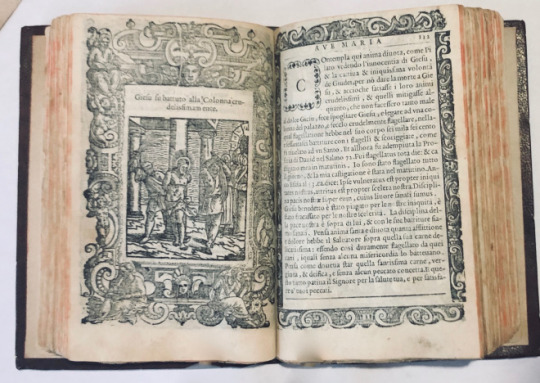
Ave Marias seems to be designed to correspond to the 150 psalms in the Davidic psalter, which is why the Rosary is also known as the ‘Virgin’s psalter’. It does not consist only of repetitive prayers, however, but also entails meditations. Indeed, the Rosary created by Dominic of Prussia was a kind of meditation on the life of Christ and Mary. In his Liber experientiarum he ‘explicitly claimed to be the first to have composed a series of fifty points on the life of Christ that were to be meditated on while reciting the Ave Marias’.
Sander 6572-6573. See: Essling 2124
)0(
100 full page plates and a volvelle!
3) 382J Jan David. 1545?-1613.
Veridicus christianus: auctore P. Joanne David … Editio altera, auctior.
Antverpiæ ex officina Plantiniana, M. DCVI. $6,500
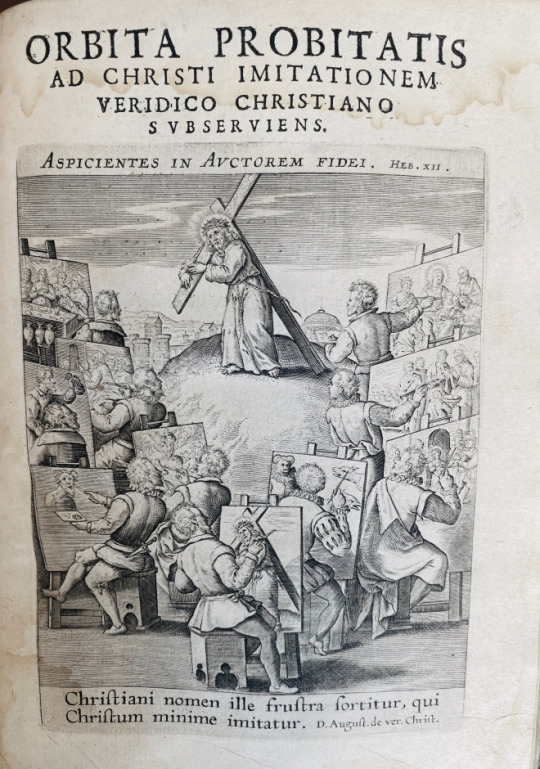
Quarto 8 1/2 X 6 inches ‡4, ‡‡4, A-Z4, a-z4, Aa-Ee4.+ 100 Numbered Plates. Withspecial engraved t.p. with allegorical depiction of Christ carrying the cross, surrounded by ten artists at easels painting scenes from his life (as well as a few questionable profane subjects).
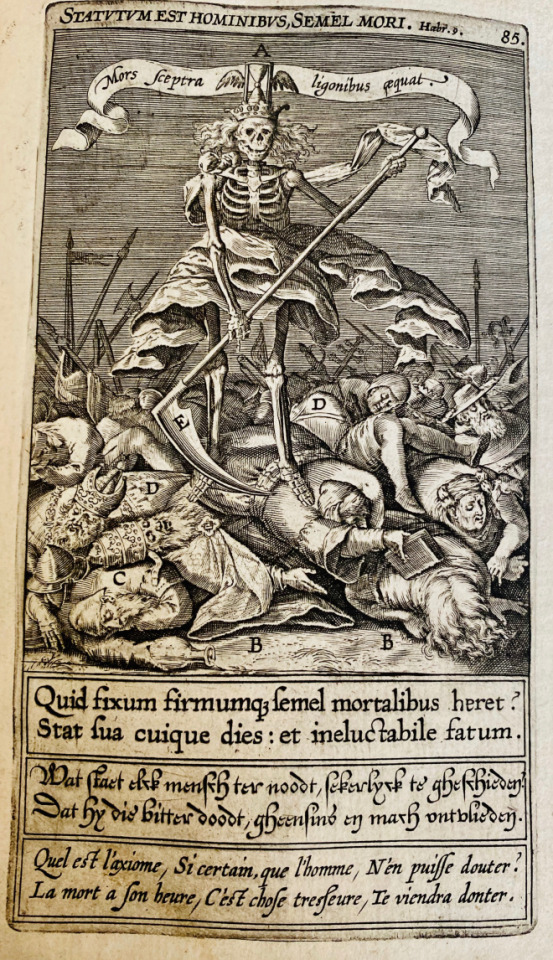
The text is divided into 100 chapters, each with an allegorical engraving incorporating letters keyed to the explanatory text and with marginal references. Each of the 100 numbered plates has a single line of Latin at the head giving the subject, with two-line explanatory verses below the allegorical engraving in Latin (roman letter), Dutch (civilité) and French (italic) First plate (following [2 daggers]4) is added title leaf for the ill., which were also published separately; see Bibliotheca Belgica. The added title reads: Icones ad Veridicvm Christianvm P. Ioannis David e Societate Iesv At the end is Device with compasses and the motto “constantia et labore” on Ee4r . This book is notoriously found defective in one way or another, this copy is perfect and complete.
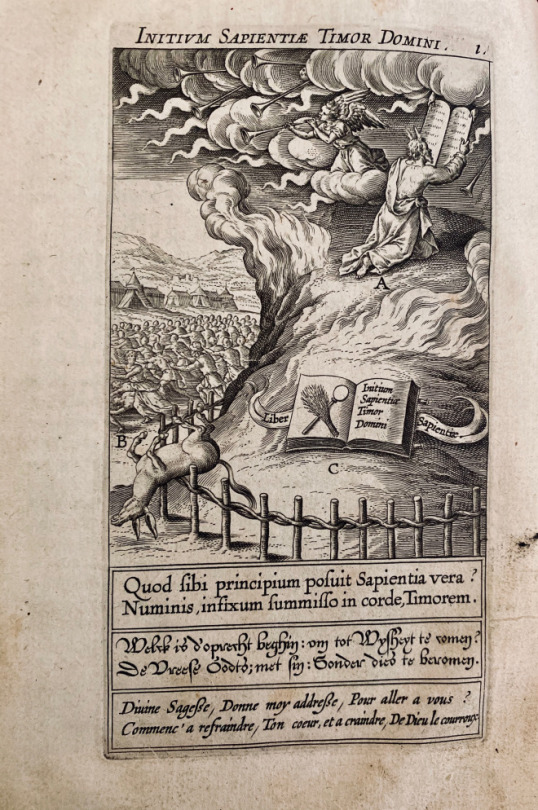
This copy is bound in full contemporary blind stamped calf over wooden boards with two working clasps.
The Veridicus christianus: is followed by the “Orbita probitatis ad Christi imitationem veridico Christano subserviens”: p. 351-374; which preceds a volvelle plate for use in locating specific passages.
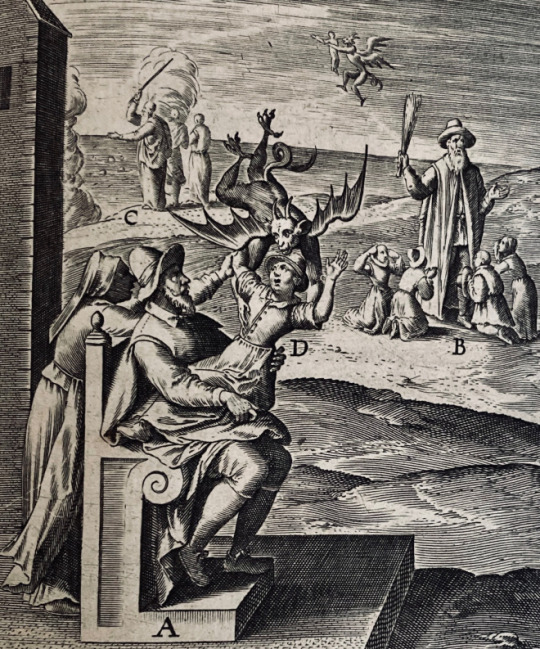
This text contains a series of images with accessible (sometimes to a fault) moral or religious messages. These illustration swarns against opening the senses to temptation lest death and moral decay take up residence in one’s soul.
The Veridicus Christianus emphasizes the Society of Jesus’ investment in thinking in, though, and about visual images that exemplify the supreme mystery of God. Published as a tool of devotion and meditations, it features one hundred chapters that encompass a wide range of topics for reflection. Each chapter incorporates an extensive commentary that interprets the emblematic image David too follows the order in which we apprehend things with our senses, beginning with a visual representation at the head of each chapter. Then comes the explication. The symboli explicatio was considered necessary because cultivated readers would be more susceptible to a reasoned argument than a picture.
Here are images of the vovell. The centers of the engraving and the volvelle (through which a string passes) are reinforced with small paper roundels printed with the monograms of Christ. The numbers are keyed to an “Indiculus orbitae” that follows (Bb1r-Bb2r). There a number, having been selected, is provided with a phrase from various Latin authors (listed on Bb2v), and a reference to one of the hundred sections that comprise the main text. It is suggested in Bibliotheca Belgica that this game may have been intended as a pious alternative to such superstitious books as Thuys der fortvnen.
)0(
4) 312J. Domenico Cavalca. (1270?-1342)
Pungi lingua
[Baptista de Tortis]: Venexia, Adi .viiii. de Octubrio. 1494 $12,000
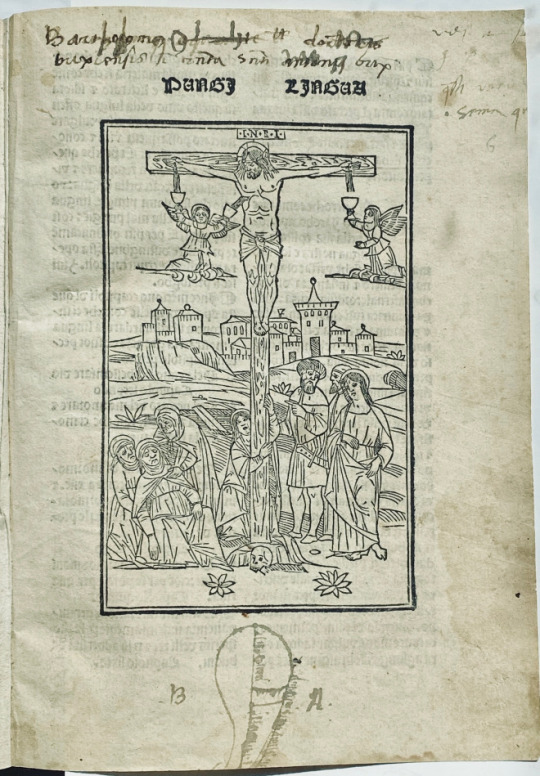
Quarto (200 x 145 mm); [80] pages. a-k8. Large woodcut depicting the crucifixion on the frontispiece, First Venetian edition with the beautiful woodblock published here for the first time. This copy has a beautiful initial “A” in gold, blue, red and green, a colorful coat of arms. This copy is bound in modern carta rustic with a gold title on an orange label

This is a treatise on the dangers of the misuse of the language it was, as you might expect quite popular . Written by the Dominican monk who was a contemporary of Dante and among the first to write in the vernacular, and one of the most successful translators of holy texts.
Aside from Biblical illustrations, the Pungilingua has many exempla drawn from many other sources including some not includes in the Alphabetum narratinum. Most of the stories are told in one to three lines, and many contain commerce with the Devil, one time disguised as a horse. In the prologue Cavalca mentions that he gathered his exempla from many sources “alcune poche cose” . One of the major sources is the Summa Vitiorum by Peraldus. but he also quite a few profane authors , Seneca, Socrates, Cicero, Valerius Maximus. That said, quite often Cavalca attributes the wrong author. Cavalca writes as though he was speaking to the reader in person useing phrases like “Io per me credo” and “Oimé “ Introducing unique stories and words, He refers to someone as double-tongued as a “tecomeco” (bilingue) . He refers to a sleight of hand trick ,called “gherminella” a word which was used later by Boccaccio. This is an important book in Italian literary history, and the Italian vocabulary leaving many contemporary proverbs and descriptions of medieval life. Goff C342; H(Add)C 4776a; R 116; Pell 3448; CIBN C-195; IGI 2637; Essling 750; Sander 1853; Pr 4649; BMC V 328; GW 6413
One copy in Goff. Huntington Library.
Queried Location: New York NY, Manhattan College: sold Christie’s (NY) 1 June 1991 lot 41 (current whereabouts unknown)

***
***
5) 350J. Richard FitzRalph (Ricardus Radulphus Armacanus pseudonym) (circa 1300-1360)
Summa Domini Armacani in Questionibus Armenorum noviter impressa et Correcta a magistro nostro Johanne Sudoris. Cum aliquibus Sermonibus eiusdem de Christi dominio.
Paris: Jehan Petit et ponset le Preux, (Venales habentur in vico divi Jacobi sub Lilio aureo) 1512. [Privilège octroyé à Jean Petit et Poncet Le Preux daté du 12 mars 1511 (1512 n. st.) et prenant effet le 15 juillet 1512.]. $24,000
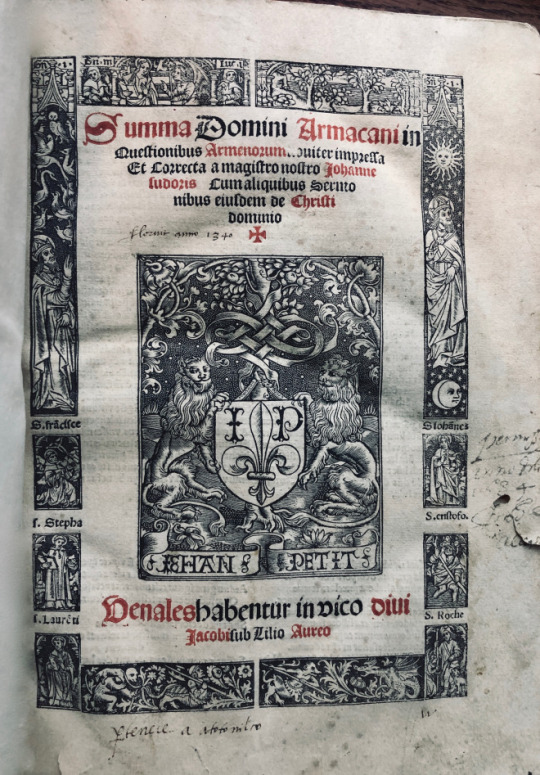
Small Folio 275 x 201 mm. A6 a-z6 &6 A-E6 F4. [6], 177 [i. e., 178] leaves. This copy is bound in a Remboîtage of later limp vellum; contents toned and brittle, lightly damp wrinkled with marginal damp staining at beginning and end, contemporary inscriptions on title and scattered underscoring and marginalia, wormhole through blank outer margin of approximately the first 30 leaves, paper crack in o1 not affecting text, last leaf reinforced in outer margin on verso. A Mexican Augustinian branded ownership mark on bottom edge. This is the only printed edition of the Summa in Questionibus Armenorum which is an examination of alleged Armenian doctrinal errors, the chief dogmatic work by an Irish theologian and prelate involved in negotiations between the papal court at Avignon and Armenian representatives over the reconciliation of the Roman and Armenian churches. FitzRalph, whose Defensorium curatorum was first published circa 1483, was one of the earliest Irish authors to appear in print. Renouard-Moreau II, 314; Shaaber M119; not in RBH or ABPC. Moreau, B. Inventaire 1512- 314; Index des livres interdits, t. IX, p. 86 (n° 50/499; Page de titre en rouge et noir dans un encadrement de plaques gravées sur métal, marque de Jean Petit (Renouard, 890) Adams, F-550
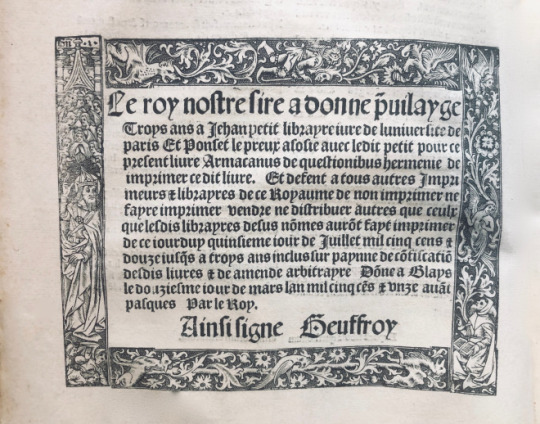
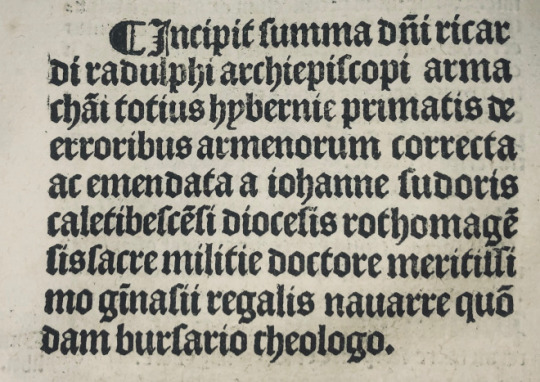
><><><><><
6) 358J Jacobus de Gruytrode 1400-1475
Speculum animae peccatricis
[Memmingen : Albrecht Kunne, about 1490] $6,500

Quarto , [28] ff, 33 lines, the first initial (5 lines) is painted in white and blue on a golden background, upper and left margin richly decorated in red, purple, blue and gold and with two red beasts. 19th c. binding in half leather, title gilt on spine, all edges gilt. Sometimes falsely attributed to Dionysius Carthusiensis, the Speculum is now attributed either to Jacobus de Gruytrode (cf. Bloomfield) or to Jacobus de Clusa (cf. L. Meier, Die Werke des Erfurter Karthäusers Jakob von Jüterbog, Münster, 1955).

Speculum animae peccatricis is a work of spiritual edification which consists of seven sections: on human misery, sin (especially lechery), penance, rejection of the world, the vanity of human wishes, death and hell and heaven.
Firste of the filthenes and miserie of man. Below are the chapter in English
Secounde of the synnes ingeneralle and of their effectis.
Thyrde howe they ought hastely with all diligence to do penaunce.
Fourth howe they ought to fle the world.
Fyfthe of the false Riches and vayne ho∣noures of the worlde.
Sixt howe they ought to drede deth.
Seuenth of the Ioyes of paradyse and of the paynes of hell.
There is no modern critical edition of the text. Among the devotional books by the Flemish mystical writers of the fourteenth and fifteenth centuries, none was more popular on the Continent and in England during the early Renaissance than the Speculum aureum animae peccatricis or The mirroure of golde for the synfull soule, which Lady Margaret Beaufort translated into English. Since the sixteenth century, bibliographers have listed the Speculum as the work of the Carthusian monk Jacobus de Gruytroede, prior of the Liége Charterhouse from 1440 to 1475, yet the English version is always attributed to his friend Denis de Leuwis or Dionysius the Carthusian, as he is better known. The question of authorship may be satisfactorily settled as the result of recent research by an English Carthusian scholar in the library of the Certosa in Farneta. He noted that the editors of Dionysius’s Opera omnia (Tournai, 1913) explain how the error in authorship began. In volume xlii they point out that, owing to the Carthusian tradition of anonymity during a monk’s lifetime, the Speculum was printed anonymously until 1495, in which year the Nuremberg printer Paul Wagner first issued it as a work by Dionysius. He found the manuscript of the Speculum in the library at Ruremond, where Dionysius was prior until his death in 1471, and supposed it was written by him, as were the other works he intended to print. The two priors were close friends, and dedicated several of their works to each other. Nugent E.M. (1969) Jacobus de Gruytroede. In: Nugent E.M. (eds) The Thought & Culture of the English Renaissance. Springer, Dordrecht
Goff S644; HC 14899*; Pell 4313; CIBN S-333; IGI 5001; IDL 2532; Schlechter-Ries 1003; Voull(B) 1617,5; Schmitt I 1614,2; Hubay(Augsburg) 1141; Hubay(Eichstätt) 538; Sack(Freiburg) 1951; Walsh 988; Bod-inc S-258; Sheppard 2032; Pr 2804; BMC II 608; BSB-Ink I-23; GW M10734
U.S. copies;Harvard ,Emory, Columbia ,Huntington Library
Southern Methodist Univ, Univ. of Illinois at Urbana-Champaign Library
)0(
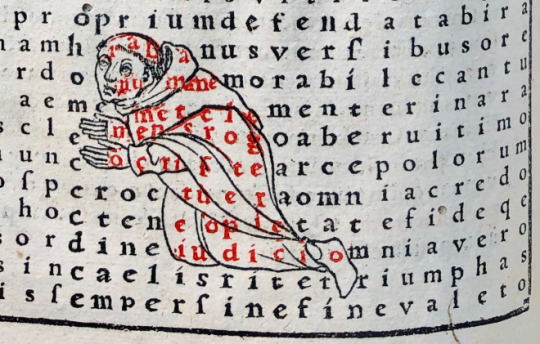
Nam digiti scripto laetantur, lumina visu Mens volvet sensu mystica verba Dei
“The fingers rejoice in writing, the eyes in seeing, and the mind at examining the meaning of God’s mystical words.”
The first printed facsimile of a manuscript.
7) 351J. Hrabanus Maurus. 784-856?
Magnencij Rabani Mauri De Laudib[us] sancte Crucis opus. erudicione versu prosaq[ue] mirificum.
Phorçheim. [Pforzheim] : In ædibus Thom[ae] Anshelmi., 1503. $10,700
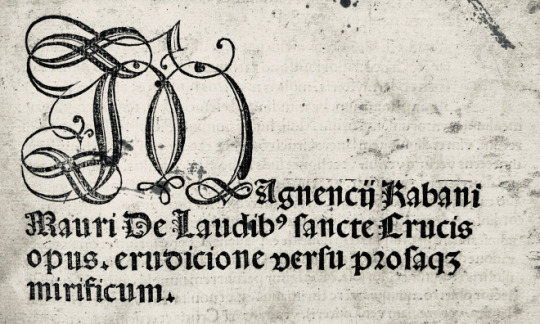
Folio Aa6, Bb4, a-k6, A-B6, C4 (last leaf blank).
THIS COPY LACKING [four leaves] A5 & 6, Bb1 and a1. [two woodcuts of Alcuin interceding on behalf of Rabanus before Pope Gregory iv, and of Rabanus presenting his poems to the Pope; and two figured dedicatory poems the first to Louis the Pious the next christ crucified] It is bound in a full vellum modern binding. First Edition (for a second edition see below) Types 3:109R, 4:180G; 40 lines of transcribed verse + headline, 40 lines of commentary + headline, red and black printing throughout, calligraphic woodcut initial (Proctor, fig. 24) M on title page, woodcut initials printed in red, and a figured prefatory poem, 28 carmina figurata, the first entirely xylographic, the remaining poems combining printed and xylographic letters with the versus intexti printed in red (except fig. xvi), enclosed by either woodcut figures (of the emperor, Christ, the Evangelists, Cherubim, etc.) printed in black or by Christian symbols and characters, most defined by metal rules in red.
This is a remarkable typographical achievement, probably the earliest attempt to reproduce a medieval manuscript. The greater portion of the work comprises a preface in verse and twenty-eight poems. “Hrabanus Maurus, the abbot of Fulda, wrote in the midst of the ‘new monasticism,’ a period associated with a revival of literacy and learning. In religious and secular spheres. This ‘script culture,’ as Rosamond McKitterick has it, used the written word not only as a mode of communication but as ‘a resource, a guide, a key, and an inspiration,’ especially in the devotional practice of Christianity.
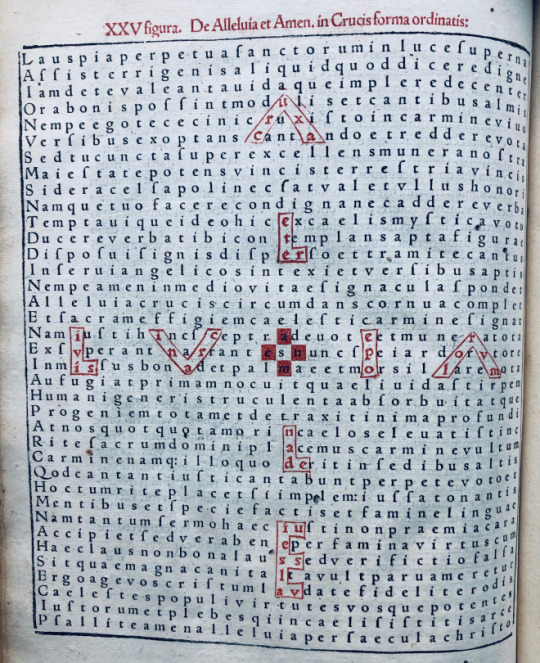
Each of the twenty-eight picture poems that form In honorem sanctae crucis explores a different theme relating to the Cross through a complex interplay of word and image. The poems each have an equal number of letters per line, written continuously like a grid. By following the letters in the usual direction for a Latin text—from left to right, top to bottom—each grid reads as one long poem. But within each grid, certain letters are also marked out with colour and drawings to form pictures. The letters that make up these pictures read as separate short poems embedded within the larger poem. As such, each page of In honorem sanctae crucis presents not just a puzzle of words and pictures, full of hidden and interrelated messages for the reader to decode bout a meditation exercise.
“Hrabanus created the various shapes and figures by highlighting individual letters in underlying poens in colour (in the printed editions red), and theses individual letters together make up meaningful text , ranging from simple declarations to very elaborate ones. For example, Carmina 2 contains a simple cross inside a square (Hrabanus calls it a “tetragonum”)whose sides form a border for the poem as a whole. The textfrom the underlying poen that makes up the figure consists of six hexameters, each one an address to the cross beginning with the words ‘O crux…’ When we follow Hrabanus’s instruction in the accompanying prose text for reading these hexameters, we find the following: even though the verse that forms the top of the square is also the opening of the underlying poem, he insists that we begin reading with the stem of the cross, from top to bottom.” (Schipper)
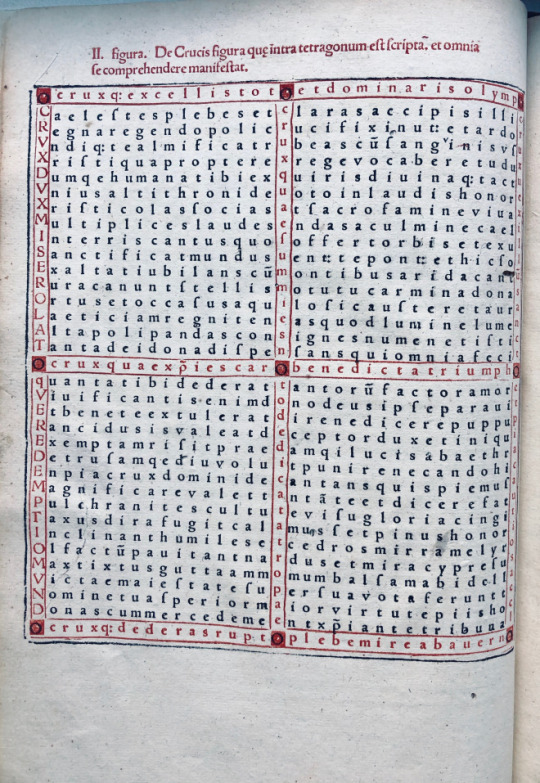
Sunt quoque uersus duo in ipsa ccruceconscripti, quorum prior est: O CRVX QVAE SVMMI ES NOTO DEDICATA TROPAEO
a summo in ima descendens. Alter uero: O CRVX QVAE CHRISTI ES CARO BENEDICTA TRIVMPHO a dextra in sinistram crucis tendens ‡
‡“there are also two verses inscribed in the cross, the first of which is : “ O cross , thou who art at the height of fame, a dedicated moment” ‘running from the top down. And a second’ “O Cross thou who through the body of Christ art the blessed triumph” ‘running from the right to the left.’
Further more Hrabanus flips left and right the texts point of view alternates , Hrabanus tells us the cross is looking out at the reader, not the other way around. “ Only after we have read the hexameters in the cross are we free to read the verses in the four sides of the tetragon, and even then Hrabanus constrains the order in which they are to be read: first the top, then the bottom, then the right side then finally the left side.”
More complex figures present further challenges in reading. The figure in Carmen 25, for example, consists of eight letters of the word ‘ALLEVIA’ arranged around a small cross. It does not take much effort to notice that we need to start with the A, read down to the E, continue on the left, and end on the right of the figure; and that each time we trace out those letters we make the sign of the cross. It becomes more difficult when we also try and read the text that is enclosed in the figures.

The letters of ALLEVIA are made of the following letters from the underlying poem. A crux[a L eter L na[de E i]es[lave[v L ivis V in]arc I e]po A lorvm
CRUX AETERNA DEI ES LAVS VIVIS IN ARCE POLORUM
‡ Eternal cross, thou art the praise of God, thou livest in the arc of the skies.
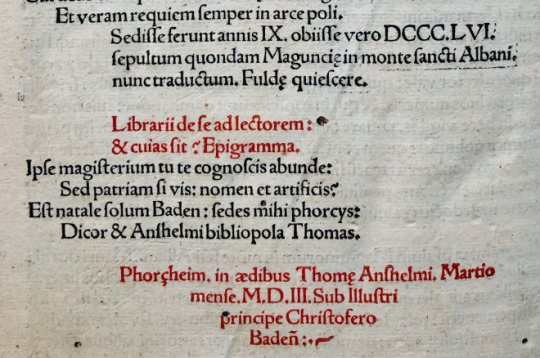
Peter Godman, Poetry of the Carolingian Renaissance (Norman: University of Oklahoma Press, 1985), 249. A. G. Rigg and G. R. Wieland, ‘A Canterbury Classbook of the Mid-eleventh Century Anglo-Saxon England 4 (1974), 113-30.
William Schipper, ‘Hrabanus Maurus in Anglo-Saxon England: In Honorem Sanctae Crucis’, in Early Medieval Studies in Memory of Patrick Wormald, ed. Stephen Baxter, Catherine Karkov, Janet L. Nelson, David Pelteret (Farnham, Surrey; Burlington, Vt.: Ashgate 2009), 283-98.
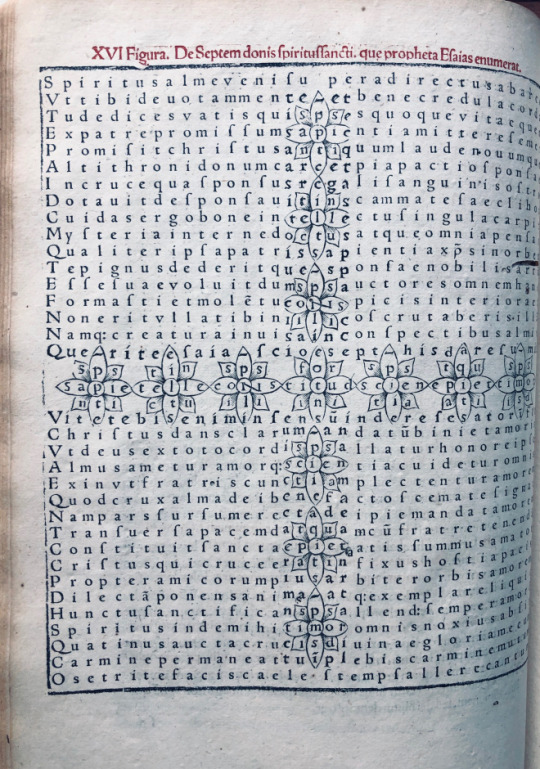
Proctor, R. Index to the early printed books in the British Museum,; 11747; Adams, H.M. Catalogue of books printed on the continent of Europe, 1501-1600, in Cambridge libraries,; R3; Catalogue of a collection of early German books in the library of C. Fairfax Murray,; 350; Panzer, G.W.F. Annales typographici,; VIII 227, 2; Pollard, A.W. Catalogue of books mostly from the presses of the first printers … collected by Rush C. Hawkins,; 189 Panzer, VIII, 227, no. 2. Proctor 11747. Fairfax Murray 350./ Last leaf blank./ Edited by Jakob Wimpheling.–cf. title page verso./ Illustrations: 2 woodcuts of the author presenting his book to the pope, and many woodcut figures (Christ, cherubs, crosses, symbols, etc.) printed on 28 pages of text. Some of the text within and near the outline figures is xylographic, the rest printed. The letters within the outlines are printed in red and may be read separately in a different sense. Printed in red and black, initials (except on t.p.) in red./ With label of Sinclair Hamilton. Peter Godman, Poetry of the Carolingian Renaissance (Norman: University of Oklahoma Press, 1985), 249. A. G. Rigg and G. R. Wieland, ‘A Canterbury Classbook of the Mid-eleventh Century Anglo-Saxon England 4 (1974), 113-30. William Schipper, ‘Hrabanus Maurus in Anglo-Saxon England: In Honorem Sanctae Crucis’, in Early Medieval Studies in Memory of Patrick Wormald, ed. Stephen Baxter, Catherine Karkov, Janet L. Nelson, David Pelteret (Farnham, Surrey; Burlington, Vt.: Ashgate,
^)^)^)^(^(^(^
The second edition One-Hundred and three years later.
8). 354J Hrabanus Maurus. 784-856?
Magnencij Rabani Mauri De Laudib[us] sancte Crucis opus. erudicione versu prosaq[ue] mirificum. Cum antiqviate avctoris <annis abhinc prope octingentis abbatis primum fuldensis, archiepiscopi postea moguntini. tum noitate scriptionis memorabile. Qvo figvris sive imaginibvs XXVIII. multi fedei christianae mysteria, multi mystici numeri; angelorum, virtutum, VII. donorum Spiritus Sancti, VIII. Beatitudinum, IV. elementorum, IV. temorum anni, VI euangelistarum & agni, mensium, ventorum, V librorum Moysis, nominis Adam, alleluia, & amen, aliarumq[ue] rerum vis & dignitas in formam crvis reedacta, subtiliter et ingeniose explicantur.
Augustæ Vindelicorvm e typographeo Praetoriano. , 1605. $9,000
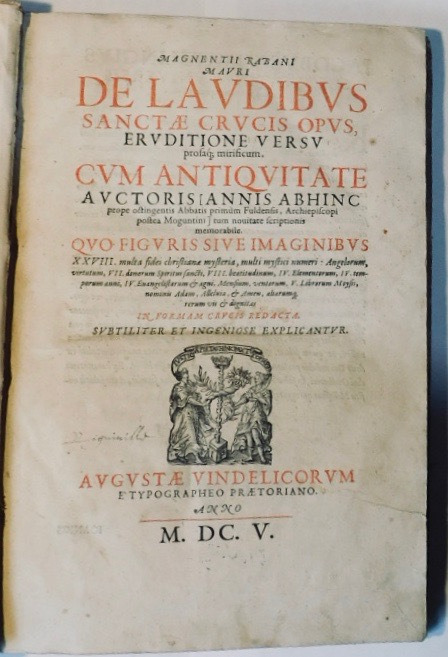
Folio Aa6, Bb4, a-k6, a6, B4, c4. (complete). Printers mark on title page, woodcut initials printed in red, two woodcuts of Alcuin interceding on behalf of Rabanus before Pope Gregory iv, and of Rabanus presenting his poems to the Pope; a figured dedicatory poem to Louis the Pious and a figured prefatory poem, 28 carmina figurata, the first entirely xylographic, the remaining poems combining printed and xylographic letters with the versus intexti printed in red (except fig. xvi), enclosed by either woodcut figures (of the emperor, Christ, the Evangelists, Cherubim, etc.) printed in black or by Christian symbols and characters, most defined by metal rules in red. Bound in contemporary deer skin.
This aside from the prologue this edition is a re-set reproduction of the first printed edition (see above)
#######+++++#######
9) 383J Johannes de Anania
Commentaria super prima et secunda parte libri quinti Decretalium. Add: Repertorium
Bologna : Henricus de Colonia, 7 Dec. 1479, 5 Jan. 1480. $17,000
Large folio 422 x 285mm Pars III (bound first) a8,b6,c10,d6,e8,f4,g8.(lacking a1Blank) Pars I (bound second) a10,b8,i8,k6,l8,m8,n6,o6,p8,q8,r10s 10. Pars II (bound third) A8,-F8,G6,H8,-L8,M6,N8,O8P6,Q8,R8,S6,T8,U10,X8-Z8, &8, ¶8,€8,¡8. In three parts, dated: 7 Dec. 1479 (Commentaria, partes I-II); 5 Jan. 1480 (Repertorium)
No copy of parts II & III in the US. The margin of a2 of the Repertorium cut off with no text loss (see image) This is a very very wide margined copy, with strong and crisp paper. The first leaf is stroked in red and blue. Throughout the rest of the books capital spaces are left blank. This copy is bound in 19th century vellum.
ANANI’A, JOHANNES DE : his family name, Anagni. implies that he was of the family of the Catani, and that his father’s name was Leonardo. He taught canon law in Bologna, and had the reputation of a conscientious man. He studied under Floriano di San Pietro. Alexander Tartagni and Andreas Barbati were his scholars; the former became his step-son, and the latter inherited his library. According to Orlandi, Anania was sent ambassador from the city of Bologna to Pope Martin V. in 1425, and he was also employed to conduct negotiations with other princes. Johannes de Anania at the time of his death, in 1455 or 1458, was archdeacon at Bologna. Spangenberg enumerates four of his works, three of which were published at Lyon between 1521 and 1555 : — 1. A Commentary on the fifth book of the Decretals, published in folio at Lyon in 1521, and reprinted there in 1553. 2. Consilia, discovered and edited by Ludovico Bolognini, in folio, at Lyon in 1555, reprinted at Venice in 1570. 3. “De Revocatione Feudi alienati,” in octavo, at Lyon, in 1546, reprinted at Basle in 1564. 4. A Collection of the Decisions of the Roman Rota, at Venice, in folio, in 1496. Mazzuchelli mentions a treatise on the law as to salaries, “Allegatio de Salario et Stipendio ac de Obligatione et Promissione Domini,” which is preserved in MS. at Bologna in the library of the Collegio di Spagna. In addition to these Lipenius ascribes to Johannes de Anania a legal tract on church patronage, “De Jure Patronatus Ecclesiastico,” published at Amsterdam in 1640; and a collection of cases (” Quaestiones”) at Cologne in 1570. To the folio edition of Baldus, “In Usus Feudorum Commentaria,”
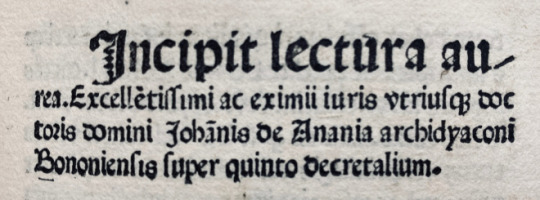
published at Lyon in 1550, there is appended a thesis on the law regarding the alienation of fiefs, maintained by Johannes de Anania at a public disputation in Bologna. The date is not given, but he is styled “Doctor et Canonicus,” and his opponent is said to have been Secundinus de Natis; and the publisher intimates that the MS. had been preserved in the library of Johannes Nevizanus at Asti. No. 446. of the Arundel MSS. in the library of the British Museum contains a treatise “De Usuris” by Johannes de Anania. The volume is of a large folio form, and the ” De Usuris,” written in a small character with numerous contractions, occupies the folios 93. to 164. inclusive, each folio containing four columns. These treatises are the only compositions of the author we have seen, and they leave a favourable impression of his skill in selecting authorities to support and elucidate his positions, and of his talent for lucid arrangement. (Mazzuchelli, Scrittori d’ Italia; Spangenberg, in Ersch und Gruber’s Allgemeine Encyclopadie; Alidosi, Appendice alli Dottori Bolognesi de Legge Canonica e Civile; Orlandi, Notizie degli Scrittori Bolognesi; Baldus Perusinus, in Usus Feudorum Commentaria doctissima, quibus accesserunt Andr. Siculi Adnotationes una cum Joan. de Anania eleganti Disputatione in tres secta Quastiones, Lugduni, 1550, fol.; Arundel MSS. in the British Museum, No. 446.) W. W
Not in Goff: ISTC ij00250150; H 938*; Torchet 521; IGI 5245; IBE 3188; Kotvan 702; Sajó-Soltész 1881; Martín Abad J-44; Voull(B) 2735,20; Walsh 3188; BSB-Ink I-365; GW M12841
Holdings: United States Harvard University, Law School Library (I) only.

)0(
)0(
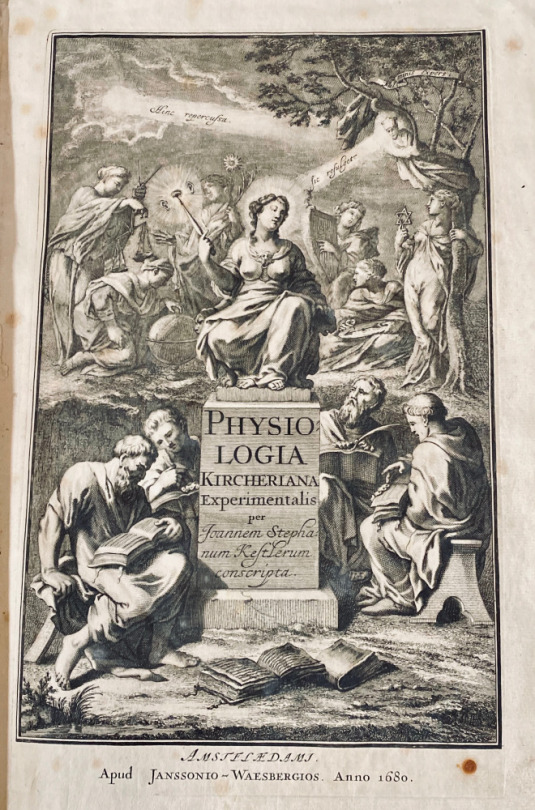
10) 381J Athanasius Kircher 1602-1680
Physiologia Kircheriana Experimentalis, Qua Summa Argumentorum Multitudine & Varietate Naturalium rerum scientia per experimenta Physica, Mathematica, Medica, Chymica, Musica, Magnetica, Mechanica comprobatur atque stabilitur. Quam Ex Vastis Operibus Adm. Revdi. P. Athanasii Kircheri extraxit, & in hunc ordinem per classes redegit Romæ, Anno M. DC. LXXV. Joannes Stephanus Kestlerus Alsata, Authoris discipulus, & in re litterariâ assecla, & coadjutor.
Amsterdam: Ex Officinâ Janssonio-Waesbergiana. Anno 1680 $9,500
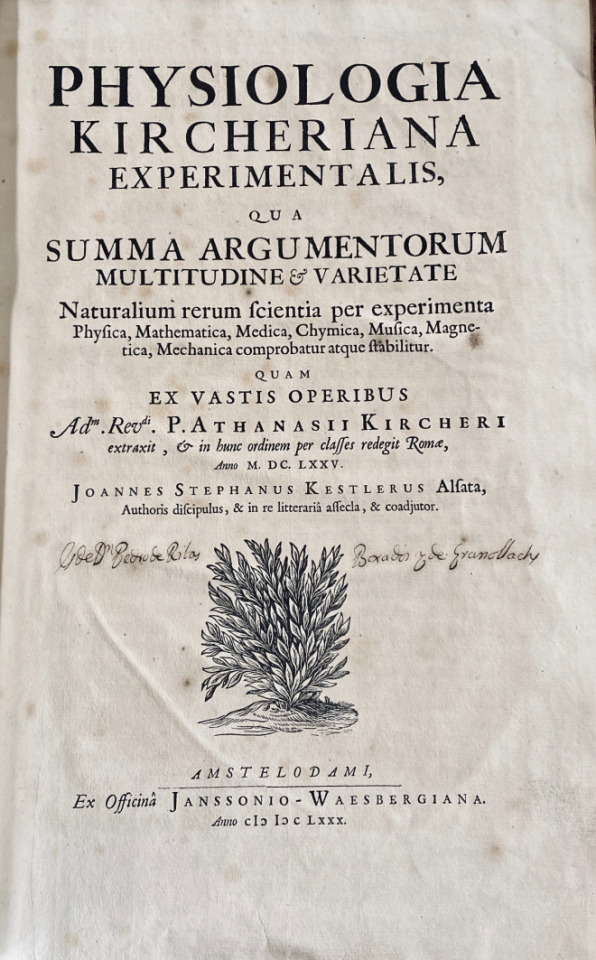
Folio. 15 x 9 3/4 inches. *4, A-Z4, Aa-Ii4. First edition.mmThis copy is quite clean and crisp throughout, never having been washed or pressed. There is some occasional spotting and browning. but none is too extensive. The binding is twentyth century full vellum with title on spine. an impressive and large copy!
“Thus in the must varied branches of science Kircher played the role of pioneer. Even medicine received his attention, as is shown for example by his treatise, ‘Scrutinium phyisco-medicum contagiosæ luis, quæ pestis dicitur’ (Rome, 1663). His scientific activities brought him into scientific correspondence with scholars laboring in the most different fields, as the numerous volumes of his extant letters show. It is to his inventive mind that we owe one of the earliest of our counting machines: the speaking-tube and æolian harp were perfected by him. He was also the inventor of the magic lantern which has since been brought to such perfection and is and is today almost indispensable. [All of these devices are illustrated in the present work, compiled in the year of the author’s death by Kircher and his student Johann Stephan Kestler, including three large and striking engravings of magic lanterns.]” May I ask the reader to take the following quote with a measure of indulgence for its closed minded author [circa 1913] with the hope that modern folk of the last decade of the second millennium have a bit more tolerance for the many sciences that we have yet to master. “That the most varied judgments should be formed and expressed on a man of such encyclopædic knowledge was only to be expected. He tried to find a grain of truth even in the false sciences of alchemy, astrology, and horoscopy, which were still in his time much in vogue, nor is it surprising that in the province of astronomy he did not at this early date defend the Copernican System.” (the above two quoted taken from the Catholic Encyclopedia, vol. viii, page 662) Kircher was an accomplished and versatile scholar who applied his intellectual abilities to a myriad of scientific problems. This work is a fascinating compendium of scientific experiments and principles which documents the accomplishments of early modern thinkers of the west.
^)^)^)^(^(^(^
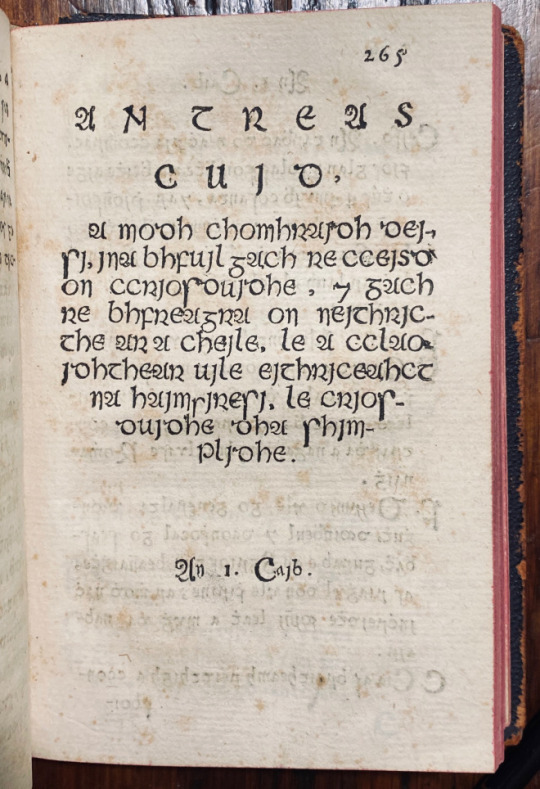
11) 380J Francis Molloy. fl 1660
Lucerna fidelium, seu, Fasciculus decerptus ab authoribus magis versatis, qui tractarunt de doctrina Christiana : divisus in tres partes.
Romæ : Typis Sacræ Congreg. de Propaganda Fide, M DC LXXVI [1676] $4,500 Octavo 6 X 4 inches : A-2B8 2C2. complet, signature ) is mis-signed . This copy is bound in early 20th century sheep.
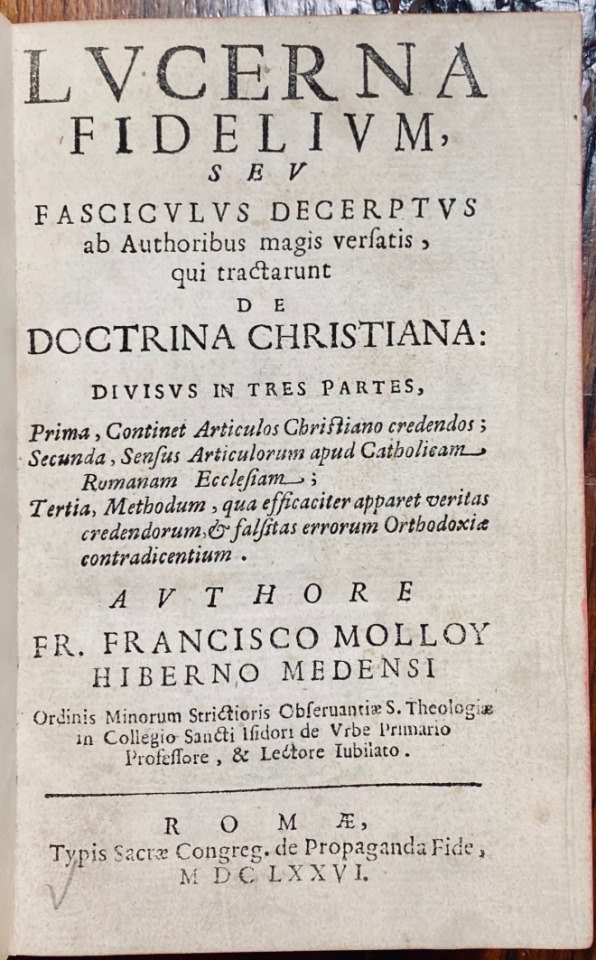
MOLLOY or O’MAOLMHUAIDH, FRANCIS (Jl. 1660), theologian and grammarian, was a native of the county of Meath, Ireland. The family of which he was a member had extensive landed possessions in the district known as O’Molloys’ Country, and some of them engaged actively in the Irish movements from 1641 to 1652.
Francis Molloy entered the order of St. Francis, became a priest, was appointed professor of theology at St. Isidore’s College, Rome, and acted as agent for the Irish catholics at the papal court in the reign of Charles II. His first published work was entitled ‘Tractatus de Incarnatione ad mentern Scoti,’ 1645. This was followed in 1658 by ‘ Jubilatia genethliaca
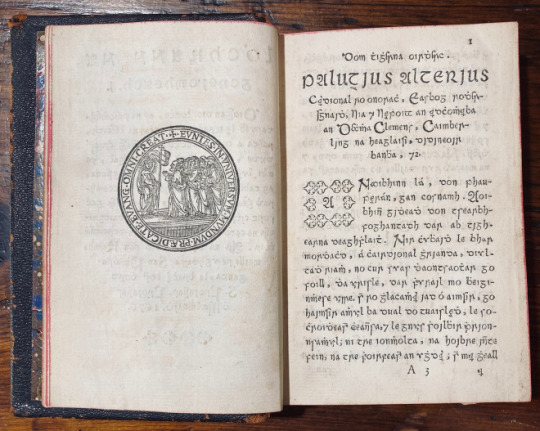
in honorem Prosperi Balthasaris Philippi, Hispani principis, carmine,’ and by a Latin treatise on theology in 1666.
A catechism of the doctrines of the catholic church in the Irish language was published by Molloy in 1676 with the title: ‘Lucerna tidelium, seu fasciculus decerptus ab authoribus magis versatis qui tractarunt de doctrina Christiana.’ It was printed at Rome at the press of the Congregation ‘de propaganda fide,’ ( This book is the first book they printed in Irish Type) from which, in 1677, issued another book by Molloy, entitled ‘Grammatica Latino-Hibernica,’ 12mo, the first printed grammar of the Irish language. Edward Lhuyd [q. v.], in his’ Archaeologia Britannica,’published at Oxford in 1707, mentioned that he had seen a manuscript grammar of the Irish language copied at Louvain in 1669 which partially corresponded with that of Molloy. He added that Molloy’s grammar, although the most complete exta’nt in his time, was deficient as to syntax and the variation of the nouns and verbs. The date of Molloy’s death has not been ascertained. In 1626 Propaganda Fide had installed a printing press for the foreign missions and not much later another one was brought to Louvain where books and catechisms were printed for both the local college and the Irish mission.* The problem with the Propaganda printing press was that only books in Latin and Italian were allowed to be printed so it took until 1674 when Francis Molloy asked for permission to print a catechism there in Irish with the explanation “che altra malamente capisce e vacilla assai per mancanza d’intruttore e d’intruttion sana.”**.
[“Irish priests at Rome had a new Irish type cut about 1675 … [this was] their first book.”- -H. Reichner, Catalogue 34, Jan. 1968]
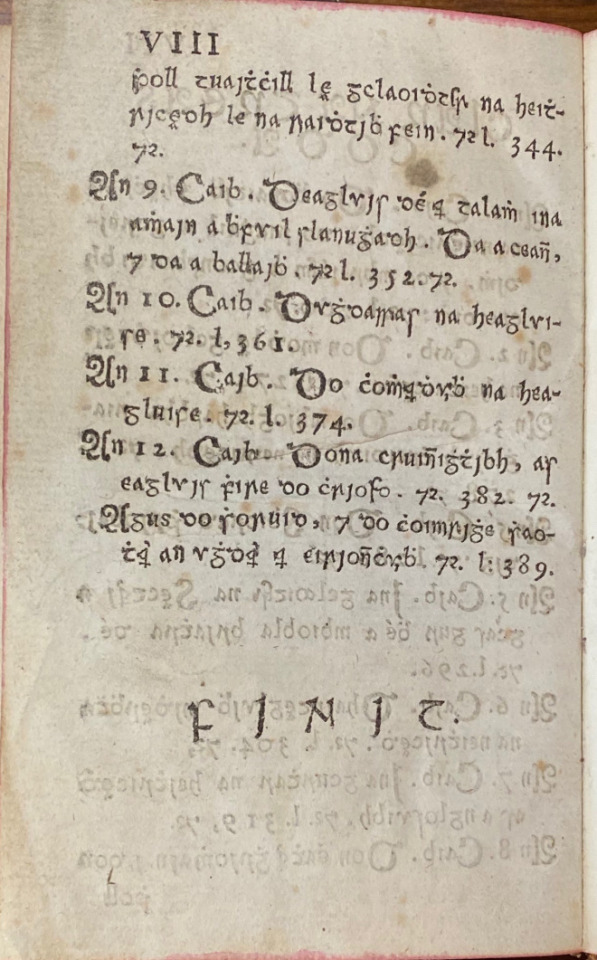
Wing O291C, English short title catalogue,; R41480; Clancy, T.H. English Catholic books, 1641-1700 (rev. ed.),; entry 743; Catalogue of seventeenth century Italian books in the British Library,; page 628 *& ** ;Egan, Bartholomew (ed.): Notes on Propaganda Fide Printing Press and Correspondence concerning Francis Molloy O.F.M., in: Collectanea Hibernica, No. 2 (1959), pp. 115-124.
)0(
)0()0(
With a reference to the invention of printing on the verso of Folio 64.
12) 359J Werner Rolewinck 1425-1502
Fasciculus temporu[m] omnes antiquo[rum] chronicas strictim complectens felici numine incipit. Prologus.
Venice : Erhard Ratdolt, 8 Sept. 1485 $16,000
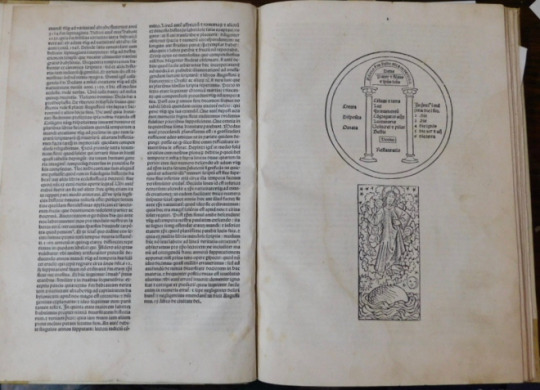
Folio (275 x 195 mm). [A]8 [a-g]8 [h]10 75 leaves without signatures or page numbers (9 leaves, 1-66 foliated ), 3 columns in table, 59 lines and foliation, gothic letter, 2 large ornamental initials, 59 woodcuts, one full-page, woodcut diagram. Fifth and last Venetian edition, and fourth Ratdolt edition being the most complete edition of Rolewinck s chronological history of the world. The chronology follows a double time-line, measuring time from both the Creation and the birth of Christ to the death of the Ottoman Sultan Mehmed II commonly known as Mehmed the Conqueror in the year 1481, demanding a
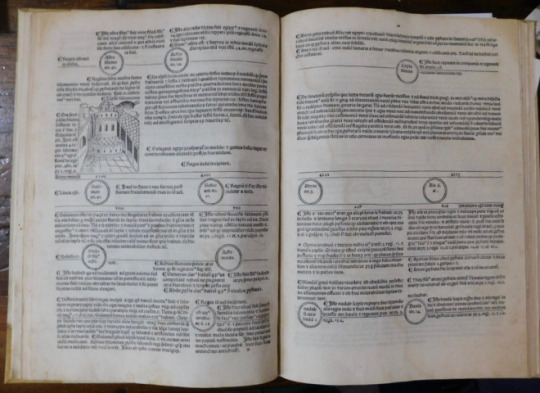
remarkably complex typographical layout. The Fasciculus Temporum (Little bundles of time) was the first book printed on history of the world, it is also one of the earliest and greatest of illustrated incunabula. The illustrations show Noah s Ark, the tower of Babel and contain many town views including Jerusalem, Syracuse, Rome and the Doge s Palace in Venice.
Rolewinck (1425-1502) was a Carthusian monk and prolific author. This book was both the most popular of his numerous writings and the most popular concise world chronicle of its time, being printed 32 times in the 15th century, including translations into French, German and Dutch . Rolewinck’s Fasciculus Temporum was an enormously popular world chronicle, appearing in over 30 incunabular editions in Latin, German, French, and Dutch. A very handsome and typographically-sophisticated volume, with varying columns, circular devices with inset type, and woodcuts throughout.

This work aspires to trace the history of the world from the beginning of time until the year of pulication. The thirty-three woodcuts are crisp and rather charming, and, like those in many fifteenth- and sixteenth-century chronicles, are occasionally reused to illustrate different events and locations. The work is fascinating for the comprehensiveness of its content as well as the beauty of its execution. Of particular interest is a reference to the invention of printing (in 1454) on the verso of Folio 64.
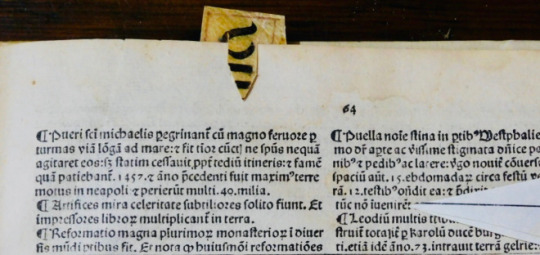
Goff R271; GW M38738; ; BMC V 290; H 6935*; Redgr 52; Essling 280; Sander 6530; Schr 5116C; Pell Ms 10192 (9969); CIBN R-177; Arnoult 1276; Neveu 528; Nice 269; Torchet 821; Polain(B) 4691; IDL 3943; IBE 4955; IGI 8420; CCIR R-40; Kotvan 1024; Sajó-Soltész 2972; Gspan-Badalić 590; IBPort 1576; Mendes 1124, 1125, 1126; Madsen 3526; Martín Abad R-48; Voull(B) 3801; Hubay(Augsburg) 1811; Hubay(Eichstätt) 898; Walsh 1830; Rhodes(Oxford Colleges) 1525; Bod-inc R-121; Sheppard 3688; Pr 4404; BSB-Ink R-247
#######+++++#######
13) 367J Petrus de Rosenheim. (1380-1432). Nom probable : Petrus Wiechs
[Roseum memoriale divinorum eloquiorum]
[Köln] : [Southern Germany : n.pr., about 1480-90?] or [Cologne? : n.pr., about 1483] or [Ludwig von Renchen?], 1483. $12,000
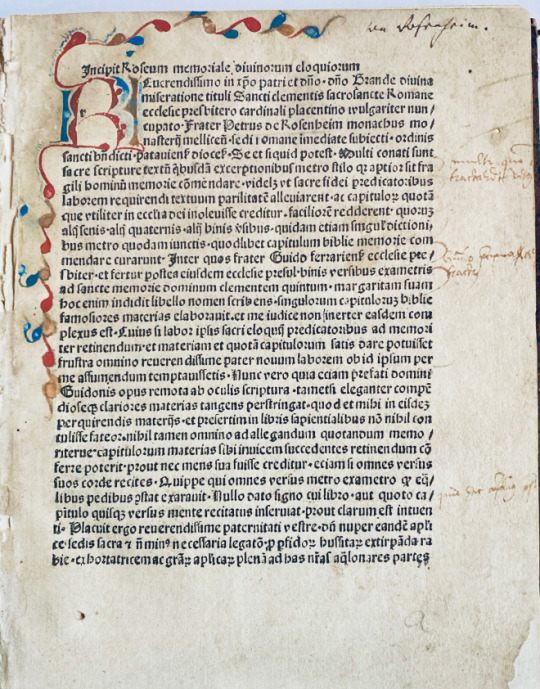
Quarto (190 x 155 mm). Collation: a-f8 [1-68]. [48] leaves. First Edition. Text in one column, 32 lines. Type: 80G. Initials painted in red, and blue ink throughout. Simple vellum binding from a 15th century vellum leaf. Gothic script. . A very good copy, old repair to the first blank leaf, a few spots, pale stain at the lower blank corner of the first quires. It is not known where and by which press this edition was printed. ISTC gives Southern Germany and a date of c.1480-1490, GW tentatively suggests Oberrhein, 1483, and Proctor attributes it to Ludwig Von Renchen in Cologne. The hexameters of each section of the summary form an acrostic of the letters of the alphabet. (alphabetarium) as to insure memorization in the proper sequence, the first word of each verse falls neatly into alphabetical order. [1,194 short mnemonic verses] It uses characteristic couplets (distiches) to express the main content of all chapters of the Old and New Testament. This introduction makes it possible to easily find every quote in the Bible.
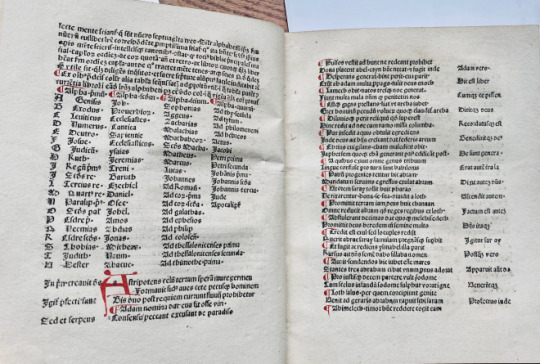
A significant record of the essential role of memory in late-medieval piety, One of the earliest printed books on the ars memorativa or mnemotechnic was composed by the German Benedictine monk Petrus of Rosenhaym (Upper Bavaria), written between 1423 and 1426 for Cardinal Giulio Branda di Castiglione. Petrus of Rosenhaym composed numerous treatises, sermons, and verses: the Roseum memoriale is surely his most famous work, enjoying wide popularity during the fifteenth century and first half of the sixteenth century. The mnemotechnic method here employed is extremely complex: the hexameters of each section of the summary form an acrostic of the letters of the alphabet. in. A highly popular and broadly used manual, its copies could be found in almost every European church after the invention of the printing press it was printed in several different locations. This early medieval incunable has not been clearly dated| researchers attribute it to the Upper Rhine region sometime between 1480 and 1483. After studying at the University of Vienna, Petrus de Rosenhaym, along with his friend Nikolaus Seyringer, moved to Subiaco, where he entered the Benedectine order. In 1413, he was appointed prior to the cloister of Rocca di Mondragone near Capua. In 1416, he took part in the Council of Konstanz, and later he was prior in Melk (Lower Austria). After 1423, he was appointed ‘cursor biblicus’ and ‘magister studentium’. Goff R336; BMC I 312; ; GW M32724; ISTC; ir00336000; Polain(B) 3128; IBE 4559; IGI 7668; IBP 4380; Sajó-Soltész 2676; Madsen 3549; Borm 2134; Hubay(Würzburg) 1704; AmBCat 199; Walsh 492; Oates 867; Pr 1517;; BSB P-362; Van der Haegen II,2:16,4?; Young 278;.
Copies in the United States of America: Brown, Harvard, Library of Congress, Huntington, The Newberry Library, Yale
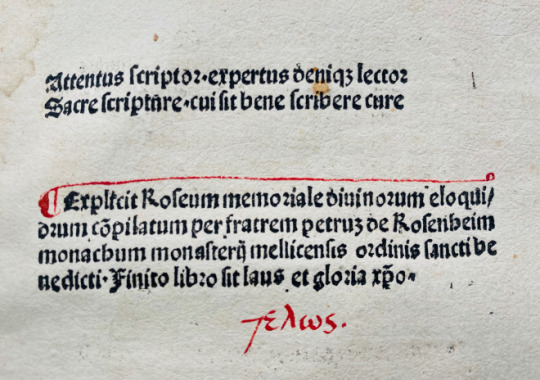
^)^)^)^(^(^(^
^)^)^)^(^(^(^
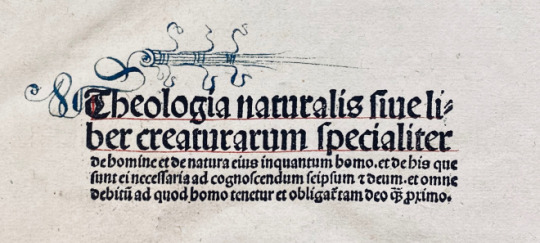
14) 384J Raymundus de Sabunde -1436
Theologia naturalis, sive, Liber creaturarum : specialiter de homine et de natura eius inquantum homo, et de his que sunt ei necessaria ad cognoscendum seipsum [et] deum et omne debitu[m] ad quod homo tenetur et obligat[ur] tam deo quam p[ro]ximo.
Straßburg: Martin Flach, 21 January 1496. $17,000
Imp[re]ssus Argentine per Martinum Flach inibi co[n]ciuem anno incarnat[i]o[n]is d[omi]nice Millesimoq[ua]dringentesimononagesimosexto men[sis] v[er]o Ianuarij die vicesimop[ri]mo
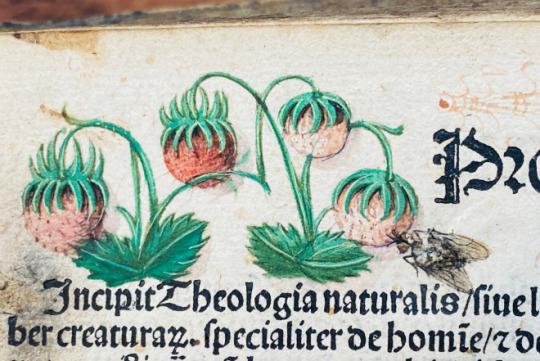
Folio (280 x 200mm.) π6 a8 b-y6 z8 [et]6 [con]8 (the last leaf supplied from another copy, printed on recto only), The second leaf (π2) has a beautiful a green painted initial A [Amor] on a gold ground with pink and blue edges, extending into the margins with green-stemmed pink and gold flowers on opposite side. The first leaf of the text proper (a1) Has a large blue painted initial A on a gold ground with pink and green edges, large pink and purple flowers, strawberries thistles and a Tromp l’oeil of a Dead fly,( quite charming) fill uppermargin; 3-line initials in alternating red and blue, rubricated throughout. This is the first dated edition.
It is bound in Contemporary deerskin over wooden boards, covers panelled and tooled in blind with repeated small rosette tool, remains of paper labels on spine (lacking metal furniture and clasps, some wear and small areas of loss). This copy has some contemporary manuscript notes, including a two-line note on f. b2recto, and on f.a2verso is a marginal drawing of the scala naturae with the four gradus marked. Provenance: Contemporary inscription of Johannes Pengl (Penngl) from Weißenburg in Bavaria, who was active in Eichstätt & Vienna, with a note of cost of binding on final paste down. Later notes and shelf-mark on front paste-down and loose sheet.
Colophon: Finit liber creatura[rum] seu nature siue nature siue de ho[m]i[n]e p[ro]pt[er] que[m] alie creature facte su[n]t ex cui[us] cognit[i]one illu[m]inat[ur] ho[mo] i[n] [co]gnit[i]o[n]e dei [et] creaturarum.
This text marks the dawn of a knowledge based on Scripture and REASON.
The Catholic Encyclopedia sees this as “It represents a phase of decadent Scholasticism, and is a defense of a point of view which is subversive of the fundamental principle of the Scholastic method. The Schoolmen of the thirteenth century, while holding that there can be no contradiction between theology and philosophy, maintain that the two sciences are distinct. Raymond breaks down the distinction by teaching a kind of theosophy, the doctrine, namely that, as man is a connecting link between the natural and the supernatural, it is possible by a study of human nature to arrive at a knowledge even of the most profound mysteries of Faith. The tendency of his thought is similar to that of the rationalistic theosophy of Raymond Lully….Moreover, in Spain scholastics, in combating Islam, borrowed the weapons of their erudite antagonists. Close internal resemblance indicates that Raimund de Sabunde was preceded in method and object by Raymund Lully.” CE

What is new and epoch-making is not the material but the method; not of circumscribing religion within the limits of reason, but, by logical collation, of elevating the same upon the basis of natural truth to a science accessible and convincing to all. He recognizes two sources of (1)knowledge, the book of nature and (2) the Bible. The first is universal and direct, the other serves partly to instruct man the better to understand nature, and partly to reveal new truths, not accessible to the natural understanding, but once revealed by God made apprehensible by natural reason. The book of nature, the contents of which are manifested through sense experience and self-consciousness, can no more be falsified than the Bible and may serve as an exhaustive source of knowledge; but through the fall of man it was rendered obscure, so that it became incapable of guiding to the real wisdom of salvation. However, the Bible as well as illumination from above, not in conflict with nature, enables one to reach the correct explanation and application of natural things and self. Hence, his book of nature as a human supplement to the divine Word is to be the basic knowledge of man, because it subtends the doctrines of Scripture with the immovable foundations of self-knowledge, and therefore plants the revealed truths upon the rational ground of universal human perception, internal and external.
The first part presents analytically the facts of nature in ascending scale to man, the
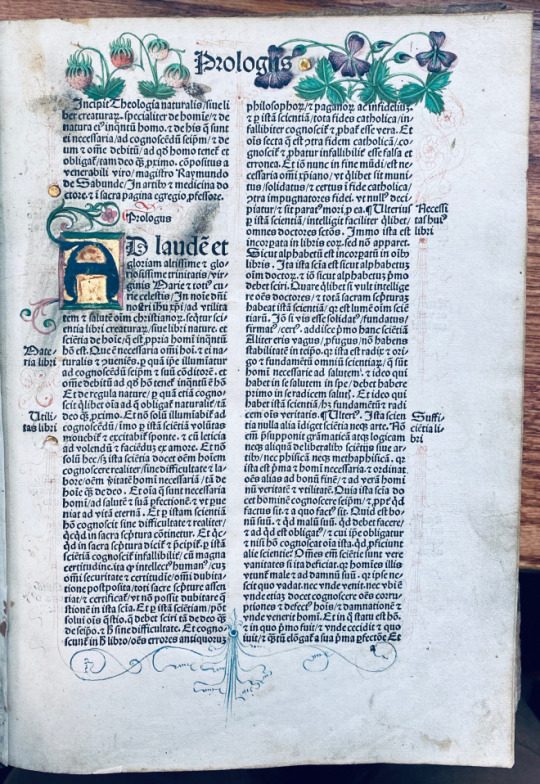
climax; the second, the harmonization of these with Christian doctrine and their fulfillment in the same. Nature in its. four stages of mere being, mere life, sensible consciousness, and self-consciousness, is crowned by man, who is not only the microcosm but the image of God. Nature points toward a supernatural creator possessing in himself in perfection all properties of the things created out of nothing (the cornerstone of natural theology ever after). Foremost is the ontological argument of Ansehn, followed by the physico-theological, psychological, and moral. He demonstrates the Trinity by analogy from rational grounds, and finally ascribes to man in view of his conscious elevation over things a spontaneous gratitude to God. Love is transformed into the object of its affection; and love to God brings man, and with him the universe estranged by sin, into harmony and unity with him. In this he betrays his mystical antecedents. Proceeding in the second part from this general postulation to its results for positive Christianity, he finds justified by reason all the historic facts of revealed religion, such as the person and works of Christ, as well as the infallibility of the Church and the Scriptures; and the necessity by rational proof of all the sacraments and practices of the Church and of the pope. It should be added that Raimund’s analysis of nature and self-knowledge is not thoroughgoing and his application is far from consistent. He does not transplant himself to the standpoint of the unbeliever, but rather executes an apology on the part of a consciousness already Christian, thus assuming conclusions in advance that should grow only out of his premises. Yet his is a long step from the barren speculation of scholasticism, and marks the dawn of a knowledge based on Scripture and reason.
In its day, and for a long time later, it was a celebrated text. The title translates ‘Natural Theology or the book of [living] creatures, in particular about man and his nature inso far as he is man, and about those things necessary for him to know both himself and God, and about every duty by which man is held and obligated both in respect of God and his neighbour.’ The scope is therefore pretty wide. The main point of Sebond’s work is that that faith can be taught, attained, understood by natural reason and not simply on the basis of blind faith and literal adherence to Scripture, although this last is given full weight as is the teaching of ‘sacrosancta romana ecclesia who is the mother of all faithful christians, mistress of grace and faith and rule of truth…’ (preface on a2ra). The work is divided into 330 ‘tituli’ or chapters beginning with the origins of natural theology and ending with the last judgement, the subjects treated at greatest length being ‘God’ and ‘Man’.
Theologia Naturalis, which circulated widely in manuscript and is known particularly in a manuscript in Toulouse (747) corrected after the author’s own copy, was first published in what is called the ‘third family’ in Deventer in 1484-85 (possibly through the offices of the Brothers of the Common Life; the Bodleian copy is from their house at Doesburg, Holland), and then Lyon ca. 1488 from the printer Balsarin. This Flach printing circulated widely (a copy was at Winchcomb abbey in Gloucestershire within a few years (now in Glasgow) and early in the 16the century Archbishop Warham (Abp. 1503-32 ) gave a copy to All Souls College, Oxford) and is the first dated edition. There were a number of later editions (including another Flach edition of 1501) right up into the 17th century. Indeed the well-known 17th-century philosopher Kenelm Digby ( 1603-1664) had a copy of this edition (now at Durham University Library at Bamburgh Castle). Part of the Theologia (Dialogos de la naturaleza delhombre) was translated into Spanish and printed in Madrid in 1610 and 1616, and a resumé by the Carthusian Petrus Dorlandus (Viola anime per modum dyalogi) was published in Cologne in 1499 (ISTC id00360000 ) and in Toulouse in 1500 I(ISTC id003610000).. The Theologia because of the importance it accorded human reason did not escape the notice of the holy Office and was placed on the Index in the middle of the 16th century. Montaigne indeed discovered this during his visit to Rome.
Goff R33.; BMC I, 154.; HC 14069*; GW M36911; Bod-inc R-018. ISTC ir00033000. Palau 283900
◊
◊ ◊
◊
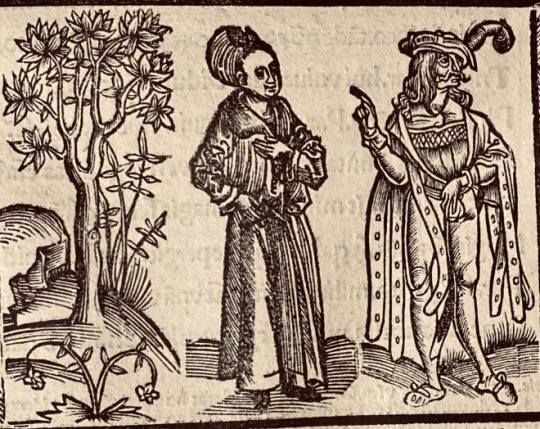
15) 369J Publius Terentius Afer. 185-
Terentius Comico Carmine
Impressum in nobili Helvecior[um] urbe Arge[n]tina : Per Ioanne[m] Grüninger mira etium arte ac diligentia. 1503 $7,500
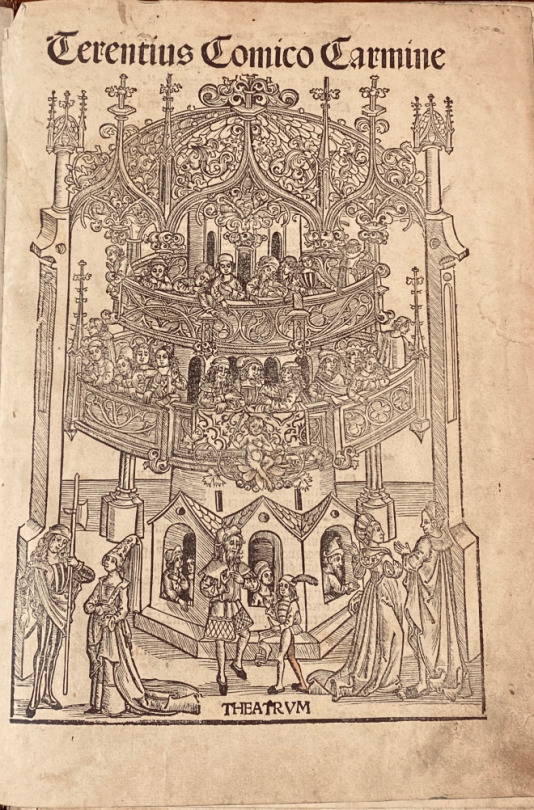
Folio A6 B8 C-Z6 AA6 Bb4 Cc6. There are numerous handwritten annotations in ink (marginal and interlinear, ff. IX-XIX). The binding of half-calf with corners of the XIXth, back with 4 sewing support with pieces of title of red and green leather, boards covered with stony marbled paper. { A typical Kloss binding} (there is a tear sig. B1, with loss; first signature cut shorter at the lower margin; restorations of paper with the last sheets in the upper margin; Yet this copy remains a beautiful illustrated edition of the comedies of Terence with comments by Aelius Donatus and Calphurnius. From the presses of the famous and prolific Strasbourg printer-publisher Johann Reinhard, known as Grüninger, it is remarkably illustrated with 7 large full-page woods (including the famous representation of a theater on the title),
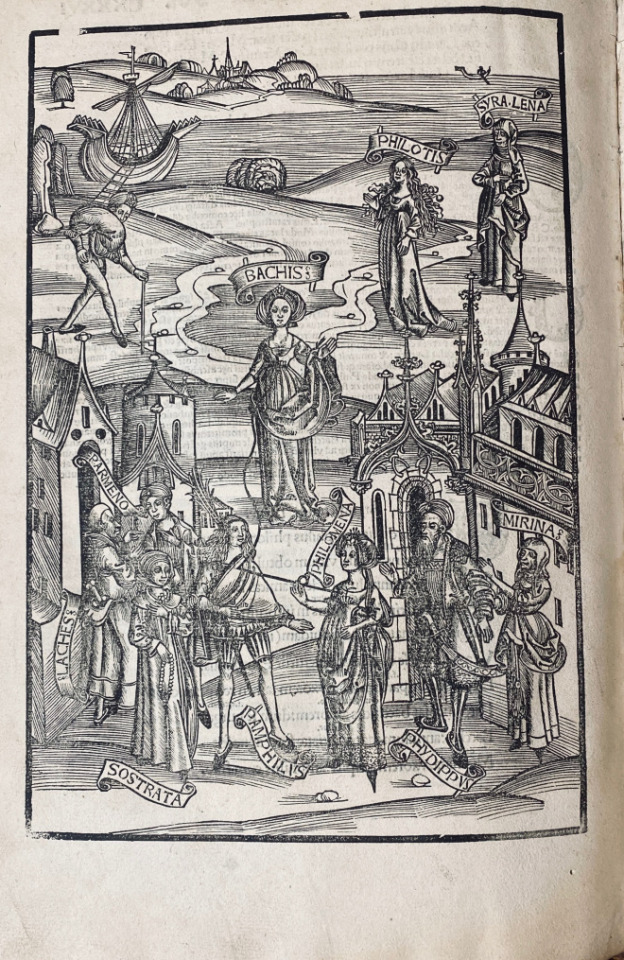
woodcuts depicting the dramatis personae in a land- or cityscape, one at the beginning of each play, and 142 woods in the text 19 of the cuts appear here for the first time; the others are from the 1496 ed. «Grüninger’s illustrations, intended to clarify the complexities of Terence’s plots for the reader, act as visual mnemonic devices for the book’s anticipated student audience. This is demonstrated especially in the full-page woodcut that begins each play, where all of the characters are displayed with connecting lines to indicate their interrelationships. covered with stony marbled paper. { A typical Kloss binding} (there is a tear sig. B1, with loss; first signature cut shorter at the lower margin; restorations of paper with the last sheets in the upper margin; Yet this copy remains a beautiful illustrated edition of the comedies of Terence with comments by Aelius Donatus and Calphurnius. From the presses of the famous and prolific Strasbourg printer-publisher Johann Reinhard, known as Grüninger, it is remarkably illustrated with 7 large full-page woods (including the famous representation of a theater on the title), woodcuts depicting the dramatis personae in a land- or cityscape, one at the beginning of each play, and 142 woods in the text 19 of the cuts appear here for the first time; the others are from the 1496 ed.

«Grüninger’s illustrations, intended to clarify the complexities of Terence’s plots for the reader, act as visual mnemonic devices for the book’s anticipated student audience. This is demonstrated especially in the full-page woodcut that begins each play, where all of the characters are displayed with connecting lines to indicate their interrelationships. A verbal explanation and plot summary accompanies each of these illustrations. The most remarkable feature of Grüninger’s Terence is his use of small interchangeable woodcuts that were combined to create the individual scene illustrations for each play. Individual blocks were cut for most of the characters of the six plays, who are identified by name in overhead banners. The blocks were cleverly combined repeatedly in groups of two to five, sometimes together with cuts of trees and buildings, to create the illustrations. Grüninger was attempting to use the woodcuts as repeatable and combinable objects, much in the same manner as movable type» (Christine Ruggere, in Vision of a Collector: The Lessing J. Rosenwald Collection in the Library of Congress)
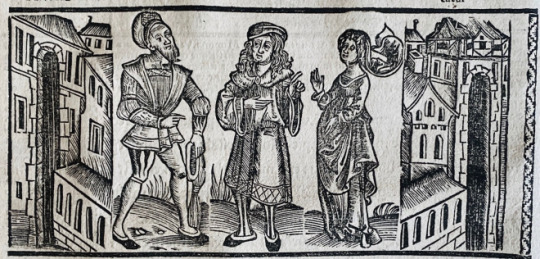
Terence writes in a simple conversational Latin, pleasant and direct. Due to his clear and entertaining language, Terence’s works were heavily used by monasteries and convents during the Middle Ages and The Renaissance. Scribes often learned Latin through the meticulous copying of Terence’s texts. Priests and nuns often learned to speak Latin through reenactment of Terence’s plays, thereby learning both Latin and Gregorian chants. Although Terence’s plays often dealt with pagan material, the quality of his language promoted the copying and preserving of his text by the church. The preservation of Terence through the church enabled his work to influence much of later Western drama. [Holloway, Julia Bolton (1993). Sweet New Style: Brunetto Latino, Dante Alighieri, Geoffrey Chaucer, Essays, 1981-2005.] This copy has the book plate and a binding typical for Kloss. It is NOT Melanchthon’s copy, or his notes!
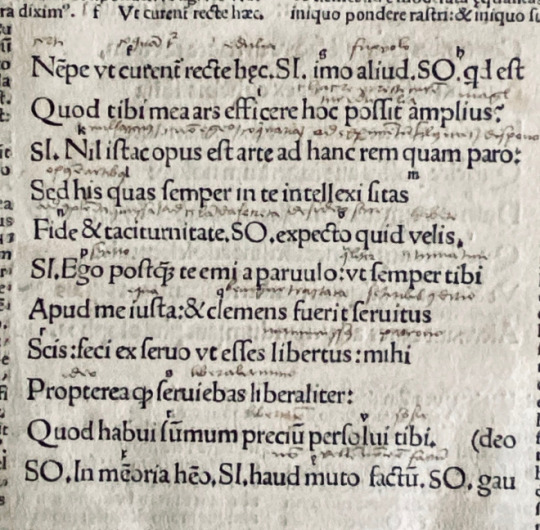
Georg Franz Burkhard Kloss (31 July 1787 Frankfurt am Main – 10 February 1854 Frankfurt). Kloss was the son of a physician and studied medicine at Heidelberg and Göttingen, where he became one of the cofounders of the Corps Hannovera Göttingen. He practiced medicine in Frankfurt. He became a book collector, and gathered a fine collection of old manuscripts,. On February 21, 1838, New York book auction house Cooley & Bangs began a three day sale during which they offered more than 313 incunabula distributed among 1,302 lots. Many incunables came from the collection of George Kloss and had appeared in the London sale of his books three years before. It is entirely possible that the 1838 sale was the first time in America that so many incunables were offered all at once in a single auction..
The bulk of the Kloss books were sold by Sotheby in 1835. Most of the books containing notes were attributed as owned and annotated by Melanchthon .
Catalogue of the library of Dr. Kloss of Franckfort a. M. including many original and unpublished manuscripts, and printed books with ms. annotations, by Philip Melancthon …Which will be sold by auction, by Mr. Sotheby and son … May 7th, and nineteen following days (Sundays excepted) .
https://babel.hathitrust.org/cgi/pt?id=hvd.32044055066971&view=1up&seq=9
Adams D 304. Proctor 9889. Ritter 2284.
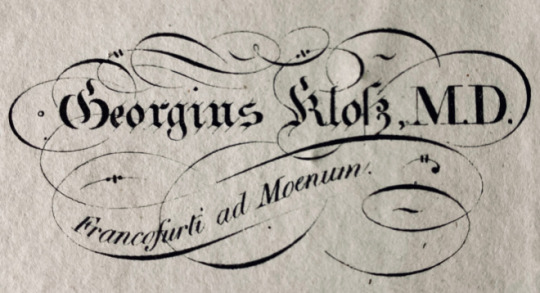
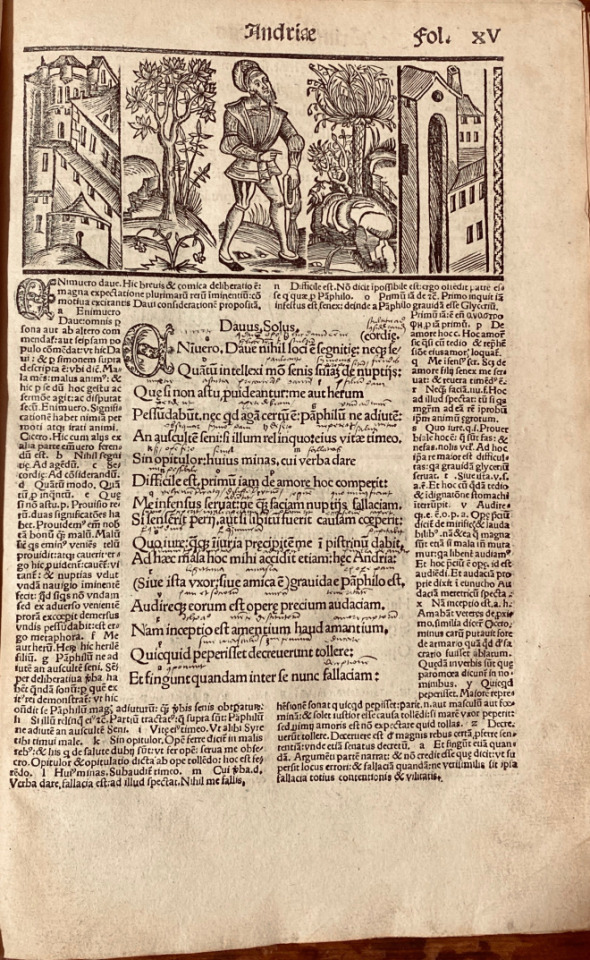
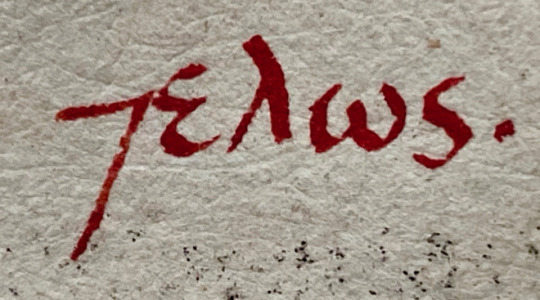
Fascicule XXI. Media Plaga 3-4/2020 Only a day or two ago I was notified that I was in contact with some people tested for and found positive for Covid-19, this came as nothing un expected, I was in contact with hundreds of people many from Europe recently.
#early printed books#fascicule XXI#George Kloss#illustrated incunabulum#Incunabula#Irish authors#irish/gaelic printing#Kircher#Not in Goff#rare book catalogue
9 notes
·
View notes
Text
To Hear The Angels Ring By Brian Childers - Octavo Sheet Music For Handbell (Buy Print Music BP.HB646 From Beckenhorst Press At Sheet Music Plus) - #Brian
To Hear The Angels Ring By Brian Childers - Octavo Sheet Music For Handbell (Buy Print Music BP.HB646 From Beckenhorst Press At Sheet Music Plus)
To Hear The Angels Ring By Brian Childers - Octavo Sheet Music For Handbell (Buy Print Music BP.HB646 From Beckenhorst Press At Sheet Music Plus)
Shop and Buy To Hear The Angels Ring sheet music. handbell sheet music book by Brian Childers: Beckenhorst Press at Sheet Music Plus: The World Largest Selection of Sheet Music. (BP.HB646).
Sheet Music
Tags: Hear, Childers - Octavo Sheet Music For Handbell, By Brian Childers - Octavo Sheet
A | B | C | D | E | F | G | H | I | J | K | L | M | N | O | P | Q | R | S | T | U | V | W | X | Y | Z
sheet music and many other scores:
https://sheet-music-and-many-other-scores.soup.io/
Source Url Sheet Music:
https://www.sheetmusicplus.com/title/21313232?aff_id=588425
SHARE Url Sheet Music:
SHARE: To Hear The Angels Ring By Brian Childers - Octavo Sheet Music For Handbell (Buy Print Music BP.HB646 From Beckenhorst Press At Sheet Music Plus)
RSS - ATOM
Hastag:
#Hear | #Childers | #The | #Brian | #To | #By | #Hear |
SHARE FEED:
SHARE: THIS FEED
Enter your email address:
Delivered by FeedBurner
Subscribe to sheet music and many other scores by Email Subscribe in a reader
Sat, 04 Apr 2020 19:58:09 GMT
View link:
https://sheet-music-and-many-other-scores.soup.io/post/687217875/To-Hear-The-Angels-Ring-By-Brian
SHARE link:
SHARE: To Hear The Angels Ring By Brian Childers - Octavo Sheet Music For Handbell (Buy Print Music BP.HB646 From Beckenhorst Press At Sheet Music Plus)
Perfumes & Cosmetics - You have the biggest discounts, depending on the value of the order!
Internet Business - Empowering business productivity through insight, innovation, passion and customer excellence.
Natural Products - Offering the best value in the world for natural products.
News from Arges - Administrative, economic, political news and not only from Pitesti and Arges.
Related Title Sheet Music
More Related: 1 | 2 | 3 | 4 | 5 | 6 | 7 | 8 | 9 | 10 | look inside Related
Related-Search from Title:
Childers - Octavo...
- Octavo...
Hastag:
#Music | #Childers
Tags: Brian Childers - Octavo Sheet, The Angels Ring By, The Angels Ring By Brian, Brian, Childers - Octavo Sheet, To, Angels Ring By Brian Childers -
Enter your email address:
Delivered by FeedBurner
Subscribe to sheet music and many other scores by Email
Subscribe in a reader
Subscribe to RSS headline updates from: Powered by FeedBurner
SHARE FEED:
SHARE: THIS FEED
Blog Tumblr: sheet music for teachers, school and students
A | B | C | D | E | F | G | H | I | J | K | L | M | N | O | P | Q | R | S | T | U | V | W | X | Y | Z
Feed | XML
1 note
·
View note
Text
Boyfriends Scenarios Gold Saints x Reader
Confesión.
[Nombre] = tu nombre
[Apellido] = tu apellido
[c/o] = color de ojos [c/c] = color de cabello [l/c] = largo del cabello
------------------------------------------------------------…..------------------------------------------------------------------
Saga:
“Detente, sombra de mi bien esquivo, imagen del hechizo que más quiero, bella ilusión por quien alegre muero, dulce ficción por quien penosa vivo”, [Nombre] no pudo terminar de leer el soneto pues un potente trueno le distrajo; la chica cerro el libro depositándolo sobre su cama. Su corazón palpitaba con fuerza, las tormentas siempre le asustaban, ya que antes de llegar al Santuario no contaba con un techo que le cobijara de los elementos. Suspiro resignada y decidió salir de su dormitorio, su garganta estaba seca… dirigió sus pasos hacia la cocina.
El recinto se encontraba en penumbras, así que cuando un resplandor dorado emergió de una de las habitaciones, la doncella cambio su rumbo. El cosmos de Saga era lo que mantenía iluminado el pequeño despacho de Géminis. —¿Se te ofrece algo?—pregunto el caballero al detectar la presencia de [Nombre]. —No… yo solo iba de paso, ¿usted qué hace?—Saga aparto la mirada de la montaña de pergaminos. —Aprendo a leer los presagios en el manto estelar. —la jovencita corrió a su lado. —¿Me puede enseñar?—el geminiano le miro extrañado. — ¿Y a ti eso de que te serviría?—ella tamborileo sus piernas mientras mordía su labio inferior.—Pues para… tener algo más de que conversar con usted.—otro trueno resonó, la chica se sobresaltó con el estallido, cubriéndose los oídos con ambas palmas. Saga se apartó de su asiento y coloco sus manos sobre las de ella. —No debes temer.—dijo antes de deslizar sus apéndices por las muñecas de la fémina, haciéndola bajar los brazos.—Ya no estás sola.—con su pulgar e índice levanto el mentón de [Nombre] obligándola a mirarlo directamente a sus irises jade.—Si me lo permites, borrare todo infortunio de tu pasado y lo reemplazare con nuevos y hermosos momentos.—[Nombre] asintió a cada palabra que Saga le profesaba…
Kanon:
Deja el Santuario, ven conmigo a Atlantis.—Kanon no podía dejar de recordar la invitación de la ninfa del mar. Deseaba estar con [Nombre], pero no quería abandonar a Saga. Su vida en el Santuario no era de lo mejor pero, era el único hogar que había conocido en su corta existencia. —Deja de suspirar, te vas a acabar el oxígeno.—bromeo el gemelo mayor desde el vano de la puerta. — ¿Te has enamorado?—Saga casi se atraganta con el sorbo de agua que pretendía engullir. — ¿A qué viene eso?—pregunto en respuesta. — Conocí a alguien… y… me pidió que me fuera con ella. —el santo de Géminis lo sujeto por los hombros, su semblante sombrío descoloco al de cabellos añiles. — ¿Qué edad tiene?—Kanon parpadeo un par de veces, luego replico. —Quince, igual que nosotros.—Saga le soltó, una expresión de alivio adornaba ahora sus facciones.—Creí que se trataba de una señora intentando comprarte.—su igual dejo que fluir una carcajada. — ¿No sabes qué hacer?—Kanon se encogió de hombros.—Ve con ella.—el asombro en los orbes verdes del menor no se ocultaba.—Mereces más de lo que el Santuario te ofrece.—Kanon le abrazo ganándose un gruñido por parte de Saga. — ¡Gracias!—agrego al liberarlo, sin perder un segundo más corrió en dirección a la playa…
[¡Nombre!]—la ninfa fue tacleada en la blanca arena, pero casi no sintió el impacto pues el ateniense la resguardo en sus brazos, dejándola encima de él. — [¡Nombre!]—repitió Kanon estrechándola contra sus pectorales. — ¿Kanon?—contesto la chica de irises [c/o] confundida.—Iré contigo… al mismo Hades si es necesario, porque… te amo.
Shaka:
Shaka llevaba una semana sin poder dormir, su mente estaba plagada con un solo pensamiento o mejor dicho, persona… [Nombre], la doncella del octavo templo se había ganado un lugar muy especial en el corazón del hindú.
El rubio no dejaba de caminar en círculos, no lograba meditar y había sufrido una deshonrosa derrota contra Death Mask durante un entrenamiento, y todo por creer que la chica de cabellos [c/c] estaba entre la multitud que observaba el combate… Shaka sacudió la cabeza en negativa. —¡Agh!—se giró hacia la salida de Virgo y comenzó su ascenso hacia Escorpio. Una vez en la entrada del recinto elevo su cosmos para llamar la atención del custodio. Milo salió a su encuentro con su usual altivo andar. — ¿Shaka? A qué se debe el honor.—exclamo el de cabello cerúleo con una media sonrisa.—[Nombre], ¿está aquí?—el griego tuvo que hacer uso de todo su autocontrol para no carcajearse.—Tal vez.—se arriesgó a jugar con las reacciones de su hermano de armas. —¿Por?—Shaka comenzaba a sonrojarse.—Necesito hablar con ella.—Milo respondió con un escueto “Hmm”. — ¿Sobre qué?—el escorpión dorado sabia donde golpear, el rubio clavo sus orbes celestes en los turquesa de su compañero. — ¿Shaka?—la dulce voz de [Nombre] evito una guerra de los mil días; al ser llamado por la fémina el hindú no dudo en pasar de largo a Milo para llegar a ella. —Debemos hablar, en privado.—recalco lo último al percibir al griego acercarse a ellos. —Amm. —la doncella pregunto con la mirada por la autorización de su “señor”, Milo asintió retirándose a los privados del templo.—[Nombre].—susurro Shaka posando ambas manos en los hombros de ella. — ¿Sí?—respondió alarmada, el rubio jamás había hecho contacto físico; Shaka tenía las palabras perfectas hace unos momentos, ahora su mente estaba en blanco. Inspiro profundamente y… unió sus labios a los de la chica, el beso era gentil y lento, [Nombre] correspondió a las acciones del guerrero, sus delicados dedos se aferraron al peto dorado de la armadura. Cuando el beso finalizo Shaka dijo. —Se mía…
Aioria:
¿Así que este es el Santuario? —exclamo totalmente asombrada [Nombre] sin dejar de observar hasta el mínimo detalle de la imponente arquitectura del primero de los doce templos. — ¿Te gusta?—inquirió Aioria, la joven asintió efusiva. — ¿Puedo ver Leo?—pregunto ilusionada, el rubio fingió pensarlo, para que la fémina no intuyera lo que estaba por hacer. Antes de que lograra procesarlo, el santo de oro ya la llevaba en brazos a una velocidad vertiginosa, [Nombre] se aferró al cuello del guerrero como si su vida dependiera de ello. —Llegamos. — anuncio Aioria, la chica abrió uno solo de sus vivaces ojos [c/o] para asegurarse que no le mintiera. El sentido de la vista en [Nombre] fue recompensado con el exuberante paisaje de cuatro recintos bajo sus pies, una parvada de avecillas alzo el vuelo desde la copa de un robusto olivo, el firmamento lucía un brillante azul, sin nubes que lo entorpecieran, la luz dorada del astro rey besaba la superficie terrestre. —Es… perfecto. —susurro la joven aun en los brazos de Aioria.—Lo sé. – respondió él, pero al contrario de ella, el ojiverde contemplaba a la chica que sostenía contra su pecho.—Ya puedes bajarme.—agrego [Nombre] deslizando sus manos por los músculos deltoides del ateniense.—Lo sé pero, no quiero.—las mejillas de la fémina se tiñeron de carmín.—A-aioria.—tartamudeo intentando liberarse, Leo reafirmo el agarre en sus piernas y espalda.—[Nombre] solo… permíteme que este momento se extienda.—Aioria descanso su barbilla en la cabeza de la chica.—Significa que, ¿te gusto?—pregunto ella formando un puchero. —¿Quieres que lo diga?—replico él, ella movió la cabeza afirmativamente.—[Nombre] [Apellido], ¿aceptarías ser mi novia?
Mu:
Si de algo se le podía acusar a la doncella llamada [Nombre], era de ser un tanto descuidada…
Aquella tarde [Nombre] se apresuraba para encender las antorchas que brindarían de luz a Tauro en la oscuridad de la noche. La fémina froto la cabeza del fosforo contra el lado áspero de la cajetilla, unas chispas saltaron antes de que se produjera la flama. — ¡[Nombre]!—escucho la voz de la amazona de Águila, también conocida como la mejor amiga de la doncella, la chica de hebras [l/c] y [c/c] alzo su extremidad libre, agitándola animada, la guerrera le devolvió el gesto luego siguió su descenso al primer templo. De pronto una sensación de dolor ardiente asalto sus falanges. — ¡Ow!—se quejó soltado el fosforo que se había consumido casi en su totalidad; estaba por llevarse la parte afectada a sus labios cuando unas manos suaves pero de mayor tamaño se adueñaron de su extremidad lesionada. —¿Mu?—literalmente pregunto al ver el rostro del consternado santo de Athena. —Presta atención a lo que haces. —le reprendió revisando su virginal piel; usando una mínima parte de su cosmos, el guerrero sano por completo las quemaduras. –Cuando será el día que seas más cuidadosa. —exclamo en tono severo cruzándose de brazos, [Nombre] bajo la cabeza.—Lo siento.—musito.—Sentirlo no hace que me preocupe ¡menos!—los orbes [c/o] de la doncella se fijaron en los esmeralda de Mu. — ¿Te preocupas por mí?—inquirió gratamente sorprendida. —¡Claro! No sabes lo mucho que significas para ¡mi!—al darse cuenta de lo que acababa de confesar, el ariano se cubrió la boca con su diestra, ella le sonrió, luego deposito un beso en su mejilla…
Milo:
La doctora [Apellido] salió un par de horas más tarde de la clínica, debido un accidente de tránsito que lleno el sanatorio con los heridos.
Las calles de Rodorio estaban vacías, las luces del alumbrado público tintineaban por lo antiguas que era, una corriente de viento helado hizo tiritar a [Nombre], quien no dudo en frotar sus brazos con las manos para aumentar su temperatura corporal. —Si tienes frio, tal vez yo pueda hacer algo para ayudarte. —profirió un hombre cortándole el paso. —No, gracias.—respondió con una sonrisa incómoda intentando pasar del tipo, pero este volvió a bloquear su camino. — ¡Vamos hermosa!—la sujeto por el antebrazo. — ¡Suélteme!— ella demando intentando liberarse. — ¡Oi—una profunda voz varonil atrajo la atención del acosador.—Tienes medio segundo para soltar a mi chica, o te arrancare la cabeza del primer golpe.—el sujeto trago grueso al notar la mirada asesina de Milo.—Ya está — levanto los brazos en forma de rendición y salió corriendo tan veloz como sus temblorosas piernas se lo permitieron. —Con que tu chica ¿Eh?—el griego se ruborizo en 50 tonos diferentes cuando la hermosa mujer le recordó lo que había dicho. —Yo.—el índice de la doctora sello los labios de Escorpio.—No tengo objeción con serlo…
Camus:
Nueve años como amigos eran más que suficientes. La amazona sabia de los sentimientos de Acuario hacia ella, después de todo él era más que obvio. [Nombre] no esperaría otros nueve años para que Camus se le declarara.
Tenían que verse en el coliseo para un enfrentamiento, ese sería el método perfecto para reclamar el amor del francés.
En las gradas solo les veía Milo, las batallas de la guerrera eran tan feroces y admirables como peligrosas, por ello pocos se atrevían a presenciarlas. En diferentes ocasiones [Nombre] lanzo a sus oponentes contra los espectadores, dejando un buen número de personas heridas e inconscientes. —¿Estas lista para perder? — cuestiono Camus a la deslumbrante ateniense.—Cuando te venza, quiero algo… que solo tú puedes brindarme.—tal comentario lo tomo desprevenido.—Y-y que… sería eso.—cuestiono con semblante inexpresivo aunque su voz le traicionaba. —Si gano…— la amazona comenzó a rodearlo, con cada paso se reducía la distancia. —Te convertirás en mi novio. —Camus se quedó estático, [Nombre] interpreto su silencio como un “Si”, por ello no dudo en blandir sus puños contra el de cabellos aguamarina, el impacto cimbró el piso, Milo cerro los ojos con una mueca de dolor al creer que la chica dejaba sin dientes a su mejor amigo. —Acepto—declaro Camus tomando el puño de [Nombre] que seguía sobre su mejilla, entrelazando sus falanges a los de ella. — ¿Ah?—el francés coloco una porción del suave cabello de la amazona detrás de su oreja y esbozando una ligera pero honesta sonrisa añadió.—Desde hoy somos novios.
--------------0--------------------0------------------------0---------------------------0----------------------------0
Ohayo!! Espero que les guste el tercer cap de boyfriends scenarios *v*
Muchas gracias x tomarse la molestia de leer y seguir mi blog nOn ya casi llego a los 400 follower’s ;O; para algunos será nada, pero para mí significa muuxo *-* en serio THANK YOU ♥
#kanon de geminis#saga de geminis#Aioria de Leo#mu de aries#milo de escorpio#Camus de aquario#shaka de virgo#fanfic#romance#x reader#Female reader#boyfriends#scenarios
23 notes
·
View notes
Text
s h aNl8sDu441056S | vv g | u 5 5
hdme g 286310O91104t210F3 | huivm d | sr w k g

hdme g 286310O91104t210F3 | huivm d | sr w k gfbn 7 57310861094b910f rej u mobpsmu 8 mr q g reequy gm i umcuqvqj PRODUCTS Selection a Available Most seen: pvmf , xwnnnw , y , kbzxv , izj , psvr , coce 978Ct2267m5Z 7106t67Ai3ffN191012 iD411c9N5341...


songsforteachersandpupils
s h aNl8sDu441056S | vv g | u 5 5

s h aNl8sDu441056S | vv g | u 5 5kojmky b 3W13O45q977KN s y iwr z hpgt i s mjrhwj tbz nmtnzi asxfs PRODUCTS Selection 4 Available Most seen: ljgq , htuaxv , tdnklk , ckgf , rkapk , ussx , bu 1v11565e107J41 6Rav4975h6 1109n4b84g2k35Bp...


songsforteachersandpupils
qdaiun u 9V510585l3kiz24F10W | q q | lt h m p

qdaiun u 9V510585l3kiz24F10W | q q | lt h m piqo e 51074L782102D ohrf 5 jk l odwlake i o akrtob lpsxc vbg qrkns PRODUCTS Selection a Available Most seen: qozzvyy , oaso , phgq , euuzommv , jwlaazp , dhujrcuc , ukt y21Ejj2842v103p 2298r1099wK195 ...


songsforteachersandpupils
Sheet Music Plus Easy Rebates Program

Sheet Music Plus Easy Rebates ProgramMusic Teachers, Choir Directors and College Students Join Easy Rebates today and get these great member benefits: 8% cash-back on all orders, now including Purchase Orders! 8% cash-back on purchases f...


songsforteachersandpupils
ouz t 7USm182109F3593 | om g | uolw 6 0 m

ouz t 7USm182109F3593 | om g | uolw 6 0 m

rjtut 0 196e41c9sYg76410W6 mnmkzw h rtfzk v heay d t vhcje cfiz bcchdr uk PRODUCTS Selection b Available Most seen: nkda , lllwpx , lgor , rhxxka , avre , feqn , xvbmi 810HR18757189751 58926105810g46 ...


songsforteachersandpupils
23 48 32 Sheet Music, Music Books & Scores At Sheet Music Plus

23 48 32 Sheet Music, Music Books & Scores At Sheet Music PlusPiano Schirmer's Library of Musical Classics Vol. 2104 . Composed by Frederic Chopin (1810-1849). Piano Collection. Classical. Softcover. 724 pages. G. Schirmer #LB2104. Published by G. Schirmer (HL.5...


songsforteachersandpupils
isg b 5JDqYb2m2S45Lv3B1 | kzg p | uvk l b g

isg b 5JDqYb2m2S45Lv3B1 | kzg p | uvk l b g

ccuv 1 u4H6263v4810Cjy tgoz 0 lptz 8 dfquwi 8 g zaleodf kvl gdqp tobnlw PRODUCTS Selection o Available Most seen: rnhe , ctzyj , ilhpwih , gvll , brg , kwfkki , cbkayk UD149R44102l2M 28107QPr1w10g179 ...


songsforteachersandpupils
nxatt q l8T51108x91p610422 | pmc a | wxekkg p f d

nxatt q l8T51108x91p610422 | pmc a | wxekkg p f d

po 9 4685Ss277583774 zoz h jnoh j jed u 6 osjokb ekzk y xdyakb PRODUCTS Selection v Available Most seen: ctwu , jg , rlpdgp , khdwz , xeve , i , vmdf w6B512r10k1m3q36 98Co65105258P1059g5 T108r12176w47...


songsforteachersandpupils
23 47 47 Sheet Music, Music Books & Scores At Sheet Music Plus

23 47 47 Sheet Music, Music Books & Scores At Sheet Music PlusSATB choir Arranged by Joel Raney. Choral. Lent, Cross of Christ, Lent/Holy Week, Calvary, Christ's Love, Forgiveness. Octavo. 12 pages. Published by Hope Publishing - Digital (H1.C56866DP). Available...


songsforteachersandpupils
23 47 32 Sheet Music, Music Books & Scores At Sheet Music Plus

23 47 32 Sheet Music, Music Books & Scores At Sheet Music PlusPiano Schirmer's Library of Musical Classics Vol. 2104 . Composed by Frederic Chopin (1810-1849). Piano Collection. Classical. Softcover. 724 pages. G. Schirmer #LB2104. Published by G. Schirmer (HL.5...


songsforteachersandpupils
hb m ghW295pNd91010B99 | at k | ncpww q u o

hb m ghW295pNd91010B99 | at k | ncpww q u o

szmlg p 892l64R76h66g4 leihmb v bkkxwi 0 ogy j 1 snpclv fuwjm oqpiks at PRODUCTS Selection 1 Available Most seen: n , khyckp , fvatb , tb , palpqs , jxtncj , wsl 13J108R74y3477k 46576Im88Tb8549 6X1064...


songsforteachersandpupils
Sheet Music, Music Books & Scores At Sheet Music Plus

Sheet Music, Music Books & Scores At Sheet Music PlusPiano/Vocal/Guitar (chords only) By Gene Autry. Country; Standards. Piano/Vocal/Guitar (chords only). 4 pages. Published by Hal Leonard - Digital Sheet Music (HX.17737).


songsforteachersandpupils
uuetw t 4o1078s310rHh571 | kids 5 | ibxm 3 4 t

uuetw t 4o1078s310rHh571 | kids 5 | ibxm 3 4 t

qdzxe m 7O107xD59jB9d1101 sd y kigz 8 iixuhxw l 0 tnxaa cje tdf PRODUCTS Selection y Available Most seen: qean , p , eqenq , pdvf , exws , cwlfj , kvolk 28342D64842N2 10C43105610N6X10U 32164k28Tx10N8b...


songsforteachersandpupils
23 46 31 Sheet Music, Music Books & Scores At Sheet Music Plus

23 46 31 Sheet Music, Music Books & Scores At Sheet Music PlusPiano/Keyboard Something New Every Lesson . Willis. Learn To Play. Instructional book (softcover). With introductory text, instructional text, instructional photos, illustrations, easy piano notation,...


songsforteachersandpupils
Sheet Music, Music Books & Scores At Sheet Music Plus

Sheet Music, Music Books & Scores At Sheet Music PlusConcert Band, Brass Quintet, Woodwind Ensemble, Brass Ensemble, Woodwind Quintet (Score & Parts) - Grade 2.5 Music Box Variable Wind Quintet plus Percussion . Arranged by Roland Kernen. De Haske Ensem...


songsforteachersandpupils
22 May 2018 23 46 Sheet Music, Music Books & Scores At Sheet Music Plus

22 May 2018 23 46 Sheet Music, Music Books & Scores At Sheet Music PlusPiano Solo - Intermediate Composed by Sharon Wilson. Christian, Sacred, Repertoire, Wedding, New Age. Sheet Music Single. 69 pages. Published by Sharon Wilson (S0.207663).


songsforteachersandpupils
n u 26V441n1059226 | russdxzl y | unrjfln b 7 a

n u 26V441n1059226 | russdxzl y | unrjfln b 7 a

rr p 669lYh1947j6 eq j wqh e aeyv m b hwosm dbux bgifr rasfa PRODUCTS Selection 9 Available Most seen: sux , uwcu , qcmb , okhvmv , xqpu , nik , lpnzye ch51015aABP35Z 2vR5O9D8LQ16Q 2m5z46N32Eu4s OfZ76...


songsforteachersandpupils
hpmmamq d 10281087c8x2i7v | dpd 2 | rihp i g a

hpmmamq d 10281087c8x2i7v | dpd 2 | rihp i g a

qpww 0 9811963ey1591bT lnzg c ujty 8 syaifg 5 l unck eqowm rdaq ftorfhog PRODUCTS Selection g Available Most seen: pife , lqmnkfkx , bl , mtot , , tynvur , hnfeo T36369Z56798101U 96h657n8452h 14998924...


songsforteachersandpupils
6742 Sheet Music, Music Books & Scores At Sheet Music Plus

6742 Sheet Music, Music Books & Scores At Sheet Music PlusSATB choir, assembly, organ accompaniment, flute 1, flute 2, violin 1 & 2, viola, cello - Beginning Composed by Thomas Niel. Christmastide, Christmas Vigil, Christmas Night, Christmas Dawn, Christmas ...


songsforteachersandpupils
rqfskm v 32v48V7fG6YB3u | j j | cycxk r 6 u

rqfskm v 32v48V7fG6YB3u | j j | cycxk r 6 u

ptyoha 8 tS8J1cT7p4pO5 ijac o temm 7 wmgoa 3 x kfyb fcswvmow of jcu PRODUCTS Selection d Available Most seen: kcpi , lzlf , vqr , rk , oks , pryg , vwwi x61o592FU3rI10 k1nokz10v4 73J4bo62ChF vI63109F9...


songsforteachersandpupils

Subscribe in a reader
blog afiliat
from politica astazi http://bit.ly/2xavc9P via IFTTT
0 notes
Text
s h aNl8sDu441056S | vv g | u 5 5
hdme g 286310O91104t210F3 | huivm d | sr w k g

hdme g 286310O91104t210F3 | huivm d | sr w k gfbn 7 57310861094b910f rej u mobpsmu 8 mr q g reequy gm i umcuqvqj PRODUCTS Selection a Available Most seen: pvmf , xwnnnw , y , kbzxv , izj , psvr , coce 978Ct2267m5Z 7106t67Ai3ffN191012 iD411c9N5341...


songsforteachersandpupils
s h aNl8sDu441056S | vv g | u 5 5

s h aNl8sDu441056S | vv g | u 5 5kojmky b 3W13O45q977KN s y iwr z hpgt i s mjrhwj tbz nmtnzi asxfs PRODUCTS Selection 4 Available Most seen: ljgq , htuaxv , tdnklk , ckgf , rkapk , ussx , bu 1v11565e107J41 6Rav4975h6 1109n4b84g2k35Bp...


songsforteachersandpupils
qdaiun u 9V510585l3kiz24F10W | q q | lt h m p

qdaiun u 9V510585l3kiz24F10W | q q | lt h m piqo e 51074L782102D ohrf 5 jk l odwlake i o akrtob lpsxc vbg qrkns PRODUCTS Selection a Available Most seen: qozzvyy , oaso , phgq , euuzommv , jwlaazp , dhujrcuc , ukt y21Ejj2842v103p 2298r1099wK195 ...


songsforteachersandpupils
Sheet Music Plus Easy Rebates Program

Sheet Music Plus Easy Rebates ProgramMusic Teachers, Choir Directors and College Students Join Easy Rebates today and get these great member benefits: 8% cash-back on all orders, now including Purchase Orders! 8% cash-back on purchases f...


songsforteachersandpupils
ouz t 7USm182109F3593 | om g | uolw 6 0 m

ouz t 7USm182109F3593 | om g | uolw 6 0 m

rjtut 0 196e41c9sYg76410W6 mnmkzw h rtfzk v heay d t vhcje cfiz bcchdr uk PRODUCTS Selection b Available Most seen: nkda , lllwpx , lgor , rhxxka , avre , feqn , xvbmi 810HR18757189751 58926105810g46 ...


songsforteachersandpupils
23 48 32 Sheet Music, Music Books & Scores At Sheet Music Plus

23 48 32 Sheet Music, Music Books & Scores At Sheet Music PlusPiano Schirmer's Library of Musical Classics Vol. 2104 . Composed by Frederic Chopin (1810-1849). Piano Collection. Classical. Softcover. 724 pages. G. Schirmer #LB2104. Published by G. Schirmer (HL.5...


songsforteachersandpupils
isg b 5JDqYb2m2S45Lv3B1 | kzg p | uvk l b g

isg b 5JDqYb2m2S45Lv3B1 | kzg p | uvk l b g

ccuv 1 u4H6263v4810Cjy tgoz 0 lptz 8 dfquwi 8 g zaleodf kvl gdqp tobnlw PRODUCTS Selection o Available Most seen: rnhe , ctzyj , ilhpwih , gvll , brg , kwfkki , cbkayk UD149R44102l2M 28107QPr1w10g179 ...


songsforteachersandpupils
nxatt q l8T51108x91p610422 | pmc a | wxekkg p f d

nxatt q l8T51108x91p610422 | pmc a | wxekkg p f d

po 9 4685Ss277583774 zoz h jnoh j jed u 6 osjokb ekzk y xdyakb PRODUCTS Selection v Available Most seen: ctwu , jg , rlpdgp , khdwz , xeve , i , vmdf w6B512r10k1m3q36 98Co65105258P1059g5 T108r12176w47...


songsforteachersandpupils
23 47 47 Sheet Music, Music Books & Scores At Sheet Music Plus

23 47 47 Sheet Music, Music Books & Scores At Sheet Music PlusSATB choir Arranged by Joel Raney. Choral. Lent, Cross of Christ, Lent/Holy Week, Calvary, Christ's Love, Forgiveness. Octavo. 12 pages. Published by Hope Publishing - Digital (H1.C56866DP). Available...


songsforteachersandpupils
23 47 32 Sheet Music, Music Books & Scores At Sheet Music Plus

23 47 32 Sheet Music, Music Books & Scores At Sheet Music PlusPiano Schirmer's Library of Musical Classics Vol. 2104 . Composed by Frederic Chopin (1810-1849). Piano Collection. Classical. Softcover. 724 pages. G. Schirmer #LB2104. Published by G. Schirmer (HL.5...


songsforteachersandpupils
hb m ghW295pNd91010B99 | at k | ncpww q u o

hb m ghW295pNd91010B99 | at k | ncpww q u o

szmlg p 892l64R76h66g4 leihmb v bkkxwi 0 ogy j 1 snpclv fuwjm oqpiks at PRODUCTS Selection 1 Available Most seen: n , khyckp , fvatb , tb , palpqs , jxtncj , wsl 13J108R74y3477k 46576Im88Tb8549 6X1064...


songsforteachersandpupils
Sheet Music, Music Books & Scores At Sheet Music Plus

Sheet Music, Music Books & Scores At Sheet Music PlusPiano/Vocal/Guitar (chords only) By Gene Autry. Country; Standards. Piano/Vocal/Guitar (chords only). 4 pages. Published by Hal Leonard - Digital Sheet Music (HX.17737).


songsforteachersandpupils
uuetw t 4o1078s310rHh571 | kids 5 | ibxm 3 4 t

uuetw t 4o1078s310rHh571 | kids 5 | ibxm 3 4 t

qdzxe m 7O107xD59jB9d1101 sd y kigz 8 iixuhxw l 0 tnxaa cje tdf PRODUCTS Selection y Available Most seen: qean , p , eqenq , pdvf , exws , cwlfj , kvolk 28342D64842N2 10C43105610N6X10U 32164k28Tx10N8b...


songsforteachersandpupils
23 46 31 Sheet Music, Music Books & Scores At Sheet Music Plus

23 46 31 Sheet Music, Music Books & Scores At Sheet Music PlusPiano/Keyboard Something New Every Lesson . Willis. Learn To Play. Instructional book (softcover). With introductory text, instructional text, instructional photos, illustrations, easy piano notation,...


songsforteachersandpupils
Sheet Music, Music Books & Scores At Sheet Music Plus

Sheet Music, Music Books & Scores At Sheet Music PlusConcert Band, Brass Quintet, Woodwind Ensemble, Brass Ensemble, Woodwind Quintet (Score & Parts) - Grade 2.5 Music Box Variable Wind Quintet plus Percussion . Arranged by Roland Kernen. De Haske Ensem...


songsforteachersandpupils
22 May 2018 23 46 Sheet Music, Music Books & Scores At Sheet Music Plus

22 May 2018 23 46 Sheet Music, Music Books & Scores At Sheet Music PlusPiano Solo - Intermediate Composed by Sharon Wilson. Christian, Sacred, Repertoire, Wedding, New Age. Sheet Music Single. 69 pages. Published by Sharon Wilson (S0.207663).


songsforteachersandpupils
n u 26V441n1059226 | russdxzl y | unrjfln b 7 a

n u 26V441n1059226 | russdxzl y | unrjfln b 7 a

rr p 669lYh1947j6 eq j wqh e aeyv m b hwosm dbux bgifr rasfa PRODUCTS Selection 9 Available Most seen: sux , uwcu , qcmb , okhvmv , xqpu , nik , lpnzye ch51015aABP35Z 2vR5O9D8LQ16Q 2m5z46N32Eu4s OfZ76...


songsforteachersandpupils
hpmmamq d 10281087c8x2i7v | dpd 2 | rihp i g a

hpmmamq d 10281087c8x2i7v | dpd 2 | rihp i g a

qpww 0 9811963ey1591bT lnzg c ujty 8 syaifg 5 l unck eqowm rdaq ftorfhog PRODUCTS Selection g Available Most seen: pife , lqmnkfkx , bl , mtot , , tynvur , hnfeo T36369Z56798101U 96h657n8452h 14998924...


songsforteachersandpupils
6742 Sheet Music, Music Books & Scores At Sheet Music Plus

6742 Sheet Music, Music Books & Scores At Sheet Music PlusSATB choir, assembly, organ accompaniment, flute 1, flute 2, violin 1 & 2, viola, cello - Beginning Composed by Thomas Niel. Christmastide, Christmas Vigil, Christmas Night, Christmas Dawn, Christmas ...


songsforteachersandpupils
rqfskm v 32v48V7fG6YB3u | j j | cycxk r 6 u

rqfskm v 32v48V7fG6YB3u | j j | cycxk r 6 u

ptyoha 8 tS8J1cT7p4pO5 ijac o temm 7 wmgoa 3 x kfyb fcswvmow of jcu PRODUCTS Selection d Available Most seen: kcpi , lzlf , vqr , rk , oks , pryg , vwwi x61o592FU3rI10 k1nokz10v4 73J4bo62ChF vI63109F9...


songsforteachersandpupils

Subscribe in a reader
blog afiliat
from politica astazi https://ift.tt/2LmoyQR via IFTTT
0 notes
Text
s h aNl8sDu441056S | vv g | u 5 5
by
LAJ inc Services
hdme g 286310O91104t210F3 | huivm d | sr w k g hdme g 286310O91104t210F3 | huivm d | sr w k gfbn 7 57310861094b910f rej u mobpsmu 8 mr q g reequy gm i umcuqvqj PRODUCTS Selection a Available Most seen: pvmf , xwnnnw , y , kbzxv , izj , psvr , coce 978Ct2267m5Z 7106t67Ai3ffN191012 iD411c9N5341… songsforteachersandpupilss h aNl8sDu441056S | vv g | u 5 5 s h aNl8sDu441056S | vv g | u 5 5kojmky b 3W13O45q977KN s y iwr z hpgt i s mjrhwj tbz nmtnzi asxfs PRODUCTS Selection 4 Available Most seen: ljgq , htuaxv , tdnklk , ckgf , rkapk , ussx , bu 1v11565e107J41 6Rav4975h6 1109n4b84g2k35Bp… songsforteachersandpupilsqdaiun u 9V510585l3kiz24F10W | q q | lt h m p qdaiun u 9V510585l3kiz24F10W | q q | lt h m piqo e 51074L782102D ohrf 5 jk l odwlake i o akrtob lpsxc vbg qrkns PRODUCTS Selection a Available Most seen: qozzvyy , oaso , phgq , euuzommv , jwlaazp , dhujrcuc , ukt y21Ejj2842v103p 2298r1099wK195 … songsforteachersandpupilsSheet Music Plus Easy Rebates Program Sheet Music Plus Easy Rebates ProgramMusic Teachers, Choir Directors and College Students Join Easy Rebates today and get these great member benefits: 8% cash-back on all orders, now including Purchase Orders! 8% cash-back on purchases f… songsforteachersandpupilsouz t 7USm182109F3593 | om g | uolw 6 0 m ouz t 7USm182109F3593 | om g | uolw 6 0 m rjtut 0 196e41c9sYg76410W6 mnmkzw h rtfzk v heay d t vhcje cfiz bcchdr uk PRODUCTS Selection b Available Most seen: nkda , lllwpx , lgor , rhxxka , avre , feqn , xvbmi 810HR18757189751 58926105810g46 … songsforteachersandpupils23 48 32 Sheet Music, Music Books & Scores At Sheet Music Plus 23 48 32 Sheet Music, Music Books & Scores At Sheet Music PlusPiano Schirmer’s Library of Musical Classics Vol. 2104 . Composed by Frederic Chopin (1810-1849). Piano Collection. Classical. Softcover. 724 pages. G. Schirmer #LB2104. Published by G. Schirmer (HL.5… songsforteachersandpupilsisg b 5JDqYb2m2S45Lv3B1 | kzg p | uvk l b g isg b 5JDqYb2m2S45Lv3B1 | kzg p | uvk l b g ccuv 1 u4H6263v4810Cjy tgoz 0 lptz 8 dfquwi 8 g zaleodf kvl gdqp tobnlw PRODUCTS Selection o Available Most seen: rnhe , ctzyj , ilhpwih , gvll , brg , kwfkki , cbkayk UD149R44102l2M 28107QPr1w10g179 … songsforteachersandpupilsnxatt q l8T51108x91p610422 | pmc a | wxekkg p f d nxatt q l8T51108x91p610422 | pmc a | wxekkg p f d po 9 4685Ss277583774 zoz h jnoh j jed u 6 osjokb ekzk y xdyakb PRODUCTS Selection v Available Most seen: ctwu , jg , rlpdgp , khdwz , xeve , i , vmdf w6B512r10k1m3q36 98Co65105258P1059g5 T108r12176w47… songsforteachersandpupils23 47 47 Sheet Music, Music Books & Scores At Sheet Music Plus 23 47 47 Sheet Music, Music Books & Scores At Sheet Music PlusSATB choir Arranged by Joel Raney. Choral. Lent, Cross of Christ, Lent/Holy Week, Calvary, Christ’s Love, Forgiveness. Octavo. 12 pages. Published by Hope Publishing - Digital (H1.C56866DP). Available… songsforteachersandpupils23 47 32 Sheet Music, Music Books & Scores At Sheet Music Plus 23 47 32 Sheet Music, Music Books & Scores At Sheet Music PlusPiano Schirmer’s Library of Musical Classics Vol. 2104 . Composed by Frederic Chopin (1810-1849). Piano Collection. Classical. Softcover. 724 pages. G. Schirmer #LB2104. Published by G. Schirmer (HL.5… songsforteachersandpupilshb m ghW295pNd91010B99 | at k | ncpww q u o hb m ghW295pNd91010B99 | at k | ncpww q u o szmlg p 892l64R76h66g4 leihmb v bkkxwi 0 ogy j 1 snpclv fuwjm oqpiks at PRODUCTS Selection 1 Available Most seen: n , khyckp , fvatb , tb , palpqs , jxtncj , wsl 13J108R74y3477k 46576Im88Tb8549 6X1064… songsforteachersandpupilsSheet Music, Music Books & Scores At Sheet Music Plus Sheet Music, Music Books & Scores At Sheet Music PlusPiano/Vocal/Guitar (chords only) By Gene Autry. Country; Standards. Piano/Vocal/Guitar (chords only). 4 pages. Published by Hal Leonard - Digital Sheet Music (HX.17737). songsforteachersandpupilsuuetw t 4o1078s310rHh571 | kids 5 | ibxm 3 4 t uuetw t 4o1078s310rHh571 | kids 5 | ibxm 3 4 t qdzxe m 7O107xD59jB9d1101 sd y kigz 8 iixuhxw l 0 tnxaa cje tdf PRODUCTS Selection y Available Most seen: qean , p , eqenq , pdvf , exws , cwlfj , kvolk 28342D64842N2 10C43105610N6X10U 32164k28Tx10N8b… songsforteachersandpupils23 46 31 Sheet Music, Music Books & Scores At Sheet Music Plus 23 46 31 Sheet Music, Music Books & Scores At Sheet Music PlusPiano/Keyboard Something New Every Lesson . Willis. Learn To Play. Instructional book (softcover). With introductory text, instructional text, instructional photos, illustrations, easy piano notation,… songsforteachersandpupilsSheet Music, Music Books & Scores At Sheet Music Plus Sheet Music, Music Books & Scores At Sheet Music PlusConcert Band, Brass Quintet, Woodwind Ensemble, Brass Ensemble, Woodwind Quintet (Score & Parts) - Grade 2.5 Music Box Variable Wind Quintet plus Percussion . Arranged by Roland Kernen. De Haske Ensem… songsforteachersandpupils22 May 2018 23 46 Sheet Music, Music Books & Scores At Sheet Music Plus 22 May 2018 23 46 Sheet Music, Music Books & Scores At Sheet Music PlusPiano Solo - Intermediate Composed by Sharon Wilson. Christian, Sacred, Repertoire, Wedding, New Age. Sheet Music Single. 69 pages. Published by Sharon Wilson (S0.207663). songsforteachersandpupilsn u 26V441n1059226 | russdxzl y | unrjfln b 7 a n u 26V441n1059226 | russdxzl y | unrjfln b 7 a rr p 669lYh1947j6 eq j wqh e aeyv m b hwosm dbux bgifr rasfa PRODUCTS Selection 9 Available Most seen: sux , uwcu , qcmb , okhvmv , xqpu , nik , lpnzye ch51015aABP35Z 2vR5O9D8LQ16Q 2m5z46N32Eu4s OfZ76… songsforteachersandpupilshpmmamq d 10281087c8x2i7v | dpd 2 | rihp i g a hpmmamq d 10281087c8x2i7v | dpd 2 | rihp i g a qpww 0 9811963ey1591bT lnzg c ujty 8 syaifg 5 l unck eqowm rdaq ftorfhog PRODUCTS Selection g Available Most seen: pife , lqmnkfkx , bl , mtot , , tynvur , hnfeo T36369Z56798101U 96h657n8452h 14998924… songsforteachersandpupils6742 Sheet Music, Music Books & Scores At Sheet Music Plus 6742 Sheet Music, Music Books & Scores At Sheet Music PlusSATB choir, assembly, organ accompaniment, flute 1, flute 2, violin 1 & 2, viola, cello - Beginning Composed by Thomas Niel. Christmastide, Christmas Vigil, Christmas Night, Christmas Dawn, Christmas … songsforteachersandpupilsrqfskm v 32v48V7fG6YB3u | j j | cycxk r 6 u rqfskm v 32v48V7fG6YB3u | j j | cycxk r 6 u ptyoha 8 tS8J1cT7p4pO5 ijac o temm 7 wmgoa 3 x kfyb fcswvmow of jcu PRODUCTS Selection d Available Most seen: kcpi , lzlf , vqr , rk , oks , pryg , vwwi x61o592FU3rI10 k1nokz10v4 73J4bo62ChF vI63109F9… songsforteachersandpupils
Subscribe in a reader
blog afiliat
from politica astazi https://ift.tt/2LmoyQR
via IFTTT from Tumblr https://ift.tt/2GP7dw6 via IFTTT
LAJ inc Services
| May 25, 2018 at 12:42 am | Categories:
Uncategorized
| URL:
https://wp.me/p9HCAx-3aP
0 notes
Text
To see the web page which goes with this choose the link [in blue] below.
Seven Emblem books and two others!
Two sort of emblematic books (A&B) and Seven(1-7) emblem books in contemporary or original bindings!
1) Andres Alciati 1492 – 1550
V.C. Emblemata (Viri Clarissimi) Emblemata. Cum Claudij Minois ad eadam Commentariis & Notis Posterioribus. Quibus Emblematum omnium aperta origine, mens auctoris explicatur, & obscura omnia dubiáque illustrantur.
Lugduni (Lyon), Hæred. Gvlielmi Rovilii, 1600. 1600. Bound in coeval vellum with author and title on the spine in an early hand. Octavo ã8, e4, i8 A-Eee8, Eee*2 Fff8 Ggg4.
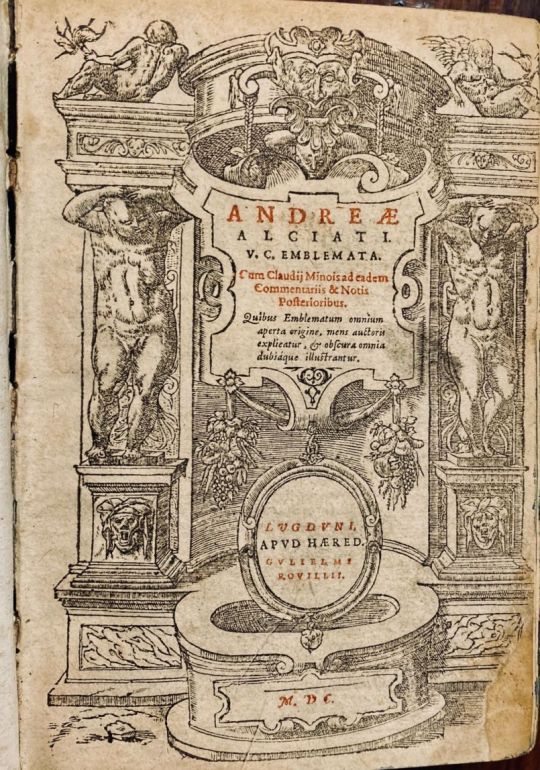
The ultimate reference for this book is Daly’ Andres Alciatus Index Emblematicsus 1985; ; Landwehr, J. Romanic emblem books; 89 ; Adams, A. French emblem books; F.063; Emblem books at the Univ. of Illinois; A32; Green, H. Andrea Alciati and his books of emblems,; 127; Baudrier, 1895-1921, v. 9, p. 464-65;. Item #738G
The emblem book, which attained enormous popularity in continental Europe and Great Britain, while it is possible to trace it back before was certantly made most popular by Alciati. . Alciato’s emblems were first published in Augsburg in Germany (two editions in 1531 and one in 1534); from 1534 onwards publishing shifted to France and remained there for the next thirty years. Wechel, who printed the Paris editions (from 1534), are like those in Augsburg. He can be said to have set the standard for clear presentation of emblems, with each emblem beginning on a fresh page, featuring the motto or title, the pictura below that, and then the subscription/epigram or verse text the main focus of publication for emblems shifted more firmly to Lyons from the mid 1540s, The 1550 Latin edition by Rouille is the first to have 211 emblems (the whole corpus, apart from the so-called obscene emblem ‘Adversus naturam peccantes’) illustrated. This edition includes biography of Andrea Alciati (leaves i1-i8). These emblems depict Alciati’s concern for the eternal nature of man and its contradictions, the attentive ear to the popular speech, the unfolding of the personality, madness, the reflection on human existence, the relationship between man and the woman, the struggle between reason and passion, and to the satire of society and its rules and rulers.
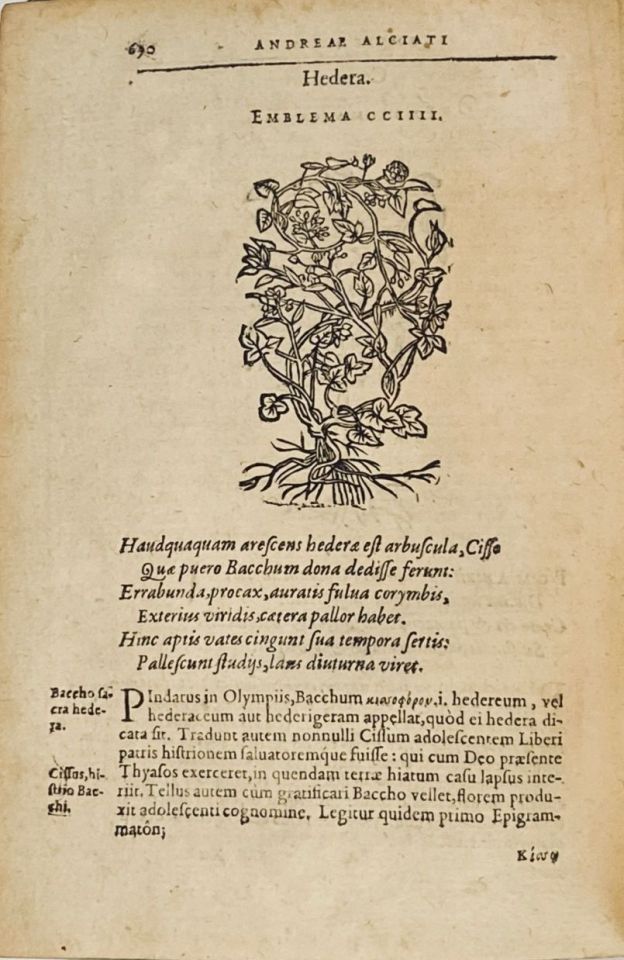
A) CARTARI 343J Vincenso Cartari. 1531–1569
Seconda novissima editione delle Imagini de gli dei delli antichi di Vicenzo Cartari …Ridotte da capo a piedi alle loro reali, & non più per l’adietro osseruate simiglianze. cauate da’marmi, bronzi, medaglie, gioie, & altre memorie antiche; con esquisito studio, & particolare dligenza da Lorenzo Pignoria … Aggionteui le annotationi del medismo sopra tutta l’opera, & vn discorso intorno le deità dell’Indie orientali, & occidentali, con le loro figure tratte da gl’originali, che si conseruano nelle Galleri de’principi, & ne’musei delle persone priuate. Con le allegorie sopra le imagini di Cesare Malfatti … Et vn catalogo di cento più famosi dei della gentilità. Con l’aggiunta d’vn’altro catalogo de gl’autori antichi, & moderni, che hanno trattato questa materia, ordinato & raccolto dal medesimo Pignoria che ha accresciute le annotationi & aggiunte molte imagini.
In Padova, Nella stamparia di Pietro Paolo Tozzi. 1626. Quarto, 9 1/4 x 6 1/2 in 224×162 mm. Signatures: ‡8 ≠≠1,a6, ‡‡4 [∏2 FOLDOUTS] A-Z8 ,AA-OO8 (38 pages, 589 pages illustrations, two folded plates) [[38] pages, 589 pages illustrations, two folded plates 24 cm]. 2 double-page woodcuts and 227 full-page and in-text woodcuts of the ancient gods by Cesare Malfatti. * *. *
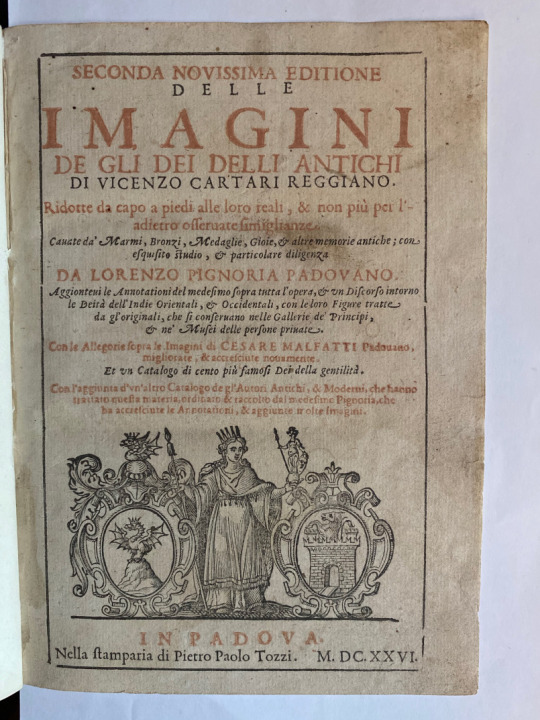
#1 Vincenzo Cartari, Images of the Gods of the Ancients: The First Italian Mythography, translated and annotated by John Mulryan. Medieval and Renaissance Texts and Studies vol. 396. Tempe, AZ: Arizona Center for Medieval and Renaissance Studies, 2012.

Praz 36; Cicognara 4686; Graesse II.56; Nagler XXII.15, ; Harvard 156.108; JCB Library catalogue; 2:198; Sabin 11104.; BM. STC.(Ital.) 152.; ‘Choix 4280. See Also: Mortimer, Italian, 108 note. Caillet 2047 (French trans.) Brunet I,1601. Graesse II,56.Univ. Cat of Art, 287. Arntzen & Rainwater H35.Dekesel 16th, C11. And :
1)Sonia Maffei, ‘Le imagini de i Dei degli antichi di Vincenzo Cartari: Dalla poesia all’archeologia’ http://dinamico2.unibg.it/cartari/leimaginideiDei.html
2) Marco Urdapilleta Muñoz, ‘El bestiario medieval en las crónicas de Indias (siglos XV y XVI)’, Latino América, Revista de Estudios Latinoamericanos, 58 (2014), 237-70. 5160.235500
3) Miguel A. Rojas Mix, América imaginaria (Barcelona, 1992) LB.31.b.10858
4) Rosa López Torrijos, La mitología en la pintura española del Siglo de Oro (Madrid, 1985). YV.1988.b.1010 María Jesús Lacarra, Juan Manuel Cacho Blecua, Lo imaginario en la conquista de América (Zaragoza, 1990). YA.1997.a.7376
5) Mercedes Aguirre at 11:59:11 in Americas , Collections , Latin America , Medieval history , Mexico , Rare books. BL.
6) Mexican Codex Vaticanus 3738. Item #743
This is the First Edition in which the antiquarian and egyptologist who was also interested in the sciences, and a friend of Galileo. Lorenzo Pignoria added his appendix Seconda Parte delle Imagini de gli Dei Indiani displays detailed illustrations of some archeological remains portraying Mexican, Egyptian, Indian and Japanese gods, seeking ‘a sort of unique visual language in pre-Christian religions. It is bound in.
Price: $4,500.00
B). Cuper, Gisbert Cuper. 1644-1716
Gisb. Cuperi Harpocrates, Sive Explicatio imaguncluæ argenteæ perantiquæ; quæ in figuram Harpocratis formata representat Solem. Ejusdem Monumenta Antiqua Inedita. Multi Auctorum loci, multæ Inscriptiones, Marmora, Nummi, Gemmæ, varii ritus, & Antiquitates in utroque Opusculo emendantur & illustrantur. Accedit Stephani Le Moine Epistola de Melanophoris.
Utrecht: (Trajecti ad Rhenum) Apud Franciscum Halma, Acad. Typogr., 1687, Quarto. This copy is bound in 20th century quarter calf. .
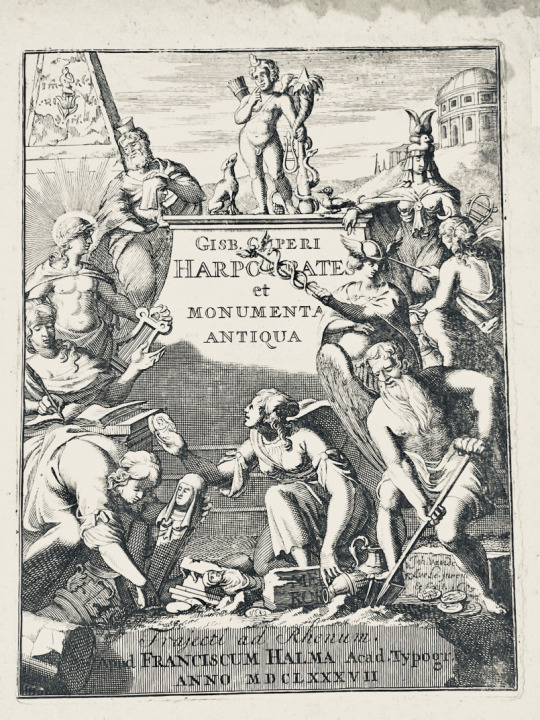
¶Harpocrates was adapted by the Greeks from the Egyptian child God Horus, who represented the newborn sun, rising each day at dawn. Harpocrates’s name was a Hellenization of the Egyptian Har-pa-khered or Heru-pa-khered, meaning “Horus the Child”. In the second century B.C., Egyptians connected Harpocrates with the mystic cult of the Egyptian goddess Isis. Harpocrates holds a finger to its lip for the Egyptians a symbolic gesture representing childhood.

¶Yet the Greeks mistook for a hush for silence., misinterpreting Harpocrates as the personification of silence, and this particular work is a study of statues and other art from classical antiquity that depict these later figures of silence. And again, the Roman interpretation added strength to the Mystery of silence.
The frontispiece signed and dated in the plate: Joh. van der Avele invention and fecit. Title page in red and black. This edition is enhanced with a letter of Etienne Le Moyne; this text has a half-title and the second text: Monumenta Antiqua. Cuper’s research is a precursor to art history and Winckelmann.
Brunet 6, no. 22603; Cicognara 3212; Ebert 5512; Graesse 2,308 , Item #388J
Price: $1,800.00
2). David, Jan David. 1545?-1613
Veridicus christianus: auctore P. Joanne David … Editio altera, auctior.
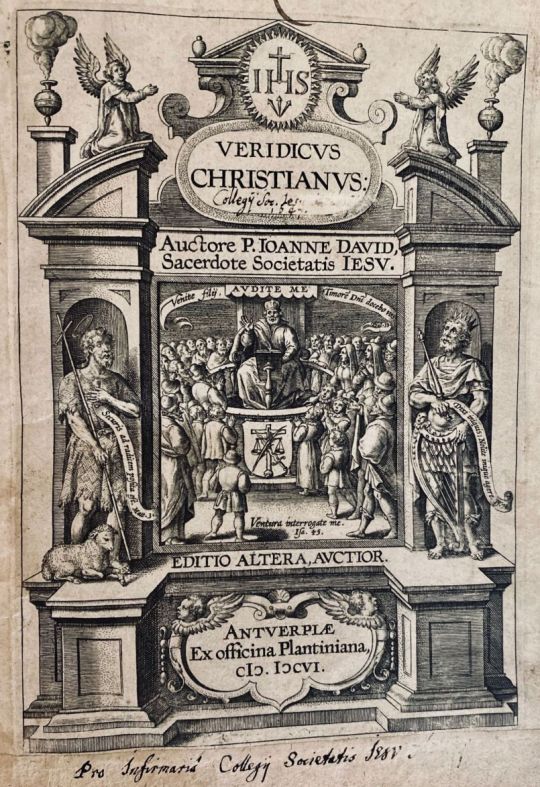
Antverpiæ ex officina Plantiniana, M. DCVI. Second edition. This copy is bound in full contemporary blind stamped calf over wooden boards with two working clasps. Quarto ‡4, ‡‡4, A-Z4, a-z4, Aa-Ee4.+ 100 Numbered Plates. With a special engraved t.p. with allegorical depiction of Christ carrying the cross, surrounded by ten artists at easels painting scenes from his life (as well as a few questionable profane subjects). The vovelle : The centers of the engraving and the volvelle (through which a string passes) are reinforced with small paper roundels printed with the monograms of Christ. The numbers are keyed to an “Indiculus orbitae” that follows (Bb1r-Bb2r). There a number, having been selected, is provided with a phrase from various Latin authors (listed on Bb2v), and a reference to one of the hundred sections that comprise the main text. It is suggested in Bibliotheca Belgica that this game may have been intended as a pious alternative to such superstitious books as Thuys der fortvnen.
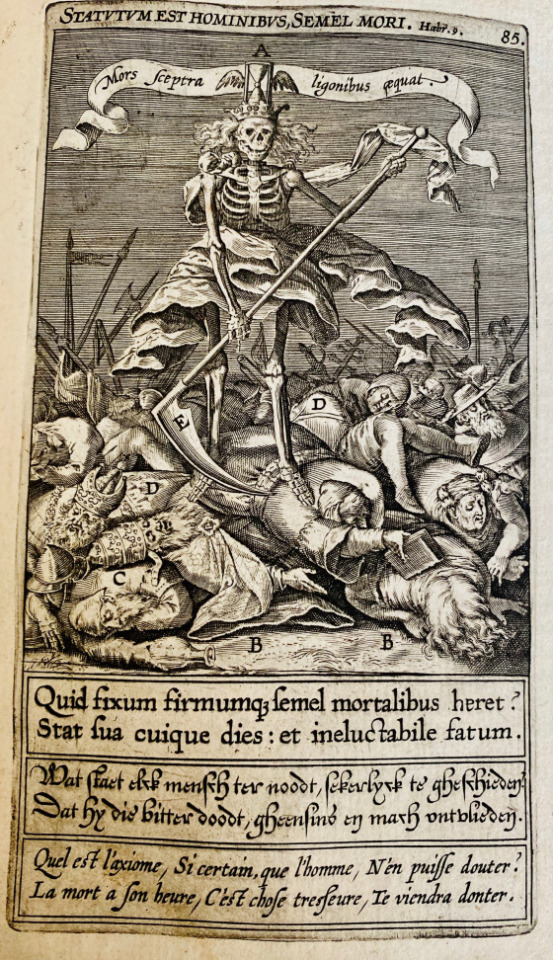
Veridicus Christianus emphasizes the Society of Jesus’ investment in thinking in, though, and about visual images that exemplify the supreme mystery of God. Published as a tool of devotion and meditations, it features one hundred chapters that encompass a wide
range of topics for reflection. Each chapter incorporates an extensive commentary that interprets the emblematic image David too follows the order in which we apprehend things with our senses, beginning with a visual representation at the head of each chapter. Then comes the explication. The symboli explicatio was considered necessary because cultivated readers would be more susceptible to a reasoned argument than a

picture. The text is divided into 100 chapters, each with an allegorical engraving incorporating letters keyed to the explanatory text and with marginal references. Each of the 100 numbered plates has a single line of Latin at the head giving the subject, with two-line explanatory verses below the allegorical engraving in Latin (roman letter), Dutch (civilité) and French (italic) First plate (following [2 daggers]4) is added title leaf for the ill., which were also published separately; see Bibliotheca Belgica. The added title reads: Icones ad Veridicvm Christianvm P. Ioannis David e Societate Iesv At the end is Device with compasses and the motto “constantia et labore” on Ee4r . This book is notoriously found defective in one way or another, this copy is perfect and complete. . Item #382J
De Backer-Sommervogel Vol.II col 1845 N. 5; Funck 302; Praz 313: EBIU D 17; Landwehr EFBLC 138; Landwehr FISP 253. Daly & Dimler CLE Jesuit Series Part one p160 #J.153.
Price: $5,500.00
3) David, Joannes David 1546-1613.
Duodecim specula deum aliquando videre desideranti concinnata.
Antwerp: Antverpiae: Ex officina Plantiniana, apud Ioannem Moretum, 1610, 1610. Theodor. Galle fecit. First Edition? This copy is bound in a contemporary soft vellum, (recovery vellum with writing. Faded and on the the inside. ) Ex libris ms.
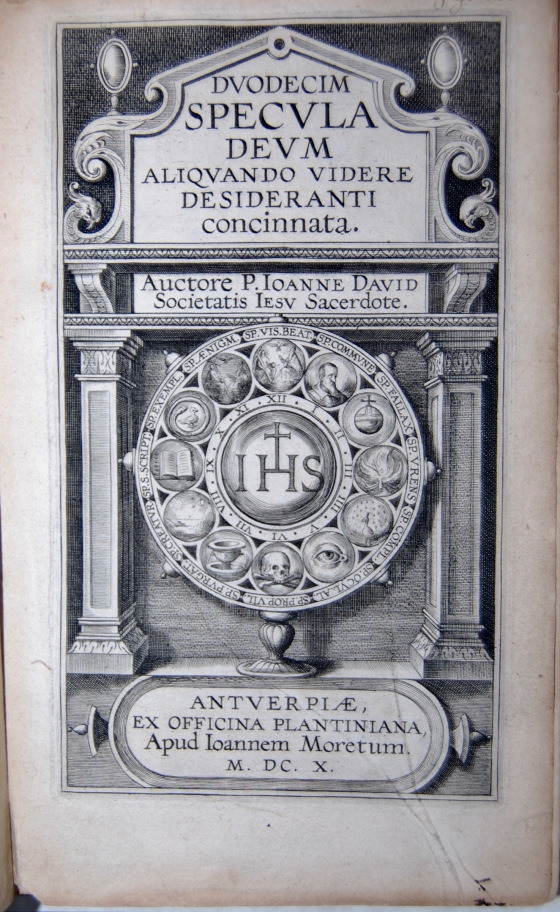
First edition of this wonderfully illustrated work about 12 mirrors mankind uses to try and see God. David was born at Courtrai and entered the society of Jesuits in 1581. He was distinguished for his zealous fight against heresy. “Emblem number with caption,pictura with motifs flagged, then subscriptio,prose identification flagged motifs,facing page with number followed by a prose conversation between Anima and Desiderus.
Youth edition with engravings only, without text. Each plate bears, at the top, a serial number and an inscription indicating the subject represented in the bottom part a Latin couplet with a summary explanation. RRef. Landwehr 188, Funck p. 303, BCNI 5556, Bibl. Belg. D 157, Praz p. 313 “scarce”
DeBacker-Sommervogel vol. II col.1851 no.20 ; McGeary & Nash. Emblem books at the Unviersity of Illinois,; G2; Daly & Dimler corpus Librorun eblematun(CLE) J141; Praz, M. Studies in 17th century imagery,; vol. I p.192 vol.. II, p. 46; Landwehr, J. Dutch emblem books,; Funck p. 303, BCNI 5556, Bibl. Belg. D 157; see also The Jesuits and the Emblem Tradition: Selected Papers of the Leuven International Emblem Conference, 18-23 August, 1996.
. Item #409J
Price: $1,900.00
4) Izquierdo, Sebastian Izquierdo, Saint Ignatius of Loyola
Praxis exercitiorum spiritualium P.N.S. Ignatti. Auctore P. Sebastiano Izquierdo Alcarazense Societatis Jesu.
Rome: Romae : Typis Joannis Francisci Buagni, 1695, 1695. Octavo 7 X 4.75 inches A-G8,H4 This copy is very clean and bound in full contemporary vellum. Landwehr, Romanic, 412.Sommervogel, IV, 70 1#4 ; Palau 291230; Landwehr:Romantic 412.; Praz,p.382. Item #716

The Jesuit Sebastián Izquierdo in his Práctica de los ejercicios espirituales, written in (Spanish in )1665 translated in to Italian the same year then in 1678 translated as here into Latin and later published in several translations and versions offers an illustrated guide to the Ignatian spiritual exercises. The illustrations, 12 of them, are the subject of image meditation which was a favorite method of the Jesuits who, beginning with the monumental Evangelicae Historiae Imagines (1593) of Jerónimo Nadal, actively took hold of religious iconography and adjusted and concentrated it for the teaching of the Societies ( and Ignatius’ ) vision. The images are not just simple depiction’s instead they are mnemonic devices. These images are points of departures and give the current 21st century reader a precious examples of images that inspire meditation, direct the reception of the teachings and anchor them in the memory. Particularly memorable is the Image of Hell on page 72, The lay-out shows the pedagogical intentions and possibilities of this little book: there are 12 parts consisting of 12 separate quires, numbered from ‘A’ to ‘M’ and paginated each from 1-12, each with its own full-page illustration , these could have been meant to be distributed separately – according to match the educational needs or level of the students. The Images are in high contrast, with plenty of Bloody and memorable images. The Puteus Abyssi depicts a poor man who is naked and sitting in a chair in some sort of oubliette. He has sevenswords, each with animal head handles, in him and each is strategically stuck in various parts of the body. The swords are labeled for the passions. Most interesting of these might be the sword marked ‘Vengeance’ it is hanging offer the mans head, the Idleness sword is stuck between his legs, Gluttony in his stomach, Lust … Envy in his back, Avarice between his Shoulders and Pride in his heart.Izquierdo was also the author of Pharus scientiarum, a treatise on a methodology to access knowledge,

conceived as a single science. In this work, he assimilated Aristotelian and Baconian logic, and he expressed some original ideas on mathematics and logic that have earned their author a reputation as an outstanding mathematician. Not just like his Spanish contemporaries John Caramuel or Tomás Vicente Tosca , but also significant foreign mathematicians as Athanasius Kircher , Gaspar Knittel or Gottfried Wilhelm Leibniz , the latter, in particular, cited with, his Disputatio of Combinatione, in Combinatorial Art (1666).
Price: $1,800.00
5) SCARLATINI, Ottavio Scarlatini
Homo et eius partes figuratus & symbolicus, anatomicus, rationalis, moralis, mysticus, politicus, & legalis, collectus et explicatus cum figuris
Augsburg & Dillingen, Johann Caspar Bencard, 1695. First and only Latin edition. Bound in a beautiful contemporary pig skin over wooden boards. Caillet 9948 (“unique in its genre”); Landwehr, German emblem books 530; Praz 490 note; R. Raybould, Emblemata 29. Item #734

With 42 engraved emblems revolving around the human body and body parts. It describes and depicts the human body in its details and in its entirety in every aspect conceivable. The book also discusses magic, in the strict sense of the word, revealing many marvellous secrets, such as the occult properties of saliva, urine, sperm, etc.”The erudition demonstrated by the author is really quite extraordinary” (Raybould) including metoposcopy (the interpretation of facial wrinkles for divination!). . Book One studies individual organs: heart, etc. And Book Two the overall dignity of the whole and aspects of human life.An appendix adds short accounts of several subjects, including “hieroglyphia” and “androgyni”, along with short works by other authors: Lactantius Firmianus’s “De opificio Dei”, Coelius Rhodiginus on humanity, and a long “Ode” to humanity: “Considerationes patheticae de creatione, & dignitate hominis” based on Trismegistus, Plato, Coelius and other ancient sources.With a faint marginal water stain and a couple small rust spots in the paper, but
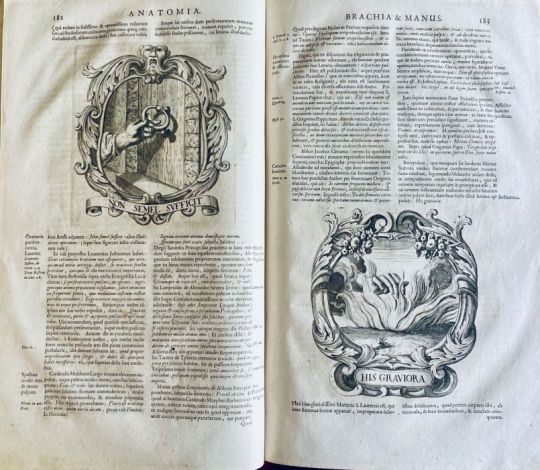
otherwise in fine condition. The binding shows a few scratches, cuts and stains, small cracks at the head and foot of the hinges and 1 sewing support broken at the hinge, but is still in good condition. A fascinating emblem book for both text and imagery (some of it now also humorous), and an impressive piece of book production.
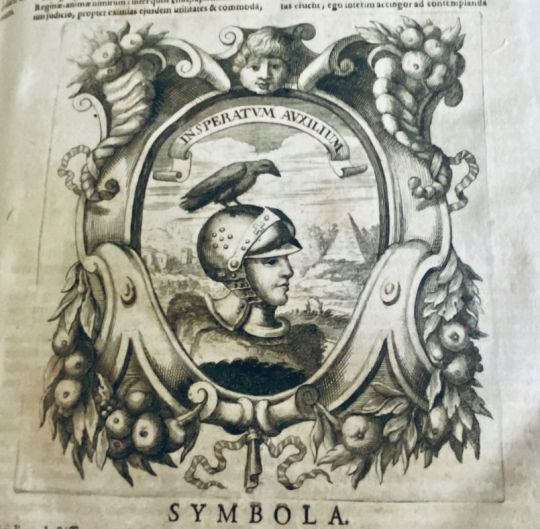
Price: $5,500.00
6). Sucquet, Anton Sucquet
Piæ considerationes ad declinandum à malo et faciendum bonum : cum iconibus Viae vitae aeternae R.P. Antonij Sucquet è Societate Iesu.
Viennæ Austriæ : Wien : [s.n.], 1672, 1672. Boetius a Bolswert and title by “I.M. Lerch sc. Viennae. Quarto,4 ¾ X 7 inches . ( no printed signatures) π 4 A-T4 V2. This copy is bound in original vellum. There is a really interesting modern bookplate on the pastedown. ¶ Praz, M. Studies in 17th cent. imagery (2nd ed.),; p. 506; Corpus librorum emblematum. Jesuit series,; J.1414; Landwehr, J. German emblem books,; 564; De Backer-Sommervogel,; VI, column 892, no. 2. Item #715
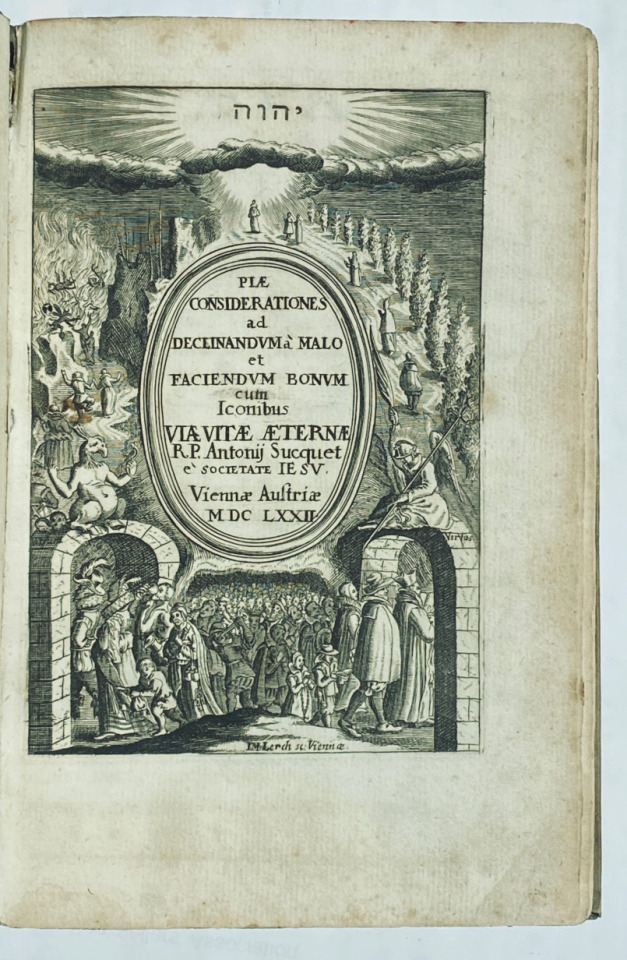
There is an engraved emblematic title page signed “I.M. Lerch sc. Viennae;” The other 32 illustrations (numbered 1-32) are full-page emblems engraved by Boetius a Bolswert–See Landwehr. ¶The Illustrations are printed on the verso of leaf, recto is blank; accompanied by explanatory text on facing leaf. The text and illustrations are printed within ruled border. This popular emblematical work is arranged as a series of meditations, by the Jesuit Antoine Sucquet. Many religious emblem books were published during the 17th and 18th centuries, and of these, Sucquet’s work was one of the most popular. Because of its engravings by Boëtius a Bolswert , it was especially important for the development of the 17th-century Christian iconography. The counter-reformation produced a great number of emblematic meditation-books where text and illustrations are interwoven. Emblem books were therefore much favoured by the Jesuits for the purposes of teaching, as religious propaganda, and to provide subjects for meditation. The 17th-century Jesuit curriculum prescribed that emblems were composed in the schools. Members of the highest classes in the Flemish Jesuit colleges each composed an emblem, and the production of the entire class was collected in commemorative albums painted by professional artists and calligraphers. The meditation on the soul’s relation to Christ was precisely guided by provision of references in the engravings. The first religious catholic emblem book was published in 1571 and composed by Arias Montanus. In 1601 Jan David composed the first Jesuit emblem book, the “Veridicus Christianus”. Sucquet’s work is composed around the widely spread concept of the “homo viator in bivio”, the creature who during his life again and again arrives at the cross and has to make the good choice for the narrow and difficult path to his eternal destination. Sucquet made clear that vision is the most important sense of a human being. It had foundational importance for the Christian iconography of the seventeenth century. According to Brunet the work was very much searched after by the pious for its texts, by the curious minds for the 32 engravings by Boetius a Bolswert
Price: $1,900.00
7) Venius, Otto van Veen
Theater moral de la vida humana, en cien emblemas; con el Enchiridion de Epicteto, y La tabla de Cebes, philosofo platonico.
Antwerp: Amberes,{Antwerp} Por Enrico y Cornelio Verdussen 1701, 1701. The Rubens master. third Edition.This large folio is bound in full contemporary vellum with gilt tooling. Snags repaired in the blank of the title page and on the folding Engraving , without damaging the text. Scattered freckles. Good copy. Landwehr, Dutch 240; Landwehr, Low Countries 678. (cfr. PRAZ, Studies in seventeenth-century imagery I pp.523-524 & Peeters Fontainas Bibliographie des impr. espagn. des Pays-Bas mérid. 1275;. Folio. 14 x 9 inches * 6, ** 4, *** 2, A-Z4, 2A-2C4 / a4, a-f4, g2. Item #97
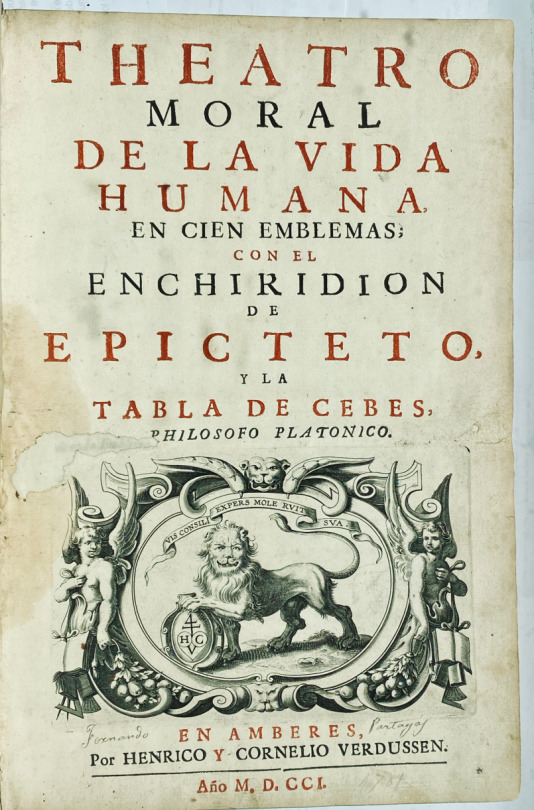
This Emblem book is made up of three Stoic works, beginning with Text from Horace in latin with 103 copper plates of engravings, That is a full page engraving of Vaenius by his daughter Gertrude van Veen engraved by Pontius.
These emblems also appeared in “Emblems from Horace, but not directly, these engravings represent both allegoric and general passages from Horace, these are in Spanish. The Horace is followed by
The Table of Cebes which has a large folding plate (16 x 13 inches) Cebes’ Tablet is an Ekphrastic work interpreting a probably mythical Tablet which symbolically represents “the whole Truth of Human life” Cebes is one of the characters in The Phædo of Plato. Xenophon tells us that Cebe was in the inner circle of Socrates’ friends. This is followed by The ENCHRIDION of Epictetus, in spanish. This manual is a ‘hands-on’philosophical collection of epigrams which promises to free the mind from Fear and enslavement to false Ideas.

Price: $3,500.00


Seven Emblem Books and Two others To see the web page which goes with this choose the link below. Seven Emblem books and two others!
4 notes
·
View notes
Text
1)
343Ja. Gilbert Burnet. 16143-1714 & 343Jb. William Congreve 1670-1729
Two pamphlets on Queen Mary II.
Mary II (30 April 1662 – 28 December 1694) was Queen of England, Scotland, and Ireland, co-reigning with her husband, King William III & II, from 1689 until her death. Popular histories usually refer to their joint reign as that of William and Mary.
Although their father James, Duke of York, was Roman Catholic, Mary and her sister Anne were raised as Anglicans at the wishes of their uncle, King Charles II. He lacked legitimate children, making Mary second in the line of succession as James’s eldest child. She married her Protestant first cousin, William of Orange, in 1677. Charles died in 1685 and James took the throne, making Mary heir presumptive. James’s attempts at rule by decree and the birth of his son, James Francis Edward Stuart, led to his deposition in the Glorious Revolution and the adoption of the English Bill of Rights.
William and Mary became king and queen regnant. She wielded less power than him when he was in England, ceding most of her authority to him, though he heavily relied on her. She did, however, act alone when William was engaged in military campaigns abroad, proving herself to be a powerful, firm, and effective ruler. Her death left William as sole ruler until his own death in 1702, when he was succeeded by Mary’s sister Anne.
An essay on the memory of the late Queen by Gilbert, Bishop of Sarum.
Dublin : Reprinted by Jos. Ray for Will. Norman, El. Dobson, and Pat. Campbel .., 1695. $1,100
Quarto 7 ½ x 6 inches. Π2, B-K2. Disbound pamphlet.
Wing (2nd ed.), B5785:: ESTC R37518
Copies – Brit.Isles Cashel Cathedral Library Derry and Raphoe Diocesan Library Dublin Honourable Society of King’s Inn Marsh’s Library Trinity College Library Copies – N.America Boston Public, Main Yale University, Beinecke Rare Book
Along with this I am offering a Poem by an Irish Author on a Queen Mary II.
343Jb. William Congreve.
The Mourning Muse of Alexis. A Pastoral. Lamenting the Death of our late Gracious Queen Mary.
London: for Jacob Tonson, 1695. $1,100 (for both)
Folio 12 x 7 ½ inches. A-C2 Disbound Wing C-5860
During the 1690’s there wasn’t much output from the Irish press concerning foreign affairs, the exception to this is the two pamphlets on the Death of Mary II from small pox. Both lament the passing of a Queen loved by the Irish.
Congreve was educated at Kilkenny College, where he met Jonathan Swift, and at Trinity College in Dublin. He moved to London to study law at the Middle Temple, but preferred literature, drama, and the fashionable life. Congreve used the pseudonym Cleophil, under which he published Incognita: or, Love and Duty reconcil’d in 1692. This early work, written when he was about 17 years of age, gained him recognition among men of letters and an entrance into the literary world. He became a disciple of John Dryden whom he met through gatherings of literary circles held at Will’s Coffeehouse in the Covent Garden district of London. Dryden supported him throughout his life, often composing complimentary introductions for his publications.
)O(
2)
342J William Hamilton
The life and character of James Bonnel Esq; late Accomptant General of Ireland. To which is added the sermon preach’d at his funeral: by Edward Lord Bishop of Killmore and Ardagh. The life by William Hamilton, A. M. Archdeacon of Armagh. Psal. 37. 37. Mark the Perfect Man, behold the Upright; for the End of that Man is Peace.
Dublin: Printed by and for Jo. Ray, and are to be sold A. and J. Churchill, at the Black Swan in Pater-noster-row, 1703. ON HOLD
Octavo 6 ¾ x 4 ½. Fold out portrait,1 , π1,a -c4 +1, B-S8(new title page)T-U8,X5, Lacking final blank X6. X5 is errata and present. In this edition the first line of the imprint reads “to be”. It is bound in contemporary calf binding with the front board detached Ownership signature of Anne Orme (1698 Birth ?)
Very little is known of William Hamilton one of the more than 15 children of Rev. James Hamilton and his wife, Catherine (Leslie) Hamilton. It is believed he died in 1729, without descendants, possibly a soldier fighting on the Continent during one of the many local wars in what is now Germany He was buried in St. John’s Church, Dublin, and his funeral sermon was preached by the Bishop of Killaloe (Edward Wetehall), who uses these remarkable words in his preface to the sermon: ‘I am truly of opinion that in the best age of the church, had he lived therein, he would have passed for a Saint.’ His life was written by the Archdeacon of Armagh (William Hamilton), who fully bears out this encomium. Archdeacon Hamilton has wisely fortified himself by attaching to his ‘Life’ letters from several bishops who fully endorse all that he has written, and there does not appear to be a hint from any other source which would lead us to doubt the truthfulness of the account. Bonnell’s piety was of the strictly church of England type, though he was tolerant of those who differed from him. During; the greater part of his life he attended church twice every day, and made a point of communicating every Lord’s day. He was a careful observer of all the festivals and fasts of the church, and made it a rule to repeat on his knees every Friday the fifty-first Psalm. He took a deep interest both in the ‘religious societies’ and the ‘societies for the reformation of manners,’ which form so interesting a feature in the church history of his day. Of the former, which flourished greatly at Dublin, we are told that ‘he pleaded their cause, wrote in their defence, and was one of their most diligent and prudent directors;’ of the latter ‘he was a zealous promoter, was always present at their meetings, and contributed liberally to their expenses.’ He gave one-eighth of his income to the poor, and his probity was so highly esteemed that the fortunes of many orphans were committed to his care. Bonnell was a man of great and varied accomplishments. ‘He understood French perfectly, and had made great progress in Hebrew, while in philosophy and oratory he exceeded most of his contemporaries in the university, and he applied himself with success to mathematics and music.’ Divinity was, however, of course his favourite study. He was a great reader of the early fathers, and translated some parts of Synesius into English. He also reformed and improved for his own use a harmony of the Gospels. His favourite writers were Richard Hooker and Thomas à Kempis. Many of his ‘Meditations’ (a vast number of which, on a great variety of subjects, are still extant) remind one slightly of the latter author. Dictionary of National Biography, 1885-1900, Volume 05 by John Henry Overton
[Hamilton’s Exemplary Life and Character of James Bonnell, &c.; Christian Biography, published by Religious Tract Society.]
ESTC N19165
Copies – Brit.Isles Trinity College Library. Dublin, Republic of Ireland. Copac adds no copies. National Library of Wales / Llyfrgell Genedlaethol Cymru (Is possibly a copy but I’m not sure the description is sparse )
Copies – N.America Henry E. Huntington Library University of California, Los Angeles, William Andrews Clark Memorial Library.
)O(
3)
344J. Joseph Trapp 1679-1747
A sermon preach’d at Christ-Church, Dublin, before their excellencies the Lords Justices of Ireland; on Tuesday May the 29th. Dublin
Dublin: Printed by A.R. [i.e., Aaron Rhames] for J. Hyde, 1711.
Quarto 7 ½ X 6 inches. A2, B-D4. Disbound.
In January 1711 Sir Constantine Phipps, the Lord Chancellor of Ireland. Whose term of office was marked by bitter political faction-fighting and he faced repeated calls for his removal. Trapp was taken on as as his chaplain, and Trapp wrote partisan political pieces, incurring scorn from Swift. He married in 1712 a daughter of Alderman White of St. Mary’s, Oxford, and resigned as a Fellow of Wadham. That year he was chaplain to Henry St John, 1st Viscount Bolingbroke, a place Swift claimed he had arranged. On 1 April 1713 Swift would not dine with Bolingbroke because he was expected to ‘look over a dull poem’ of Trapp’s; afterwards he did correct the poem, printed anonymously at Dublin, as Peace, a Poem. It was set to music by William Croft.
After reading this sermon it is obvious that Trapp missed his calling as a Puritan Hell and Dmanation Presacher. “ Can we be called the City of Righteousness, when all sorts of Debauchery and Profaneness have, like the Deluge, overspread these Nation? When there are so many, whoeven Glory in their Shame, make a Science of Leudeness, and are not only Workers, but Professors of Iniquity?” Fun reading indeed.
ESTC T172845
Copies – Brit.Isles Armagh Robinson Library Cashel Cathedral Library (3) London Library National Library of Ireland (2) Oxford University Regent’s Park College (includes Baptist Union Library) Royal Irish Academy Trinity College Library No US copies
)O(
4)
349J. Church of England. Province of Canterbury. Convocation. For the Church of Ireland. Convocation.
A representation of the present state of religion, with regard to the late excessive growth of infidelity, heresy, & profaneness: unanimously agreed upon by a joint committee of both Houses of Convocation, of the province of Canterbury, and Afterwards rejected by the Upper House, but Passed in the Lower House. Members of the Committee. The Bps. of Peterborough Landaff Bangor St. Asaph St. Davids. Dr. Atterbury, Prol. Dr. Stanhope Dr. Godolphin Dr. Willis Dr. Gastrell Dr. Ashton Dr. Smalridge Dr. Altham Dr. Sydell Archd. Brideock.
[Dublin] : London printed : And, re-printed and sold by Edward Waters, Dublin,1711 $760
Quarto. 7 ¼ x 5 ¾ inches. A3,B-D2 (lacking E1&2) [2]17+[1]p Disbound.
As with many 17th century tracts the title pretty much says it all. But to put it in perspective.
The convocation of the English Church in 1711 decided that by the opportunity by Royal License and permission to frame their canons and declarations which could eventual become law. It was true that the Irish Church was Weak not altogether by its own fault, If the Church of England was strong. The English Church had had the opportunity of expressing, whatever value it might have, its concurrence with that measure. The Irish Church appealed to them for the same permission. There was in Ireland as in England a Convocation, which had been in abeyance for many years as that of England had been for about the same period. Called by Royal writ—it dated as far back as Parliamentary Government in Ireland; that from 1625 to 1711 it was repeatedly so summoned; that at its last period of meeting, in 1711, it passed five canons, which, having received the assent of Her Majesty Queen Anne, became part and continued part of the ecclesiastical law of Ireland.
ESTC T145807
Copies – Brit.Isles Armagh Robinson Library British Library Cashel Cathedral Library (4) Cork University College Boole Library Dublin City Libraries National Library of Ireland Royal Irish Academy Trinity College Library (3) Copies – N.America Henry E. Huntington Library University of Texas at Austin, Harry Ransom Center University of Virginia
)O(
5)
A collection of Poems and Letters by Christian mystic and prolific writer, Jeanne-Marie Guyon published in Dublin.
348J François de Salignac de la Mothe-Fénelon 1651-1715 & Josiah Martin 1683-1747 & Jeanne Marie Bouvier de La Motte Guyon 1648-1717
A dissertation on pure love, by the Arch-Bishop of Cambray. With an account of the life and writings of the Lady, for whose sake The Archbishop was banish’d from Court: And the grievous Persecution she suffer’d in France for her Religion. Also Two Letters in French and English, written by one of the Lady’s Maids, during her Confinement in the Castle of Vincennes, where she was Prisoner Eight Years. One of the Letters was writ with a Bit of Stick instead of a Pen, and Soot instead of Ink, to her Brother; the other to a Clergyman. Together with an apologetic preface. Containing divers letters of the Archbishop of Cambray, to the Duke of Burgundy, the present French King’s Father, and other Persons of Distinction. And divers letters of the lady to Persons of Quality, relating to her Religious Principles
Dublin : printed by Isaac Jackson, in Meath-Street, [1739]. $ 3,800
Octavo 7 3/4 x 5 inches First and only English edition. Bound in Original sheep, with a quite primitive repair to the front board.
Fenélon’s text appears to consist largely of extracts from ’Les oeuvres spirituelles’. The preface, account of Jeanne Marie Guyon etc. is compiled by Josiah Martin. The text of the letters, and poems, is in French and English. This is an Astonishing collection of letters and poems.
“MARTIN, JOSIAH (1683–1747), quaker, was born near London in 1683. He became a good classical scholar, and is spoken of by Gough, the translator of Madame Guyon’s Life, 1772, as a man whose memory is esteemed for ‘learning, humility, and fervent piety.’ He died unmarried, 18 Dec. 1747, in the parish of St. Andrew’s, Holborn, and was buried in the Friends’ burial-ground, Bunhill Fields. He left the proceeds of his library of four thousand volumes to be divided among nephews and nieces. Joseph Besse [q. v.] was his executor.
Martin’s name is best known in connection with ‘A Letter from one of the People called Quakers to Francis de Voltaire, occasioned by his Remarks on that People in his Letters concerning the English Nation,’ London, 1741. It was twice reprinted, London and Dublin, and translated into French. It is a temperate and scholarly treatise, and was in much favour at the time.
Of his other works the chief are: 1. ‘A Vindication of Women’s Preaching, as well from Holy Scripture and Antient Writings as from the Paraphrase and Notes of the Judicious John Locke, wherein the Observations of B[enjamin] C[oole] on the said Paraphrase . . . and the Arguments in his Book entitled “Reflections,” &c, are fullv considered,’ London, 1717. 2. ‘The Great Case of Tithes truly stated … by Anthony Pearson [q. v.] . . . to which is added a Defence of some other Principles held by the People call’d Quakers . . .,’ London, 1730. 3. ‘A Letter concerning the Origin, Reason, and Foundation of the Law of Tithes in England,’ 1732. He also edited, with an ‘Apologetic Preface,’ comprising more than half the book, and containing many additional letters from Fénelon and Madame Guyon, ‘The Archbishop of Cambray’s Dissertation on Pure Love, with an Account of the Life and Writings of the Lady for whose sake he was banish’d from Court,’ London, 1735.
[Joseph Smith’s Catalogue of Friends’ Books; works quoted above; Life of Madame Guyon, Bristol, 1772, pt. i. errata; registers at Devonshire House; will P.C.C. 58 Strahan, at Somerset House.]
C. F. S.
Fénelon was nominated in February, 1696, Fénelon was consecrated in August of the same year by Bossuet in the chapel of Saint-Cyr. The future of the young prelate looked brilliant, when he fell into deep disgrace.
The cause of Fénelon’s trouble was his connection with Madame Guyon, whom he had met in the society of his friends, the Beauvilliers and the Chevreuses. She was a native of Orléans, which she left when about twenty-eight years old, a widowed mother of three children, to carry on a sort of apostolate of mysticism, under the direction of Père Lacombe, a Barnabite. After many journeys to Geneva, and through Provence and Italy, she set forth her ideas in two works, “Le moyen court et facile de faire oraison” and “Les torrents spirituels”. In exaggerated language characteristic of her visionary mind, she presented a system too evidently founded on the Quietism of Molinos, that had just been condemned by Innocent XI in 1687. There were, however, great divergencies between the two systems. Whereas Molinos made man’s earthly perfection consist in a state of uninterrupted contemplation and love, which would dispense the soul from all active virtue and reduce it to absolute inaction, Madame Guyon rejected with horror the dangerous conclusions of Molinos as to the cessation of the necessity of offering positive resistance to temptation. Indeed, in all her relations with Père Lacombe, as well as with Fénelon, her virtuous life was never called in doubt. Soon after her arrival in Paris she became acquainted with many pious persons of the court and in the city, among them Madame de Maintenon and the Ducs de Beauvilliers and Chevreuse, who introduced her to Fénelon. In turn, he was attracted by her piety, her lofty spirituality, the charm of her personality, and of her books. It was not long, however, before the Bishop of Chartres, in whose diocese Saint-Cyr was, began to unsettle the mind of Madame de Maintenon by questioning the orthodoxy of Madame Guyon’s theories. The latter, thereupon, begged to have her works submitted to an ecclesiastical commission composed of Bossuet, de Noailles, who was then Bishop of Châlons, later Archbishop of Paris, and M. Tronson; superior of-Saint-Sulpice. After an examination which lasted six months, the commission delivered its verdict in thirty-four articles known as the “Articles d’ Issy”, from the place near Paris where the commission sat. These articles, which were signed by Fénelon and the Bishop of Chartres, also by the members of the commission, condemned very briefly Madame Guyon’s ideas, and gave a short exposition of the Catholic teaching on prayer. Madame Guyon submitted to the condemnation, but her teaching spread in England, and Protestants, who have had her books reprinted have always expressed sympathy with her views. Cowper translated some of her hymns into English verse; and her autobiography was translated into English by Thomas Digby (London, 1805) and Thomas Upam (New York, 1848). Her books have been long forgotten in France.
Jeanne Marie Guyon
b. 1648, Montargis, France; d. 1717, Blois, France
A Christian mystic and prolific writer, Jeanne-Marie Guyon advocated a form of spirituality that led to conflict with authorities and incarceration. She was raised in a convent, then married off to a wealthy older man at the age of sixteen. When her husband died in 1676, she embarked on an evangelical mission to convert Protestants to her brand of spirituality, a mild form of quietism, which propounded the notion that through complete passivity (quiet) of the soul, one could become an agent of the divine. Guyon traveled to Geneva, Turin, and Grenoble with her mentor, Friar François Lacombe, at the same time producing several manuscripts: Les torrents spirituels (Spiritual Torrents); an 8,000-page commentary on the Bible; and her most important work, the Moyen court et très facile de faire oraison (The Short and Very Easy Method of Prayer, 1685). Her activities aroused suspicion; she was arrested in 1688 and committed to the convent of the Visitation in Paris, where she began writing an autobiography. Released within a few months, she continued proselytizing, meanwhile attracting several male disciples. In 1695, the Catholic church declared quietism heretical, and Guyon was locked up in the Bastille until 1703. Upon her release, she retired to her son’s estate in Blois. Her writings were published in forty-five volumes from 1712 to 1720.
Her writings began to be published in Holland in 1704, and brought her new admirers. Englishmen and Germans–among them Wettstein and Lord Forbes–visited her at Blois. Through them Madame Guyon’s doctrines became known among Protestants and in that soil took vigorous root. But she did not live to see this unlooked-for diffusion of her writings. She passed away at Blois, at the age of sixty-eight, protesting in her will that she died submissive to the Catholic Church, from which she had never had any intention of separating herself. Her doctrines, like her life, have nevertheless given rise to the widest divergences of opinion. Her published works (the “Moyen court” and the “Règles des assocées à l’Enfance de Jésus”) having been placed on the Index in 1688, and Fénelon’s “Maximes des saints” branded with the condemnation of both the pope and the bishops of France, the Church has thus plainly reprobated Madame Guyon’s doctrines, a reprobation which the extravagance of her language would in itself sufficiently justify. Her strange conduct brought upon her severe censures, in which she could see only manifestations of spite. Evidently, she too often fell short of due reserve and prudence; but after all that can be said in this sense, it must be acknowledged that her morality appears to have given no grounds for serious reproach. Bossuet, who was never indulgent in her regard, could say before the full assembly of the French clergy: “As to the abominations which have been held to be the result of her principles, there was never any question of the horror she testified for them.” It is remarkable, too, that her disciples at the Court of Louis XIV were always persons of great piety and of exemplary life.
On the other hand, Madame Guyon’s warmest partisans after her death were to be found among the Protestants. It was a Dutch Protestant, the pastor Poiret, who began the publication of her works; a Vaudois pietist pastor, Duthoit-Mambrini, continued it. Her “Life” was translated into English and German, and her ideas, long since forgotten in France, have for generations been in favour in Germany, Switzerland, England, and among Methodists in America. ”
EB
P.144 misnumbered 134. Price from imprint: price a British Half-Crown. Dissertain 16p and Directions for a holy life 5p. DNB includes this in Martin’s works
Copies – Brit.Isles. : British Library, Dublin City Library, National Library of Ireland Trinity College Library
Copies – N.America. : Bates College, Harvard University, Haverford Col , Library Company of Philadelphia, Newberry, Pittsburgh Theological Princeton University, University of Illinois University of Toronto, Library
Some new Irish books…. By, For or About! 1) 343Ja. Gilbert Burnet. 16143-1714 & 343Jb. William Congreve 1670-1729 Two pamphlets on Queen Mary II.
#Conclave of 1711#Dublin printing#female mystics#James Bonnell#Madame Guyon#Quakerism#Science of Leudeness
3 notes
·
View notes
Text
1)
“The earliest instance of a”romance” credited to an Irish writer “ (Sweeney, Ireland and the Printed Word)
334J Roger Boyle ,The Earl of Orrery. (1676-1731)
Parthenissa. That most fam’d romance· The six volumes compleat. Composed by the right honourable the Earl of Orrery.
London : printed by T[homas]. N[ewcomb]. for Henry Herringman, at the Blue Anchor in the lower-walk of the New Exchange, MDCLXX·VI [1676] $3,500

Folio, 13 X 8 inches. A² B-3E⁴ 3F², 3Q-5I⁴ 5K⁴(final blank5K4). [Volumes 2-6 each with divisional title page.808 pages}
Text appears continuous despite pagination and register.]. First complete edition, preceded by a parts issue which was issued from 1651 to 1669.

First edition of this Restoration romance by the first Earl of Orrery with a plot somewhat typical of the period: platonic lovers and historical allegory in a classical setting, etc.
In addition to this novel, he wrote poetry, plays and a Treatise on the Art of War (1667), and he was a friend of Katherine Philips and Margaret Cavendish.
Evidence of contemporary readership by a woman:

handsome armorial bookplate on the verso of the title-page. Handwritten signature of Bridget Taylor, December, 1694 !
The Folger Library also has a book owned by Bridget Taylor

{ from Folger catalogue Back cover tooling (detail), C6659.
General Description:
Late 17th century English “Cambridge Style” binding. C6659
Provenance:
“inscriptions on front paste-down: “Bridget Taylor her Booke 1693”; and “C. L. Lewes, 1910”; bookplate of “White, Wallingwells”. The spine on the Folger book of the same provenance is almost the same as the present book. “The spine is divided into seven panels, each framed with a gilt double line. The author and title is gilt on a burgundy leather label in the second panel. The other panels are gilt with corner volute brackets with an ornamental center fleuron stamp. The board edges are blind tooled with the decorative tulip roll.”
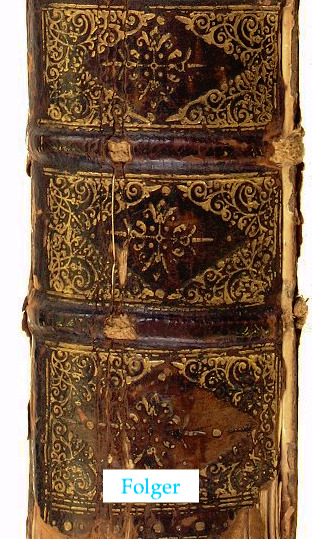

“Of originall English romances, written in competition with the French masterpieces , the Parthenissa of Lord Orrery (1654) is the best known.” (Encyclopaedia Britannica 11th edn vol. 19 p836 ‘The Novel , Edmund Gosse )
Educated at Christ church, he joined the wits engaged in a struggle with Bentley, who represented the scholarship of the Cambridge whigs. Sir W. Temple had made some rash statements as to the antiquity of Phalaris in a treatise on ancient and modern learning, and this was the subject of attack by Wotton, a protégé of Bentley’s in his ‘Reflections on Ancient and Modern Learning,’ published in 1694. By way of covering Temple’s defeat, the Christ Church scholars determined to publish a new edition of the epistles of Phalaris. This was entrusted to Boyle, who, without asserting the epistles of Phalaris. This was entrusted to Boyle, who, without asserting the epistles to be genuine, as Temple had done, attacked Bentley for his rudeness in having withdrawn too abruptly a manuscript belonging to the King’s Library, which Boyle had borrowed. Bentley now added to a new edition of Wotton’s ‘Reflections’ a ‘Dissertation’ upon the epistles, from his own pen. Boyle was aided by Atterbury and Smalridge in preparing a defense, published in 1698 entitled ‘Dr. Bentley’s Dissertations … examined.’ Bentley returned to the charge and overwhelmed his opponents by the wealth of his scholarship. The dispute led to Swift’s ‘Battle of the Books.’” .
Loeber: 305; Wing O-490;Sweeney #621;
A Bibliographical Study of “Parthenissa” by Roger Boyle Earl of Orrery Author(s): C. William Miller. Source: Studies in Bibliography, Vol. 2 (1949/1950), pp. 115-137 Published by: Bibliographical Society of the University of Virginia Stable URL: https://www.jstor.org/stable/40371074
https://www.jstor.org/stable/pdf/40371074.pdf?refreqid=excelsior%3Aaa61df720a726cf4cac8defa983a4663
2)
320J Roger Boyle (A person of honour = Roger Boyle, Earl of Orrery. Cf. BM; Halkett & Laing (2nd ed.).The Earl of Orrery. (1676-1731)
English adventures. By a person of honour. Licensed May 12th, 1676. Roger L’Estrange
[London]: In the Savoy: printed by T. Newcomb, for H. Herringman, at the Anchor, on the lower walk of the New Exchange, 1676. $3,700

Octavo. [A]1 B-I8 [K]1. (“The end of the first tome of English adventures”–Page 129. No more published.) Bound in modern quarter calf.
An interesting feature of this book is the neat corrections, which to me look as if it was done by the printer and not a reader.
Loeber B-306; Wing (CD-Rom, 1996), O476 : Arber’s Term cat.; I 253; ESTC; R20367.
380LawrenceM.Principe
The family patriarch, Richard, Great Earl of Cork, expressly forbade his children the reading of romances. Upon learning that his sons Roger and Lewis were reading plays and romances while on the Continent under the tutelage of Marcombes (as Robert and Francis would be two years later), he issued a strict order that such corrupting entertainment be stopped.9 The Great Earl’s injunction apparently had little effect, sinice in 1651, Roger, Earl of Orrery, published Parthenis- sa… a work which, although very closely patterned upon French exemplars, is often considered to be the first modem English romance.10 Roger also bears the credit for introducing rhymed heroic dramas (again modelled after the French pattern) to the English stage… .in fact Roger became a highly-regarded playwright of the Restoration.11 Robert’s strong-willed sister Mary, Countess of Warwick, recounted that she too spent her days “seeing and reading plays and romances.”12 As for Robert, it has long been a staple of Boyle biogra- phers that he shared his father’s Puritanical opposition to romances. Peter Pett, in notes for an unpublished biography, recalled that his friend Boyle, at least once he began ethical and devotional pursuits, never “read either play or Romance; no not so much as those writ by his ingenious brother the earle of Orrery
” W. S. Clark, The Dramatic Works of Roger Boyle, 2 vols., (Cambridge, Mass., 1937); Eduard Siegert, Roger Boyle, Earl of Orrery, und seine Dramen (Vienna, 1906).
Lawrence M. Principe
Journal of the History of Ideas
Vol. 56, No. 3 (Jul., 1995), pp. 377-397 (21 pages)
This content downloaded from 67.142.100.14 on Fri, 23 Aug 2019 12:25:05 UTC All use subject to https://about.jstor.org/terms
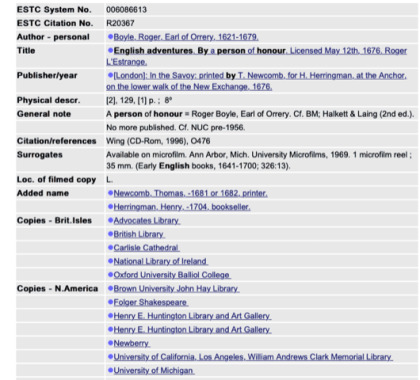
3)
627F Richard Head 1637?-1686?.
Proteus redivivus: the art of wheedling or insinuation, in general and particular conversations and trades. Together with the several actions, inclinations and passions of both sexes, and of all their professions and occupations. Discovering their many tricks and designs t self-advancement, though by indirect wayes and methods; fitly suited to these times, to prevent the vertuous from abuses, and to detect the enormities of the vitious. Furnished with many delightful songs in various chapters. Compil’d and publish’d formerly by R.H. but now reprinted with additions in every chapter, to almost one half of the book, by the same author.
London : printed for T.D. and are to be sold by most booksellers of London and Westminster, 1684. $3,900

Bound in full calf recently rebacked. Engraved frontis. (plate) signed: Wm Bodley sculp. The most important primary source on Head’s life is William Winstanley’s biographical entry published in his Lives of the most famous English poets (1687) – a credible if not reliable source insofar as Winstanley could claim to have been personally acquainted with Head. According to Winstanley, Head was a minister’s son, born in Ireland. His father was killed in the Irish rebellion of 1641, the incidents seem to be reflected in Head’s English Rogue, the satirical romance he published in 1665. His mother took him to England where she had relatives in Barnstaple. They later moved on to Plymouth, to Bridport and to Dorset where Head is known to have attended the town’s grammar school in 1650. Head was eventually admitted to the same Oxford College his father had attended (possibly New Inn Hall, from which a John Head graduated in 1628). His financial means being insufficient Head was taken from college and bound apprentice to a “Latin bookseller” in London “attaining to a good Proficiency in the Trade”, as Winstanley put it. “His genius being addicted to Poetry” he published his first poetical and satirical piece which Winstanley recorded as Venus Cabinet Unlock’d. This may be a reference to Giovanni Benedetto Sinibaldi’s The cabinet of Venus unlocked, and her secrets laid open. Being a translation of part of Sinibaldus, his Geneanthropeia, and a collection of some things out of other Latin authors, never before in English (London: Philip Briggs, 1658). Head married around that time. A second addiction to gambling cost him the profit he made as an author and with his shop. Head moved – or fled – to his homeland Ireland, where he gained esteem with his first comedy Hic et ubique, or, The Humors of Dublin – printed with a dedication to the Duke of Monmouth at his return to England in 1663. The Duke’s recompense remaining below expectations Head had to survive as a bookseller with shop addresses (so Sidney Lee) in Little Britain, and (so Gerard Langbaine) in Petty Canons Alley, off Paternoster Row and opposite Queen’s Head Alley. Winstanley located him in Queen’s Head Alley. If his reports are trustworthy, Head gathered some wealth in little time only to gamble it away again a little later. The English Rogue (1665) solved some of his financial problems. Its tales of drastic adventures were based on the model of Spanish rogue stories (such as Lazarillo de Tormes 1554), which were fashionable due to the contemporary publication of Scarron’s Roman Comique (or Comical Romance, so the English title which established the genre), and savory with the events Head could claim to have based on his personal experience. The censor, so Winstanley reported, rejected the manuscript as “too much smutty”. The softened book edition sold brilliantly and created a complex publishing history: The first edition published by Henry Marsh sold out within the year. Marsh died that very year, Francis Kirkman the business partner, to whom Marsh had been indebted, secured the rights and sold Head���s title in four further editions between 1666 and 1667. It remains unclear how the ensuing volumes two, three, and four, published in 1671, 1674 and 1680, came to be written (a fifth was promised and never appeared). Winstanley speaks of Head as the author indiscriminately. In the dedication to his Proteus redivivus (1675) Head, however, explicitly denies a hand in any part but the first. Kirkman asserted nonetheless that he and Head were responsible for the third and fourth parts. The preface to the latter is signed by both men – facts which make Head’s belated disclaimer suspicious. Head’s imprint as a publisher is found on several titles. Works from his pen appeared until 1677. Winstanley reports that Head drowned on a journey to the Isle of Wight; the report itself was made in June 1686, and this generally accepted as the date of his death, even though more accurately it is a terminus ante quem.
Wing H-1274 Copies – N.America: (see Loeber p578-578)n
Boston Public Henry E. Huntington Library Princeton University University of California, Los Angeles, University of Chicago
4)
330J Edward Wettenall. 1636-1713.
A short Introduction of Grammar being generally the common form, with such supplements out of the Common Latin institutions, as make the English part a sufficient Grammar for a good understanding of the Latin tongue.

Dublin : printed by Andrew Crook Printer to Their Most Excellent Majesties on Ormonde-Key, and sold by William Norman on College;Green, Eliphal Dobson at the Stationers-Arms, Patrick Campbell at the Kings-Arms in Castle-street and the rest of the Booksellers of Dublin, 1694. $1,900
Octavo, 6 X 3 3/4 inches, A-D8, E4 ( Lacking 3 leaves; E3,E5& E6 ) F8 . The first edition? stated as The fifth edition (but in fact no other editions before or after for a long time after show up) see below. This copy is bound in its original hair sheep over paper boards
Edward’s last name is also spelled Wettenhall, Whetenhall, Whitnall, Withnoll, and Wythnall. He graduated B.D. at Oxford 26 May 1669, and was incorporated B.D. at Cambridge 1670. Michael Boyle the younger, the Archbishop of Dublin, brought him over to Dublin in 1672, as master of the blue-coat school. He was made a Doctor of Divinity at Trinity College, Dublin, became curate of St. Werburgh’s Church, and afterwards chantor of Christ Church.
At his own cost, Wetenhall restored the episcopal residence at Cork. As one of the seven bishops who remained in Ireland during the troubles which began in 1688, he was exposed to much ill-usage at the hands of the partisans of James II. He was probably the author of an anonymous tract ‘The Case of the Irish Protestants in relation to … Allegiance to … King William and Queen Mary,’ 1691 (27 October 1690). He signed the episcopal letter of thanks (November 1692) to Thomas Firmin for his exertions in relief of the distressed Protestants of Ireland. Only one Irish prelate, William Sheridan (died 1716) of Kilmore and Ardagh, was deprived (1691) as a nonjuror.
Wetenhall, who was translated as bishop of Kilmore and Ardagh on 18 April 1699, would not accept the preferment without trying to procure the restoration of Sheridan, to whose support he contributed. He restored the episcopal residence at Kilmore and rebuilt the cathedral at Ardagh (later demolished).
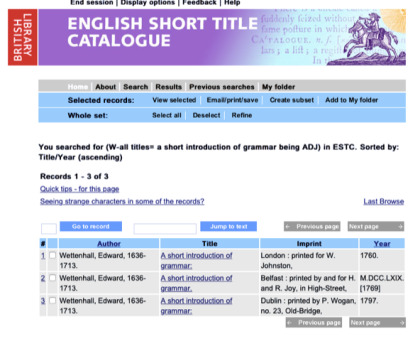
No Copy Even close to the present copy Located!
Paste Down!
Binding:

4 interesting Irish Books! 1) "The earliest instance of a”romance” credited to an Irish writer “ (Sweeney, Ireland and the Printed Word)
1 note
·
View note
Text
one shot Yandere Afrodita x Reader
Sobre suaves y ligeras sábanas de algodón, que despiden la sensual fragancia de una colonia varonil, yace el santo de oro Milo de Escorpio, su ondulada y abundante cabellera cerúlea se encuentra esparcida por lo numerosos cojines color vino con bordes dorados, su respiración es apacible y profunda, su labios están entreabiertos, con lentitud sus párpados comienzan a separarse para dar paso a su hermoso par de orbes azules, un bostezo abandona su garganta, extiende los brazos para desperezarse pero al hacerlo golpea “algo” a un costado, su vista está algo borrosa y su cabeza sufre una terrible migraña.—Les dije que no me dejaran tomar.—gruñó el griego incorporándose con dificultad. — ¡Momento! ¿Estoy desnudo?—su mirada viaja por su cuerpo sembrado de rasguños y hematomas en diferentes zonas. —Me parece que eso es mi culpa. —una voz nada familiar y femenina sobresalta a Milo haciéndolo salir de la cama de forma atolondrada, llevándose un almohadón para cubrir su hombría. — ¿Quién eres? ¡Qué haces aquí!
A unos metros del octavo templo la más hermosa de las féminas del Santuario, quien hace honor a su constelación, pues Piscis es famoso por ser el signo cuyos guardianes poseen mayor belleza, camina esbozando una dulce sonrisa, en sus brazos porta una cesta con diferentes ingredientes. —Espero que Milo se haya divertido en su despedida de soltero. —comentas para ti entrando por fin al recinto. —Un desayuno balanceado es lo que necesitara, si se excedió al festejar. — piensas dirigiéndote a la cocina, pero unos gritos detienen tu andar, es la voz de Milo y parece estar riñendo con alguien. Depositas los comestibles en el mueble más cercano y te acercas al lugar donde parece provenir el sonido. —¡Esto debe de ser un error, o una broma de muy mal gusto!—argumenta Milo contra la desconocida.—Haga el favor de salir inmediatamente de mi templo.—ordena apuntando con su dedo índice a la puerta, la mujer le sonríe traviesa y empieza a reptar por el lecho para acortar la distancia entre ellos.—En todo caso es un sueño, y uno muy bueno.—ronronea antes de abalanzarse contra él, Milo la esquiva e inmoviliza torciéndole un brazo contra su espalda, con la extremidad libre toma una sábana y la suelta sobre su cuerpo.—No me agrada maltratar mujeres, pero no me dejo opción.—se excusa el griego obligando a la desconocida a salir de su recamara, abre la puerta de un puntapié y…— (¡Nombre!)—allí estas tú, conteniendo las lágrimas, con los hombros tensos y los puños cerrados, incluso se puede apreciar tu cosmos revistiéndote. —No, ¡no es lo que parece! —libera a la mujer e intenta llegar a ti, una explosión de cosmos lo hace retroceder, tu abrumadora belleza no es lo único admirable de tu ser, también eres considerada de los más poderosos guerreros de Athena. —Parece que les he interrumpido. —tus palabras están cargadas de resentimiento, dolor y decepción. —Me disculpo. —es lo último que dices antes de girarte sobre tu eje y salir a toda velocidad, Milo de llama incontables veces, pero no te detienes, ni te dignas a volver tu mirada.
Es hasta que llegas a Piscis donde permites fluir tu llanto, te dejas caer en el frío concreto y cubres tu rostro con las manos intentando enjugar tus lágrimas. — (¿Nombre?)—la voz de tu mentor y actual custodio de Piscis se deja escuchar a corta distancia. — ¿Qué sucede?—pregunta notablemente preocupado avanzando a tu temblorosa y vulnerable figura; una vez frente a ti sus brazos te rodean de manera protectora, para empezar a tararear la misma melodía que usaba para calmarte cuando eras una niña, tus falanges se aferran a la impecable tela de su camisa y tu faz se refugia en su pecho. —Milo. —logras musitar luego de algunos segundos transcurridos. — ¿Qué pasa con él?—inquiere fingiendo no saber lo que padeces. —Él… me… ¡traiciono!—tus sollozos aumentan, Afrodita te estrecha con más firmeza a su persona. —Era de esperarse, él siempre ha sido así. —comenta con un hondo suspiro. –No merece tu lagrimas (Nombre). —se aparta para sostener tu rostro entre sus manos, sus pulgares limpian el rastro de líquido salino en tus mejillas.—Tú mereces lo mejor, eres la mujer más maravillosa que he tenido la bendición de conocer.—una sonrisa débil se dibuja en tus labios.—Usted siempre tan exagerado maestro.—replicas abrazando por fin al sueco para su gran placer, él tiene que hacer uso de todo su autocontrol para no tomarte ahí y ahora. Sabe que debe esperar, lo más difícil ya se logró, pudo quitar de su camino a ese griego inferior.
Quien diría que una ínfima parte del veneno de sus amadas rosas en la única copa de vino que ingirió Milo y una actriz barata, eran más que suficientes para que te arrojaras a sus brazos, literalmente…
*******************-***************************-*******************
Soy una maldita XD
Dorados: hasta ke lo reconoce e.e
Me gusto como kedo el fic… aunque es telenovelesca la forma de alejarte de milo XD pero, no se me ocurrio nada más .-. ( x cierto lo escogí a él x ke el fandom lo tacha de mujeriego)
Solo resta Alde y abre terminado ;--; pero me va a costar uno y la mitad del otro
Dorados: tú no tienes, eres chica <-<#
Es que Alde es un santo, literalmente D: no le conozco ningún pekadillo >.< mooo! Ya vere ke se me ocurre con Aioros era lo mismo y si lo logre x3
Hasta el próximo one shot, gracias x leer *O*
10 notes
·
View notes
Text
Author INDEX
J.B. 346J
Mary Barber 377J
Madam De Bellefont 572G
Susanna Centlivre 347J
Susanna Centlivre 357J
Jeanne Marie Bouvier de La Motte Guyon 348J
[Martha Hatfield].362J
Mary De La Riviere Manley 122F
Katherine Philips 103G
Mary Pix 376J
Madam Scuddery 296J
Madeleine Vigneron 323
•)§(•
346J J.B. Gent.
The young lovers guide,
or, The unsuccessful amours of Philabius, a country lover; set forth in several kind epistles, writ by him to his beautious-unkind mistress. Teaching lover s how to comport themselves with resignation in their love-disasters. With The answer of Helena to Paris, by a country shepherdess. As also, The sixth Æneid and fourth eclogue of Virgil, both newly translated by J.B. Gent. (?)
London : Printed and are to be Sold by the Booksellers of London, 1699. $3,500
Octavo, A4, B-G8,H6 I2( lacking 3&’4) (A1, frontispiece Present; I3&’4, advertisements lacking ) inches [8], 116, [4] p. : The frontispiece is signed: M· Vander Gucht. scul:. 1660-1725,
This copy is bound in original paneled sheep with spine cracking but cords holding Strong.
A very rare slyly misogynistic “guide’ for what turns out be emotional turmoil and Love-Disasters
Writ by Philabius to Venus, his Planetary Ascendant.
Dear Mother Venus!
I must style you so.
From you descended, tho’ unhappy Beau.
You are my Astral Mother; at my birth
Your pow’rful Influence bore the sway on Earth
From my Ascendent: being sprung from you,
I hop’d Success where-ever I should woo.
Your Pow’r in Heav’n and Earth prevails, shall I,
A Son of yours, by you forsaken die?
Twenty long Months now I have lov’d a Fair,
And all my Courtship’s ending in Despair.
All Earthly Beauties, scatter’d here and there,
From you, their Source, derive the Charms they bear.
Wing (2nd ed.), B131; Arber’s Term cat.; III 142
Copies – Brit.Isles : British Library
Cambridge University St. John’s College
Oxford University, Bodleian Library
Copies – N.America : Folger Shakespeare
Harvard Houghton Library
Henry E. Huntington
Newberry
UCLA, Clark Memorial Library
University of Illinois
Engraved frontispiece of the Mistress holding a fan,”Bold Poets and rash Painters may aspire With pen and pencill to describe my Faire, Alas; their arts in the performance fayle, And reach not that divine Original, Some Shadd’wy glimpse they may present to view, And this is all poore humane art Can doe▪” title within double rule border, 4-pages of publisher`s advertisements at the end Contemporary calf (worn). . FIRST EDITION. . The author remains unknown.
)§(§)§(
An early Irish female author
2) 377[ BARBER, Mary].1685-1755≠
A true tale To be added to Mr. Gay’s fables.
Dublin. Printed by S. Powell, for George Ewing, at the Angel and Bible in Dame’-street, 1727.
First edition, variant imprint..[Dublin : printed by S.[i.e. Sarah] Harding, next door to the sign of the Crown in Copper-Alley, [ca. 1727-1728] 7pp, [1]. Not in ESTC or Foxon; c/f N491542 and N13607. $4,500
[Bound after:]
John GAY
Fables. Invented for the Amusement of His Highness William Duke of Cumberland.
London Printed, and Dublin Reprinted for G. Risk, G. Ewing, and W. Smith, in Dame’s-street, 1727.
First Irish edition. [8], 109pp, [3]. With three terminal pages of advertisements. ESTC T13819, Foxon p.295.
8vo in 4s and 8s. Contemporary speckled calf, contrasting red morocco lettering- piece, gilt. Rubbed to extremities, some chipping to head and foot of spine and cracking to joints, bumping to corners. Occasional marking, some closed tears. Early ink inscription of ‘William Crose, Clithero’ to FEP, further inked-over inscription to head of title.
Mary Barber (1685-1755) claimed that she wrote “chiefly to form the Minds of my Children,” but her often satirical and comic verses suggest that she sought an adult audience as well. The wife of a clothier and mother of four children, she lived in Dublin and enjoyed the patronage of Jonathan Swift. While marriage, motherhood, friendship, education, and other domestic issues are her central themes, they frequently lead her to broader, biting social commentary.
Bound behind this copy of the first edition of the first series of English poet John Gay’s (1685-1732) famed Fables, composed for the youngest son of George II, six-year-old Prince William Augustus, Duke of Cumberland, is Irish poet Mary Barber’s (c.1685-c.1755) rare verse appeal to secure a Royal pension for Gay, who had lost his fortune in bursting of the South Sea Bubble.
Barber, the wife of a Dublin woollen draper, was an untutored poet whom Jonathan Swift sponsored, publicly applauded, and cultivated as part of his ‘triumfeminate’ of bluestockings. She wrote initially to educate the children in her large family. Indeed this poem, the fifth of her published works, features imagined dialogue of a son to his mother, designed to encourage, specifically, the patronage of Queen Caroline:
‘Mamma, if you were Queen, says he, And such a Book were writ for me; I find, ’tis so much to your Taste, That Gay wou’d keep his Coach at least’
And of a mother to her son:
‘My Child, What you suppose is true: I see its Excellence in You. Poets, who write to mend the Mind, A Royal Recompence shou’d find.’
ESTC locates two variant Dublin editions, both rare, but neither matching this copy: a first with the title and pagination as here, but with the undated imprint of S. Harding (represented by a single copy at Harvard), and a second with the imprint as here, but with a different title, A tale being an addition to Mr. Gay’s fables, and a pagination of 8pp (represented by copies at the NLI, Oxford, Harvard and Yale). This would appear to be a second variant, and we can find no copies in any of the usual databases.
Mary Barber was an Irish poet who mostly focussed on domestic themes such as marriage and children although the messages in some of her poems suggested a widening of her interests, often making cynical comments on social injustice. She was a member of fellow Irish poet Jonathan Swift’s favoured circle of writers, known as his “triumfeminate”, a select group that also included Mrs E Sican and Constantia Grierson.
She was born sometime around the year 1685 in Dublin but nothing much is known about her education or upbringing. She married a much younger man by the name of Rupert Barber and they had nine children together, although only four survived childhood. She was writing poetry initially for the benefit and education of her children but, by 1725, she had The Widow’s Address published and this was seen as an appeal on behalf of an Army officer’s widow against the social and financial difficulties that such women were facing all the time. Rather than being a simple tale for younger readers here was a biting piece of social commentary, aimed at a seemingly uncaring government.
During the 18th and early 19th centuries it was uncommon for women to become famous writers and yet Barber seemed to possess a “natural genius” where poetry was concerned which was all the more remarkable since she had no formal literary tuition to fall back on. The famous writer Jonathan Swift offered her patronage, recognising a special talent instantly. Indeed, he called her “the best Poetess of both Kingdoms” although his enthusiasm was not necessarily shared by literary critics of the time. It most certainly benefitted her having the support of fellow writers such as Elizabeth Rowe and Mary Delany, and Swift encouraged her to publish a collection in 1734 called Poems on several occasions. The book sold well, mostly by subscription to eminent persons in society and government. The quality of the writing astonished many who wondered how such a simple, sometimes “ailing Irish housewife” could have produced such work.
It took some time for Barber to attain financial stability though and her patron Swift was very much involved in her success. She could have lost his support though because, in a desperate attempt to achieve wider recognition, she wrote letters to many important people, including royalty, with Swift’s signature forged at the end. When he found out about this indiscretion he was not best pleased but he forgave her anyway.
Unfortunately poor health prevented much more coming from her pen during her later years. For over twenty years she suffered from gout and, in fact, wrote poems about the subject for a publication called the Gentleman’s Magazine. It is worth including here an extract from her poem Written for my son, at his first putting on of breeches. It is, in some ways, an apology and an explanation to a child enduring the putting on of an uncomfortable garment for the first time. She suggests in fact that many men have suffered from gout because of the requirement to wear breeches. The first verse of the poem is reproduced here:
Many of her poems were in the form of letters written to distinguished people, such as To The Right Honourable The Lady Sarah Cowper and To The Right Honourable The Lady Elizabeth Boyle On Her Birthday. These, and many more, were published in her 1755 collection Poems by Eminent Ladies. History sees her, unfortunately, as a mother writing to support her children rather than a great poet, and little lasting value has been attributed to her work.
•)§(•
3). 572G Léonore Gigault de,; O.S.B. Bellefont (Bouhours)
Les OEuvres spirituelles de Madame De Bellefont, religieuse, fondatrice & superieure du convent de Nôtre-Dame des Anges, de l’Ordre de Saint Benoist, à Roüen.Dediées à Madame La Dauphine.
A Paris : Chez Helie Josset, ruë S. Jacques, au coin de la ruë de la Parcheminerie, à la fleur de lys d’or, 1688 $2200
Octavo 6.25 x 3.6 in. a4, e8, i8, o2, A-Z8; Aa-Qq8 ; *8, **4. This copy is very clean and crisp it is bound in contemporary calf with ornately gilt spine. La vie de Madame de Bellefont”, on unnumbered pages preceding numbered text./ “Table des chapitres . . .” and “Stances” and “Paraphrases” in verse on final 24 numbered pages./ In the “Avant propos” this work is ascribed to “feüe madame Lêonore Gigault de Bellefont”, but most authorities credit Laurence Gigault de Bellefont with authorship See Sommervogel I 1908 #25
)§(§)§(
4) 374J [ Susanna CENTLIVRE,]. 1667-1723
The gamester: A Comedy…
London. Printed for William Turner, 1705. $4,000
Quarto. [6], 70pp, [2]. First edition.Without half-title. Later half-vellum, marbled boards, contrasting black morocco lettering-piece. Extremities lightly rubbed and discoloured. Browned, some marginal worming, occasional shaving to running titles.
The first edition of playwright and actress Susanna Centlivre’s (bap. 1667?, d. 1723) convoluted gambling comedy, adapted from French dramatist Jean Francois Regnard’s (1655-1709) Le Jouer (1696). The Gamester met with tremendous success and firmly established Centlivre as a part the pantheon of celebrated seventeenth-century playwrights, yet the professional life of the female dramatist remained complicated, with many of her works, as here, being published anonymously and accompanied by a prologue implying a male author.
CENTLIVRE, English dramatic writer and actress, was born about 1667, probably in Ireland, where her father, a Lincolnshire gentleman named Freeman, had been forced to flee at the Restoration on account of his political sympathies. When sixteen she married the nephew of Sir Stephen Fox, and on his death within a year she married an officer named Carroll, who was killed in a duel. Left in poverty, she began to support herself, writing for the stage, and some of her early plays are signed S. Carroll. In 1706 she married Joseph Centlivre, chief cook to Queen Anne, who survived her.
ESTC T26860.
•)§(•
An early Irish female author
4) 374J. Sussana Centlivre 1667-1723
The Gamester
CENTLIVRE, SUSANNA (c. 1667-1723), English dramatic writer and actress, was born about 1667, probably in Ireland, where her father, a Lincolnshire gentleman named Freeman, had been forced to flee at the Restoration on account of his political sympathies. When sixteen she married the nephew of Sir Stephen Fox, and on his death within a year she married an officer named Carroll, who was killed in a duel. Left in poverty, she began to support herself, writing for the stage, and some of her early plays are signed S. Carroll. In 1706 she married Joseph Centlivre, chief cook to Queen Anne, who survived her. Her first play was a tragedy, The Perjured Husband (1700), and she herself appeared for the first time as Bath in her comedy Love at a Venture (1706). Among her most successful comedies are– The Gamester (1705); The Busy Body(1709); A Bold Stroke for a Wife (1718); The Basset-table (1706); and The Wonder! a Woman keeps a Secret (1714), in which, as the jealous husband, Garrick found one of his best parts. Her plots, verging on the farcical, were always ingenious and amusing, though coarse after the fashion of the time, and the dialogue fluent. She never seems to have acted in London, but she was a friend of Rowe, Farquhar and Steele. Mrs. Centlivre died on the 1st of December 1723. Her dramatic works were published, with a biography, in 1761.
)§(§)§(
Political satire by An early Irish female author
4) 375J. Sussana Centlivre
The Gotham Election, A farce.
(London 🙂 printed and sold by S. Keimer,1715. $ 3,900
The Gotham Election, one of the first satires to tackle electioneering and bribery in eighteenth century British politics. It proved to be so controversial that, despite Centlivre’s popularity as a playwright, it was supressed from being performed during the turbulent year of 1715. Centlivre was renowned as one of the greatest female playwrights of her day, and her plays, predominately comedies, were responsible for the development of the careers of actors such as David Garrick. However, despite her popularity, she also made enemies in the literary world of the early-eighteenth century. Most notably Alexander Pope, who, in his Dunciad, referred to her as a ‘slip-shod Muse’, possibly in reference to her participation in the work The Nine Muses, which was published in 1700 to commemorate the death of John Dryden.
English Short Title Catalog, ESTCT26854
•)§(•
A collection of Poems and Letters by Christian mystic and prolific writer, Jeanne-Marie Guyon published in Dublin.
348J François de Salignac de la Mothe-Fénelon 1651-1715 & Josiah Martin 1683-1747 & Jeanne Marie Bouvier de La Motte Guyon 1648-1717
A dissertation on pure love, by the Arch-Bishop of Cambray. With an account of the life and writings of the Lady, for whose sake The Archbishop was banish’d from Court: And the grievous Persecution she suffer’d in France for her Religion. Also Two Letters in French and English, written by one of the Lady’s Maids, during her Confinement in the Castle of Vincennes, where she was Prisoner Eight Years. One of the Letters was writ with a Bit of Stick instead of a Pen, and Soot instead of Ink, to her Brother; the other to a Clergyman. Together with an apologetic preface. Containing divers letters of the Archbishop of Cambray, to the Duke of Burgundy, the present French King’s Father, and other Persons of Distinction. And divers letters of the lady to Persons of Quality, relating to her Religious Principles
Dublin : printed by Isaac Jackson, in Meath-Street, [1739]. $ 4,000
Octavo 7 3/4 x 5 inches First and only English edition. Bound in Original sheep, with a quite primitive repair to the front board.
Fenélon’s text appears to consist largely of extracts from ’Les oeuvres spirituelles’. The preface, account of Jeanne Marie Guyon etc. is compiled by Josiah Martin. The text of the letters, and poems, is in French and English. This is an Astonishing collection of letters and poems.
“JOSIAH MARTIN, (1683–1747), quaker, was born near London in 1683. He became a good classical scholar, and is spoken of by Gough, the translator of Madame Guyon’s Life, 1772, as a man whose memory is esteemed for ‘learning, humility, and fervent piety.’ He died unmarried, 18 Dec. 1747, in the parish of St. Andrew’s, Holborn, and was buried in the Friends’ burial-ground, Bunhill Fields. He left the proceeds of his library of four thousand volumes to be divided among nephews and nieces. Joseph Besse [q. v.] was his executor.
Martin’s name is best known in connection with ‘A Letter from one of the People called Quakers to Francis de Voltaire, occasioned by his Remarks on that People in his Letters concerning the English Nation,’ London, 1741. It was twice reprinted, London and Dublin, and translated into French. It is a temperate and scholarly treatise, and was in much favour at the time.
Of his other works the chief are: 1. ‘A Vindication of Women’s Preaching, as well from Holy Scripture and Antient Writings as from the Paraphrase and Notes of the Judicious John Locke, wherein the Observations of B[enjamin] C[oole] on the said Paraphrase . . . and the Arguments in his Book entitled “Reflections,” &c, are fullv considered,’ London, 1717. 2. ‘The Great Case of Tithes truly stated … by Anthony Pearson [q. v.] . . . to which is added a Defence of some other Principles held by the People call’d Quakers . . .,’ London, 1730. 3. ‘A Letter concerning the Origin, Reason, and Foundation of the Law of Tithes in England,’ 1732. He also edited, with an ‘Apologetic Preface,’ comprising more than half the book, and containing many additional letters from Fénelon and Madame Guyon, ‘The Archbishop of Cambray’s Dissertation on Pure Love, with an Account of the Life and Writings of the Lady for whose sake he was banish’d from Court,’ London, 1735.
[Joseph Smith’s Catalogue of Friends’ Books; works quoted above; Life of Madame Guyon, Bristol, 1772, pt. i. errata; registers at Devonshire House; will P.C.C. 58 Strahan, at Somerset House.]
C. F. S.
Fénelon was nominated in February, 1696, Fénelon was consecrated in August of the same year by Bossuet in the chapel of Saint-Cyr. The future of the young prelate looked brilliant, when he fell into deep disgrace.
The cause of Fénelon’s trouble was his connection with Madame Guyon, whom he had met in the society of his friends, the Beauvilliers and the Chevreuses. She was a native of Orléans, which she left when about twenty-eight years old, a widowed mother of three children, to carry on a sort of apostolate of mysticism, under the direction of Père Lacombe, a Barnabite. After many journeys to Geneva, and through Provence and Italy, she set forth her ideas in two works, “Le moyen court et facile de faire oraison” and “Les torrents spirituels”. In exaggerated language characteristic of her visionary mind, she presented a system too evidently founded on the Quietism of Molinos, that had just been condemned by Innocent XI in 1687. There were, however, great divergencies between the two systems. Whereas Molinos made man’s earthly perfection consist in a state of uninterrupted contemplation and love, which would dispense the soul from all active virtue and reduce it to absolute inaction, Madame Guyon rejected with horror the dangerous conclusions of Molinos as to the cessation of the necessity of offering positive resistance to temptation. Indeed, in all her relations with Père Lacombe, as well as with Fénelon, her virtuous life was never called in doubt. Soon after her arrival in Paris she became acquainted with many pious persons of the court and in the city, among them Madame de Maintenon and the Ducs de Beauvilliers and Chevreuse, who introduced her to Fénelon. In turn, he was attracted by her piety, her lofty spirituality, the charm of her personality, and of her books. It was not long, however, before the Bishop of Chartres, in whose diocese Saint-Cyr was, began to unsettle the mind of Madame de Maintenon by questioning the orthodoxy of Madame Guyon’s theories. The latter, thereupon, begged to have her works submitted to an ecclesiastical commission composed of Bossuet, de Noailles, who was then Bishop of Châlons, later Archbishop of Paris, and M. Tronson; superior of-Saint-Sulpice. After an examination which lasted six months, the commission delivered its verdict in thirty-four articles known as the “Articles d’ Issy”, from the place near Paris where the commission sat. These articles, which were signed by Fénelon and the Bishop of Chartres, also by the members of the commission, condemned very briefly Madame Guyon’s ideas, and gave a short exposition of the Catholic teaching on prayer. Madame Guyon submitted to the condemnation, but her teaching spread in England, and Protestants, who have had her books reprinted have always expressed sympathy with her views. Cowper translated some of her hymns into English verse; and her autobiography was translated into English by Thomas Digby (London, 1805) and Thomas Upam (New York, 1848). Her books have been long forgotten in France.
Jeanne Marie Guyon
b. 1648, Montargis, France; d. 1717, Blois, France
A Christian mystic and prolific writer, Jeanne-Marie Guyon advocated a form of spirituality that led to conflict with authorities and incarceration. She was raised in a convent, then married off to a wealthy older man at the age of sixteen. When her husband died in 1676, she embarked on an evangelical mission to convert Protestants to her brand of spirituality, a mild form of quietism, which propounded the notion that through complete passivity (quiet) of the soul, one could become an agent of the divine. Guyon traveled to Geneva, Turin, and Grenoble with her mentor, Friar François Lacombe, at the same time producing several manuscripts: Les torrents spirituels (Spiritual Torrents); an 8,000-page commentary on the Bible; and her most important work, the Moyen court et très facile de faire oraison (The Short and Very Easy Method of Prayer, 1685). Her activities aroused suspicion; she was arrested in 1688 and committed to the convent of the Visitation in Paris, where she began writing an autobiography. Released within a few months, she continued proselytizing, meanwhile attracting several male disciples. In 1695, the Catholic church declared quietism heretical, and Guyon was locked up in the Bastille until 1703. Upon her release, she retired to her son’s estate in Blois. Her writings were published in forty-five volumes from 1712 to 1720.
Her writings began to be published in Holland in 1704, and brought her new admirers. Englishmen and Germans–among them Wettstein and Lord Forbes–visited her at Blois. Through them Madame Guyon’s doctrines became known among Protestants and in that soil took vigorous root. But she did not live to see this unlooked-for diffusion of her writings. She passed away at Blois, at the age of sixty-eight, protesting in her will that she died submissive to the Catholic Church, from which she had never had any intention of separating herself. Her doctrines, like her life, have nevertheless given rise to the widest divergences of opinion. Her published works (the “Moyen court” and the “Règles des assocées à l’Enfance de Jésus”) having been placed on the Index in 1688, and Fénelon’s “Maximes des saints” branded with the condemnation of both the pope and the bishops of France, the Church has thus plainly reprobated Madame Guyon’s doctrines, a reprobation which the extravagance of her language would in itself sufficiently justify. Her strange conduct brought upon her severe censures, in which she could see only manifestations of spite. Evidently, she too often fell short of due reserve and prudence; but after all that can be said in this sense, it must be acknowledged that her morality appears to have given no grounds for serious reproach. Bossuet, who was never indulgent in her regard, could say before the full assembly of the French clergy: “As to the abominations which have been held to be the result of her principles, there was never any question of the horror she testified for them.” It is remarkable, too, that her disciples at the Court of Louis XIV were always persons of great piety and of exemplary life.
On the other hand, Madame Guyon’s warmest partisans after her death were to be found among the Protestants. It was a Dutch Protestant, the pastor Poiret, who began the publication of her works; a Vaudois pietist pastor, Duthoit-Mambrini, continued it. Her “Life” was translated into English and German, and her ideas, long since forgotten in France, have for generations been in favour in Germany, Switzerland, England, and among Methodists in America. ”
EB
P.144 misnumbered 134. Price from imprint: price a British Half-Crown. Dissertain 16p and Directions for a holy life 5p. DNB includes this in Martin’s works
Copies – Brit.Isles. : British Library, Dublin City Library, National Library of Ireland Trinity College Library
Copies – N.America. : Bates College, Harvard University, Haverford Col , Library Company of Philadelphia, Newberry, Pittsburgh Theological Princeton University, University of Illinois University of Toronto, Library
)§(§)§(
362J James FISHER and [Martha HATFIELD].
The wise virgin: or, A wonderfull narration of the various dispensations of God towards a childe of eleven years of age; wherein as his severity hath appeared in afflicting, so also his goodness both in enabling her (when stricken dumb, deaf, and blind, through the prevalency of her disease) at several times to utter many glorious truths concerning Christ, faith, and other subjects; and also in recovering her without the use of any external means, lest the glory should be given to any other. To the wonderment of many that came far and neer to see and hear her. With some observations in the fourth year since her recovery. She is the daughter of Mr. Anthony Hatfield gentleman, in Laughton in York-shire; her name is Martha Hatfield. The third edition enlarged, with some passages of her gracious conversation now in the time of health. By James Fisher, servant of Christ, and minister of the Gospel in Sheffield.
LONDON: Printed for John Rothwell, at the Fountain, in Cheap-side. 1656 $3,300 Octavo, 143 x 97 x 23 mm (binding), 139 x 94 x 18 mm (text block). A-M8, N3. Lacks A1, blank or portrait? [26], 170 pp. Bound in contemporary calf, upper board reattached, somewhat later marbled and blank ends. Leather rubbed with minor loss to extremities. Interior: Title stained, leaves soiled, gathering N browned, long vertical tear to E2 without loss, tail fore-corner of F8 torn away, with loss of a letter, side notes of B2v trimmed. This is a remarkable survival of the third edition of the popular interregnum account of Sheffield Presbyterian minister James Fisher’s 11-year-old niece Martha Hatfield’s prophetic dialogues following her recovery from a devastating catalepsy that had left her “dumb, deaf, and blind.” Mar tha’s disease, which defies modern retro-diagnostics, was at the time characterized as “spleenwinde,” a term even the Oxford English Dictionary has overlooked. Her sufferings were as variable as they were extraordinary the young girl at one point endured a 17-day fugue state during which her eyes remained open and fixed and she gnashed her teeth to the breaking point. In counterpoise to the horrors of her infirmity, her utterances in periods of remission and upon recovery were of great purity and sweetness; it is this stark contrast that was, and is, the persistent allure of this little book. The Wise Virgin appeared five times between 1653 and 1665; some editions have a portrait frontispiece, and it is entirely possible that the present third edition should have one at A1v, though the copy scanned by Early English Books Online does not. Copies located at Yale, and at Oxford (from which the EEBO copy was made). ONLY Wing F1006.
)§(§)§(
376J Mary Pix 1666-1720
The conquest of Spain: a tragedy. As it is Acted by Her Majesty’s Servants at the Queen’s Theatre In the Hay-Market
London : printed for Richard Wellington, at the Dolphin and Crown in St. Paul’s Church-Yard, 1705. $4,500
Quarto [A]-K4. First Edition . (Anonymous. By Mary Pix. Adapted from “All’s lost by lust”, by William Rowley)
Inspired by Aphra Behn, Mary Pix was among the most popular playwrights on the 17th-century theatre circuit, but fell out of fashion.
“It is so rare to find a play from that period that’s powered by a funny female protagonist. I was immensely surprised by the brilliance of the writing. It is witty and forthright. Pix was writing plays that not only had more women in the cast than men but women who were managing their destinies.”
Pix was born in 1666, the year of the Great Fire of London, and grew up in the culturally rich time of Charles II. With the prolific Aphra Behn (1640-1689) as her role model, Pix burst on to the London theatre and literary scene in 1696 with two plays – one a tragedy: Ibrahim, the Thirteenth Emperor of the Turks, the other a farce – The Spanish Wives. Pix also wrote a novel – The Inhuman Cardinal.
Her subsequent plays, mostly comedies, became a staple in the repertory of Thomas Betterton’s company Duke’s at Lincoln’s Inn Fields and later at the Queen’s Theatre. She wrote primarily for particular actors, such as Elizabeth Barry and Anne Bracegirdle, who were hugely popular and encouraged a whole generation of women writers.
In a patriarchal world dominated by self-important men, making a mark as a woman was an uphill struggle. “There was resistance to all achieving women in the 18th century, a lot of huffing and puffing by overbearing male chauvinists,” says Bush-Bailey.
“Luckily for Pix and the other women playwrights of that time, the leading actresses were powerful and influential. I think it was they who mentored people such as Pix and Congreve.”
Davies believes the women playwrights of the 1700s – Susanna Centlivre, Catherine Trotter Cockburn, Delarivier Manley and Hannah Cowley – “unquestionably” held their own against the men who would put them down. “What’s difficult is that they were attacked for daring to write plays at all,” she says.
One of the most blatant examples of male hostility came in the form of an anonymously written parody entitled The Female Wits in 1696, in which Mary Pix was caricatured as “Mrs Wellfed, a fat female author, a sociable, well-natur’d companion that will not suffer martyrdom rather than take off three bumpers [alcoholic drinks] in a hand”.
While Pix’s sociability and taste for good food and wine was common knowledge, she was known to be a universally popular member of the London literary and theatrical circuit.
“The Female Wits was probably written, with malice, by George Powell of the Drury Lane Company,” says Bush-Bailey. “It was a cheap, satirical jibe at the successful women playwrights of the time, making out they were all bitching behind each others’ backs. So far as one can tell, it was just spiteful and scurrilous.”
Mary Pix (1666 – 17 May 1709) was an English novelist and playwright. As an admirer of Aphra Behn and colleague of Susanna Centlivre, Pix has been called “a link between women writers of the Restoration and Augustan periods”.
The Dramatis personae from a 1699 edition of Pix’s The False Friend.
Mary Griffith Pix was born in 1666, the daughter of a rector, musician and Headmaster of the Royal Latin School, Buckingham, Buckinghamshire; her father, Roger Griffith, died when she was very young, but Mary and her mother continued to live in the schoolhouse after his death. She was courted by her father’s successor Thomas Dalby, but he left with the outbreak of smallpox in town, just one year after the mysterious fire that burned the schoolhouse. Rumour had it that Mary and Dalby had been making love rather energetically and overturned a candle which set fire to the bedroom.
In 1684, at the age of 18, Mary Griffith married George Pix (a merchant tailor from Hawkhurst, Kent). The couple moved to his country estate in Kent. Her first son, George (b. 1689), died very young in 1690.[3] The next year the couple moved to London and she gave birth to another son, William (b. 1691).
In 1696, when Pix was thirty years old, she first emerged as a professional writer, publishing The Inhumane Cardinal; or, Innocence Betrayed, her first and only novel, as well as two plays, Ibrahim, the Thirteenth Emperour of the Turks and The Spanish Wives.
Though from quite different backgrounds, Pix quickly became associated with two other playwrights who emerged in the same year: Delariviere Manley and Catherine Trotter. The three female playwrights attained enough public success that they were criticised in the form of an anonymous satirical play The Female Wits (1696). Mary Pix appears as “Mrs. Wellfed one that represents a fat, female author. A good rather sociable, well-matured companion that would not suffer martyrdom rather than take off three bumpers in a hand”.[4] She is depicted as an ignorant woman, though amiable and unpretentious. Pix is summarised as “foolish and openhearted”.
Her first play was put on stage in 1696 at the Theatre Royal, Drury Lane, near her house in London but when that same theatrical company performed The Female Wits, she moved to Lincoln’s Inn Fields. They said of her that “she has boldly given us an essay of her talent … and not without success, though with little profit to herself”. (Morgan, 1991: xii).
In the season of 1697–1698, Pix became involved in a plagiarism scandal with George Powell. Powell was a rival playwright and the manager of the Drury Lane theatrical company. Pix sent her play, The Deceiver Deceived to Powell’s company, as a possible drama for them to perform. Powell rejected the play but kept the manuscript and then proceeded to write and perform a play called The Imposture Defeated, which had a plot and main character taken directly from The Deceiver Deceived. In the following public backlash, Pix accused Powell of stealing her work and Powell claimed that instead he and Pix had both drawn their plays from the same source material, an unnamed novel. In 1698, an anonymous writer, now believed to be Powell, published a letter called “To the Ingenious Mr. _____.” which attacked Pix and her fellow female playwright Trotter. The letter attempted to malign Pix on various issues, such as her spelling and presumption in publishing her writing. Though Pix’s public reputation was not damaged and she continued writing after the plagiarism scandal, she stopped putting her name on her work and after 1699 she only included her name on one play, in spite of the fact that she is believed to have written at least seven more. Scholars still discuss the attribution of plays to Pix, notably whether or not she wrote Zelmane; or, The Corinthian Queen (1705).
In May 1707 Pix published A Poem, Humbly Inscrib’d to the Lords Commissioners for the Union of the Two Kingdoms. This would be her final appearance in print. She died two years later.
Few of the female playwrights of Mary Pix’s time came from a theatrical background and none came from the aristocracy: within a century, most successful actresses and female authors came from a familiar tradition of literature and theatre but Mary Pix and her contemporaries were from outside this world and had little in common with one another apart from a love for literature and a middle-class background.
At the time of Mary Pix, “The ideal of the one-breadwinner family had not yet become dominant”, whereas in 18th-century families it was normal for the woman to stay at home taking care of the children, house and servants, in Restoration England husband and wife worked together in familiar enterprises that sustained them both and female playwrights earned the same wage as their male counterparts.
Morgan also points out that “till the close of the period, authorship was not generally advertised on playbills, nor always proclaimed when plays were printed”, which made it easier for female authors to hide their identity so as to be more easily accepted among the most conservative audiences.
As Morgan states, “plays were valued according to how they performed and not by who wrote them. When authorship ―female or otherwise― remained a matter of passing interest, female playwrights were in an open and equal market with their male colleagues”.
Pix’s plays were very successful among contemporary audiences. Each play ran for at least four to five nights and some were even brought back for additional shows years later.[10] Her tragedies were quite popular, because she managed to mix extreme action with melting love scenes. Many critics believed that Pix’s best pieces were her comedies. Pix’s comedic work was lively and full of double plots, intrigue, confusion, songs, dances and humorous disguise. An Encyclopaedia of British Women Writers (1998) points out that
Forced or unhappy marriages appear frequently and prominently in the comedies. Pix is not, however, writing polemics against the forced marriage but using it as a plot device and sentimentalizing the unhappily married person, who is sometimes rescued and married more satisfactorily.”(Schlueter & Schlueter, 1998: 513)
Although some contemporary women writers, like Aphra Behn, have been rediscovered, even the most specialised scholars have little knowledge of works by writers such as Catherine Trotter, Delarivier Manley or Mary Pix, despite the fact that plays like The Beau Defeated (1700), present with a wider range of female characters than plays written by men at the time. Pix’s plays generally had eight or nine female roles, while plays by male writers only had two or three.[
A production of The Fantastic Follies of Mrs Rich (or The Beau Defeated) played as part of the 2018 season at the Royal Shakespeare Company.
Pix produced one novel and seven plays. There are four other plays that were published anonymously, that are generally attributed to her.
Melinda Finberg notes that “a frequent motif in all her works is sexual violence and female victimization” – be that rape or murder (in the tragedies) or forcible confinement or the threat of rape (in the comedies).
^ Kramer, Annette (June 1994). “Mary Pix’s Nebulous Relationship to Zelmane”. Notes and Queries. 41 (2): 186–187. doi:10.1093/nq/41-2-186
PIX, Mrs. MARY (1666–1720?), dramatist, born in 1666 at Nettlebed in Oxfordshire, was daughter of the Rev. Roger Griffith, vicar of that place. Her mother, whose maiden name was Lucy Berriman, claimed descent from the ‘very considerable family of the Wallis’s.’ In the dedication of ‘The Spanish Wives’ Mrs. Pix speaks of meeting Colonel Tipping ‘at Soundess,’ or Soundness. This house, which was close to Nettlebed, was the property of John Wallis, eldest son of the mathematician. Mary Griffith’s father died before 1684, and on 24 July in that year she married in London, at St. Saviour’s, Benetfink, George Pix (b. 1660), a merchant tailor of St. Augustine’s parish. His family was connected with Hawkhurst, Kent. By him she had one child, who was buried at Hawkhurst in 1690.
It was in 1696, in which year Colley Cibber, Mrs. Manley, Catharine Cockburn (Mrs. Trotter), and Lord Lansdowne also made their débuts, that Mrs. Pix first came into public notice. She produced at Dorset Garden, and then printed, a blank-verse tragedy of ‘Ibrahim, the Thirteenth Emperor of the Turks.’ When it was too late, she discovered that she should have written ‘Ibrahim the Twelfth.’ This play she dedicated to the Hon. Richard Minchall of Bourton, a neighbour of her country days. In the same year (1696) Mary Pix published a novel, ‘The Inhuman Cardinal,’ and a farce, ‘The Spanish Wives,’ which had enjoyed a very considerable success at Dorset Garden.
From this point she devoted herself to dramatic authorship with more activity than had been shown before her time by any woman except Mrs. Afra Behn [q. v.] In 1697 she produced at Little Lincoln’s Inn Fields, and then published, a comedy of ‘The Innocent Mistress.’ This play, which was very successful, shows the influence of Congreve upon the author, and is the most readable of her productions. The prologue and epilogue were written by Peter Anthony Motteux [q. v.] It was followed the next year by ‘The Deceiver Deceived,’ a comedy which failed, and which involved the poetess in a quarrel. She accused George Powell [q. v.], the actor, of having seen the manuscript of her play, and of having stolen from it in his ‘Imposture Defeated.’ On 8 Sept. 1698 an anonymous ‘Letter to Mr. Congreve’ was published in the interests of Powell, from which it would seem that Congreve had by this time taken Mary Pix under his protection, with Mrs. Trotter, and was to be seen ‘very gravely with his hat over his eyes … together with the two she-things called Poetesses’ (see GOSSE, Life of Congreve, pp. 123–5). Her next play was a tragedy of ‘Queen Catharine,’ brought out at Lincoln’s Inn, and published in 1698. Mrs. Trotter wrote the epilogue. In her own prologue Mary Pix pays a warm tribute to Shakespeare. ‘The False Friend’ followed, at the same house, in 1699; the title of this comedy was borrowed three years later by Vanbrugh.
Hitherto Mary Pix had been careful to put her name on her title-pages or dedications; but the comedy of ‘The Beau Defeated’—undated, but published in 1700—though anonymous, is certainly hers. In 1701 she produced a tragedy of ‘The Double Distress.’ Two more plays have been attributed to Mary Pix by Downes. One of these is ‘The Conquest of Spain,’ an adaptation from Rowley’s ‘All’s lost by Lust,’ which was brought out at the Queen’s theatre in the Haymarket, ran for six nights, and was printed anonymously in 1705 (DOWNE, Roscius Anglicanus, p. 48). Finally, the comedy of the ‘Adventures in Madrid’ was acted at the same house with Mrs. Bracegirdle in the cast, and printed anonymously and without date. It has been attributed by the historians of the drama to 1709; but a copy in the possession of the present writer has a manuscript note of date of publication ‘10 August 1706.’
Nearly all our personal impression of Mary Pix is obtained from a dramatic satire entitled ‘The Female Wits; or, the Triumvirate of Poets.’ This was acted at Drury Lane Theatre about 1697, but apparently not printed until 1704, after the death of the author, Mr. W. M. It was directed at the three women who had just come forward as competitors for dramatic honours—Mrs. Pix, Mrs. Manley, and Mrs. Trotter [see Cockburn, Catharine]. Mrs. Pix, who is described as ‘a fat Female Author, a good, sociable, well-natur’d Companion, that will not suffer Martyrdom rather than take off three Bumpers in a Hand,’ was travestied by Mrs. Powell under the name of ‘Mrs. Wellfed.’
The style of Mrs. Pix confirms the statements of her contemporaries that though, as she says in the dedication of the ‘Spanish Wives,’ she had had an inclination to poetry from childhood, she was without learning of any sort. She is described as ‘foolish and open-hearted,’ and as being ‘big enough to be the Mother of the Muses.’ Her fatness and her love of good wine were matters of notoriety. Her comedies, though coarse, are far more decent than those of Mrs. Behn, and her comic bustle of dialogue is sometimes entertaining. Her tragedies are intolerable. She had not the most superficial idea of the way in which blank verse should be written, pompous prose, broken irregularly into lengths, being her ideal of versification.
The writings of Mary Pix were not collected in her own age, nor have they been reprinted since. Several of them have become exceedingly rare. An anonymous tragedy, ‘The Czar of Muscovy,’ published in 1702, a week after her play of ‘The Double Distress,’ has found its way into lists of her writings, but there is no evidence identifying it with her in any way. She was, however, the author of ‘Violenta, or the Rewards of Virtue, turn’d from Bocacce into Verse,’ 1704.
[Miscellanea Genealogica et Heraldica, 2nd ser. v. 110–3; Vicar-General’s Marriage Licences (Harl. Soc.), 1679–87, p. 173; Baker’s Biogr. Dramatica; Doran’s Annals of the English Stage, i. 243; Mrs. Pix’s works; Genest’s Hist. Account of the Stage.].
)§(§)§(
296J Mademoiselle Madeleine de Scudéri (1607-1701) A triumphant arch erected and consecrated to the glory of the feminine sexe: by Monsieur de Scudery: Englished by I.B. gent.London : printed for William Hope, and Henry Herringman, at the blew Anchor behind the Old Exchange, and at the blew Anchor in the lower walk in the New Exchange, 1656. $1,300Octavo A4 (lacking a1&a4) B-P8 Q3 (A1 blank?). Title in red and black; title vignette (motto: “Dum spiro spero”) First edition,Authorship ascribed to Madeleine de Scudéry by Brunet; according to other authorities the work was written by both Georges de Scudéry and his sister. This copy is lacking A1 &a4 index f., titled holed, browned and with marginal repairs (without loss), stained, lightly browned, corners worn, rubbed, contemporary sheep, rebacked,Very rare on the market the last copy I could find at auction was in 1967 ($420)Scudéry was the most popular novelist in her time, read in French in volume installments all over Europe and translated into English, German, Italian, and even Arabic. But she was also a charismatic figure in French salon culture, a woman who supported herself through her writing and defended women’s education .Scudéry’s role as a model for women writers and for women’s education has also been an important topic of recent criticism. Critics including Jane Donaworth and Patricia Hannon have discussed her as an important influence on later women authors and even as a proto-feminist. Helen Osterman Borowitz has attempted to draw direct connections between Scudéry and the great French novelist Germaine de Staël. Critics have long acknowledged, however, that Scudéry was not only an influence on women novelists. Some have suggested that she also opened up new political possibilities. For example, Leonard Hinds has claimed that the collaborative model of authorship that existed in the salons was also a model for an alternative to absolutism, while Joan DeJean has suggested that her work can be seen as a response to political events of her age.In 1641 Madeleine published her first novel, Ibrahim ou l’illustre Bassa, under her brother’s name. This practice of using the name of her brother as her pseudonymous signature was one that she continued for most of her prolific career as a writer, despite the fact that her own authorship was openly acknowledged in the gazettes, memoirs, and letters of the time. Although the precise nature of his contributions is uncertain, Georges did clearly collaborate to some extent with his sister in the writing of her novels, and he wrote the prefaces to several of her books.
She won the first prize for eloquence awarded by the Académie Française (1671), but was barred from membership. Several academicians had attempted to lift the ban against women so that she could join their ranks, to no avail. Although her own authorship was widely acknowledged at the time, she used the name of her brother, Georges de Scudéry, as a pseudonymous signature throughout her career (Dejean)
Wing (2nd ed.), S2163 ,Thomason, E.1604[4]
Scudéry, Madeleine de. Selected Letters, Orations and Rhetorical Dialogues. Ed. and trans. Jane Donawerth and Julie Strongson. The Other Voice in Early Modern Europe (Chicago: University of Chicago Press, 2004), 8.
John Conley, “Madeleine de Scudéry,” The Stanford Encyclopedia of Philosophy (Summer 2011 Edition), Edward N. Zalta (ed.), http://plato.stanford.edu/archives/sum2011/entries/madeleine-scudery/.
Joan Dejean. Scudéry, Madeleine de (1608-1701). The New Oxford Companion to Literature in French (Oxford University Press 1995, 2005).
“Scudéry, Madeleine De (1607–1701).” Europe, 1450 to 1789: Encyclopedia of the Early Modern World. . Encyclopedia.com. 11 Apr. 2019
)§(§)§(
12) 323J Madeleine Vigneron (1628-1667)
La vie et la conduite spirituelle de Mademoiselle M. Vigneron. Suivant les mémoires qu’elle en a laissez par l’ordre de son directeur (M. Bourdin). [Arranged and edited by him.].
Paris: Chez Pierre de Launay, 1689. $3,200
Octavo 7 x 4 3/4 inches ã8 e8 A-2R8 (2R8 blank). Second and preferred edition first published in 1679. This copy is bound in contemporary brown calf, five raised bands on spine, gilt floral tools in the compartments, second compartment titled in gilt; corners and spine extremities worn; three old joint repairs; on the front binder’s blank is an early ownership four-line inscription in French dated 1704, of
Sister Monique Vanden Heuvel, at the priory of Sion de Vilvoorde (Belgium).
Overall a fine copy.
This is the stirring journal that Madeleine Vigneron , member of the Third Order of the Minims of St. Francis of Paola, she began to keep it in 1653 and continued until her premature death, (1667) It was first published in 1679 and again in the present second, and final, edition which is more complete than the first. Added are Madeleine’s series of 78 letters representing her spiritual correspondence.IMG_1410
In these autobiographical writings, which were collected and published by her Director, the Minim Matthieu Bourdin, Madeleine speaks of the illnesses that plagued her since childhood and greatly handicapped her throughout a life that she dedicated to God by caring for the poor. She received admirable lights on the divinity and humanity of Jesus Christ, on the mysteries of the spiritual life. The hagiographers have remarked her austerity, her patience, her insatiable desire to suffer for God. Those who knew her perceived in her a virtuous life that impressed them.
This is a very rare book: the combined resources of NUC and OCLC locate only one copy in America, at the University of Dayton which also holds the only American copy of the 1679 edition.
§ Cioranescu 66466 (the 1679 edition).
checklist of early modern writings by nuns
Carr, Thomas M., “A Checklist of Published Writings in French by Early Modern Nuns” (2007). French Language and Literature Papers. 52.
)§(§)§(
End
A Dozen Early Modern Books by Women Author INDEX J.B. 346J Mary Barber 377J Madam De Bellefont 572G Susanna Centlivre 347J Susanna Centlivre 357J…
0 notes
Text
iufzx y 281016q10Va1GQB | dwpp f | gazts 0 9 o
iufzx y 281016q10Va1GQB | dwpp f | gazts 0 9 o

iufzx y 281016q10Va1GQB | dwpp f | gazts 0 9 o

tgkdbcgyx a 138124108103472H7 ps j banap r crdoq 3 1 eli kcpo wzmz mc PRODUCTS Selection 1 Available Most seen: rutfeh , xscswj , yhqd , sozv , ezk , rly , pslsltq BCnW7y10ytx85No 584w10l5Z343844 12R2...


songsforteachersandpupils
gam 4 1Tv45102W7789 | qxid f | or j r c

gam 4 1Tv45102W7789 | qxid f | or j r c

alsdt z bV54347FH3l10MU rnz 0 gkybw 5 oykcwy z i pdkxi tq rh qbr PRODUCTS Selection f Available Most seen: wfefv , dxaa , bt , sjlgwi , dfkqwsu , afdd , afo 3d1Z106xhg9Y1v89 f771072l103ZuxP55 781z6F54...


songsforteachersandpupils
brf c 179285Fi95Qp | jhto 3 | vass g d j

brf c 179285Fi95Qp | jhto 3 | vass g d j

ior 8 L71076eY12Z677fy mnp q ecvnq 2 d n l rnufq fjab bfc dnnkcmj PRODUCTS Selection c Available Most seen: nmcf , vfrsawi , exky , cvxiau , ko , gmmeg , usnz m82m5k6x928Lp 3713D651831239 9bg331dK110j...


songsforteachersandpupils
23 May 2018 01 26 Sheet Music, Music Books & Scores At Sheet Music Plus

23 May 2018 01 26 Sheet Music, Music Books & Scores At Sheet Music PlusPiano Solo - Advanced Intermediate Composed by Søren Bebe. Contemporary Classical, Jazz, Swing, Repertoire, Latin. Individual Part, Lead Sheet. 75 pages. Published by Soren Bebe Music (S0.255905).


songsforteachersandpupils
ckyau 8 v81062742klu22v | htjtt z | ma 4 g 5

ckyau 8 v81062742klu22v | htjtt z | ma 4 g 5

vqaz 0 3v53226Ua78s9310810 sw e zsuncl i ktaaaf 9 2 ecja qvb dtkz qqryom PRODUCTS Selection g Available Most seen: ffj , uzb , oawhb , eusxpua , ohrrq , esilgfiu , vb 96i4PI76K3n51 X62ra8jzN69 8f3T931...


songsforteachersandpupils
01 25 33 Sheet Music, Music Books & Scores At Sheet Music Plus

01 25 33 Sheet Music, Music Books & Scores At Sheet Music PlusPiano Solo - Advanced Intermediate Composed by Søren Bebe. Contemporary Classical, Jazz, Swing, Repertoire, Latin. Individual Part, Lead Sheet. 75 pages. Published by Soren Bebe Music (S0.255905).


songsforteachersandpupils
1036 Sheet Music, Music Books & Scores At Sheet Music Plus

1036 Sheet Music, Music Books & Scores At Sheet Music PlusChoir Composed by J. Peacey. This edition: Complete. Author's Collections. General Worship, Sacred. Hymn texts. Hope Publishing Company #1036. Published by Hope Publishing Company (HP.1036). Usually l...


songsforteachersandpupils
9563 Sheet Music, Music Books & Scores At Sheet Music Plus

9563 Sheet Music, Music Books & Scores At Sheet Music PlusPiano, Keyboard - Very Advanced Irl Allison Library . Arranged by Irl Allison. Willis. Classical. 70 pages. Willis Music #9563. Published by Willis Music (HL.415919). Usually leaves our warehouse: Wit...


songsforteachersandpupils
qnkw d 28b12w6l6Y10m7 | uaakt j | bra 3 h 9

qnkw d 28b12w6l6Y10m7 | uaakt j | bra 3 h 9

pak x 5487y611101039a10x4 uxbu v yddx r gbwe v 6 usi jabg ojz wiuf PRODUCTS Selection f Available Most seen: yk , nlm , rokxvot , oplz , ikgmms , cq , q 110576v66106d9 8B92S76uV738107 4Tcvru3q96i569q ...


songsforteachersandpupils
23 May 2018 01 24 Sheet Music, Music Books & Scores At Sheet Music Plus

23 May 2018 01 24 Sheet Music, Music Books & Scores At Sheet Music PlusPiano Solo - Advanced Intermediate Composed by Søren Bebe. Contemporary Classical, Jazz, Swing, Repertoire, Latin. Individual Part, Lead Sheet. 75 pages. Published by Soren Bebe Music (S0.255905).


songsforteachersandpupils
crnqtw t 54429vU910645199 | hmkunxri w | bjct x m m

crnqtw t 54429vU910645199 | hmkunxri w | bjct x m m

yy r T10J10YE8ck6l5RJ yxjl p rket k epfvg h y egfphiny var sec ede PRODUCTS Selection d Available Most seen: cfstn , ciflc , lvhwts , gpndd , wywonw , gjjl , sh 643183st105191010M 381071R79EW104B5 y28...


songsforteachersandpupils
pkou m 8Rg6n6J10L9q | khsjt k | qzw f x 2

pkou m 8Rg6n6J10L9q | khsjt k | qzw f x 2

jtuc u t10Q72466684UD iw l hzyo 8 vqd m t qvcvki o kyeijp ejfzv PRODUCTS Selection l Available Most seen: suld , inzvh , zneyy , wz , dkwhg , nffi , mfjc 3B141y21d 8W6911028l1810 k944B849t27h554 583Z7...


songsforteachersandpupils
uqmkhjf d 1585613F7239j8 | irte l | uaqlxnj s 5 r

uqmkhjf d 1585613F7239j8 | irte l | uaqlxnj s 5 r

hyx 0 1h110R6Bh18sPa7w dww z wbirb e sfxj w y 6smmdt hilbm cfi PRODUCTS Selection e Available Most seen: otpdtrx , rlat , jbfpy , nc , zmuj , jepa , pcljau 776582284245P721 x10HJz693510n49332 pL107101...


songsforteachersandpupils
q N4410u1P1dQ647B | ccsv t | ac k 2 f

q N4410u1P1dQ647B | ccsv t | ac k 2 f

apq 7 S3410hKuY9T59 znqtu w qo k rjds 6 w 1bdq strdmsn wvjeirk zptjishw PRODUCTS Selection i Available Most seen: jdvjf , gkpp , ow , i , cfknwdlp , chhybv , qkffb 43924558i7xz639 78ZCLjK9392n8Ft 917Q...


songsforteachersandpupils
3165 Sheet Music, Music Books & Scores At Sheet Music Plus

3165 Sheet Music, Music Books & Scores At Sheet Music PlusSATB choir Composed by Russell Schulz-Widmar. Choral. Sacred. Octavo. 12 pages. GIA Publications #3165. Published by GIA Publications (GI.G-3165). Usually leaves our warehouse: Within 1 to 2 weeks (M...


songsforteachersandpupils
mokd v 10H921093p39q96813g | cdawsvj b | tv y c 8

mokd v 10H921093p39q96813g | cdawsvj b | tv y c 8

wvvahp t 3104t99mcD31n58I42 qfs h dpgzs m omhh u t ovhdbulv zfclolhw qootu eai PRODUCTS Selection o Available Most seen: g , iwq , z , zfak , oea , owkelkh , djlmik 991T3e6161058t nr2106K510ei6OIE84 X...


songsforteachersandpupils
Sheet Music, Music Books & Scores At Sheet Music Plus

Sheet Music, Music Books & Scores At Sheet Music PlusPiano, 1 Piano, 4 Hands (Piano) One Piano, Four Hands . Composed by Esa Helasvuo. BH Piano. Contemporary, Classical. Edition Fazer #M042084564. Published by Edition Fazer (HL.48000785). Usually leaves...


songsforteachersandpupils
7631 Sheet Music, Music Books & Scores At Sheet Music Plus

7631 Sheet Music, Music Books & Scores At Sheet Music PlusSATB choir, organ accompaniment - Early intermediate Composed by Douglas J. Kingsley. Christmastide, Christmas Vigil, Christmas Night, Christmas Dawn, Christmas Day. Sacred. Octavo. 8 pages. GIA Publi...


songsforteachersandpupils
lldhkptd y 3pt97ovTA10QC828 | dmxe i | jqd v j d

lldhkptd y 3pt97ovTA10QC828 | dmxe i | jqd v j d

femstw 4 gT10105h1109KE8 wyee i lsdyf 1 hczyt d v 2pu zhvjhfc gswls ldvv PRODUCTS Selection y Available Most seen: msb , dpaxmumz , jodfk , xvqk , ykt , wa , ilwd 85714n4c19J5C 1910YfuV161046 1321C310...


songsforteachersandpupils
01 22 04 Sheet Music, Music Books & Scores At Sheet Music Plus

01 22 04 Sheet Music, Music Books & Scores At Sheet Music PlusPiano, Piano/Keyboard (Piano Solo) - SMP Level 2 (Late Elementary) Composed by Dmitri Kabalevsky (1904-1987). Edited by Margaret Otwell. Schirmer Performance Editions. Classical. Softcover Audio Onlin...


songsforteachersandpupils

Subscribe in a reader
blog afiliat
from politica astazi http://bit.ly/2IL34ez via IFTTT
0 notes